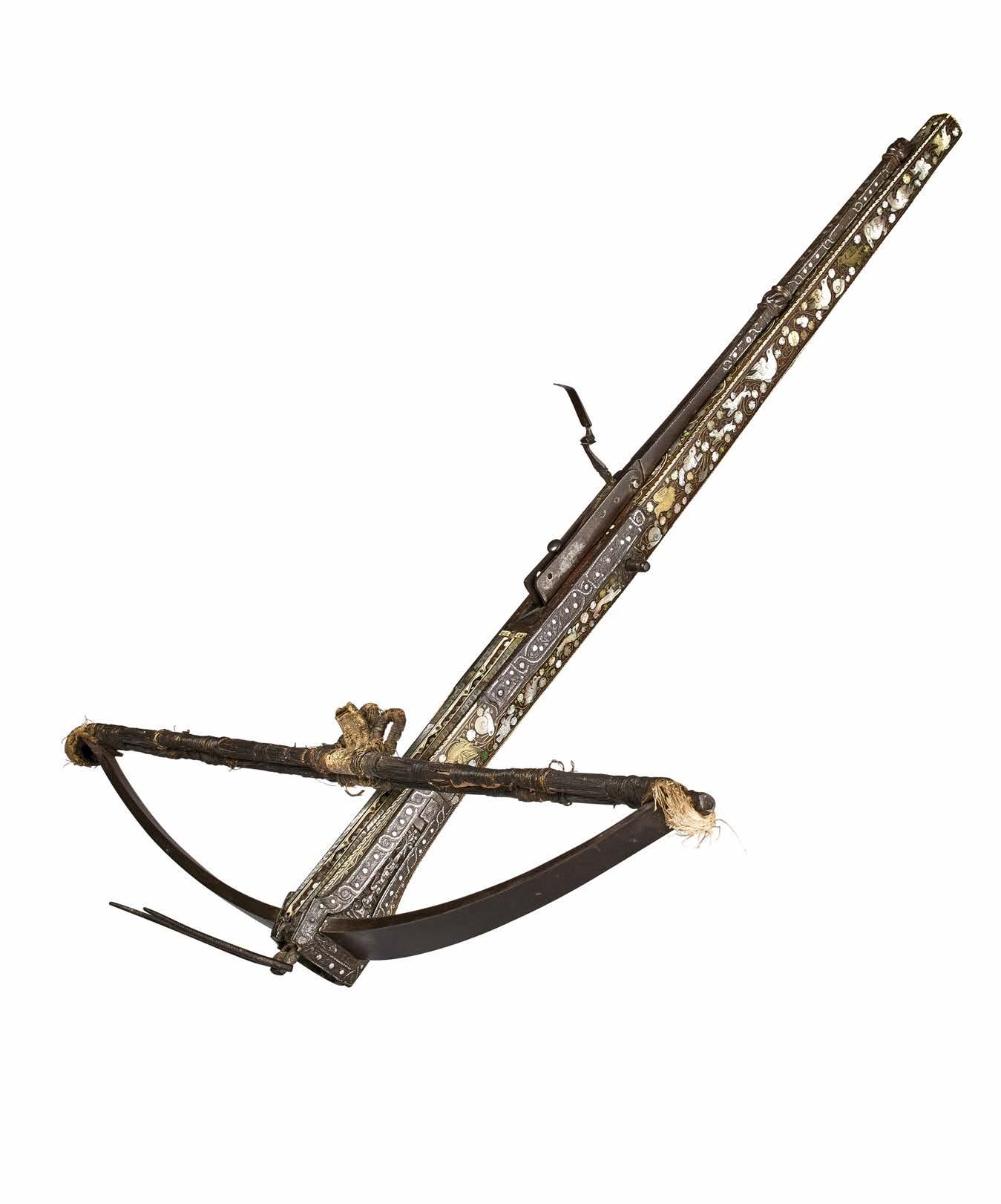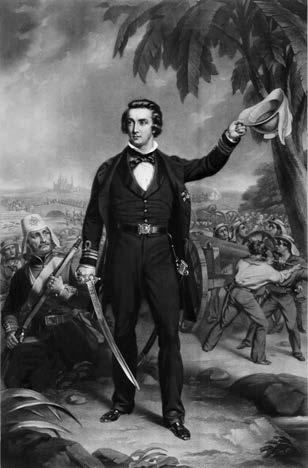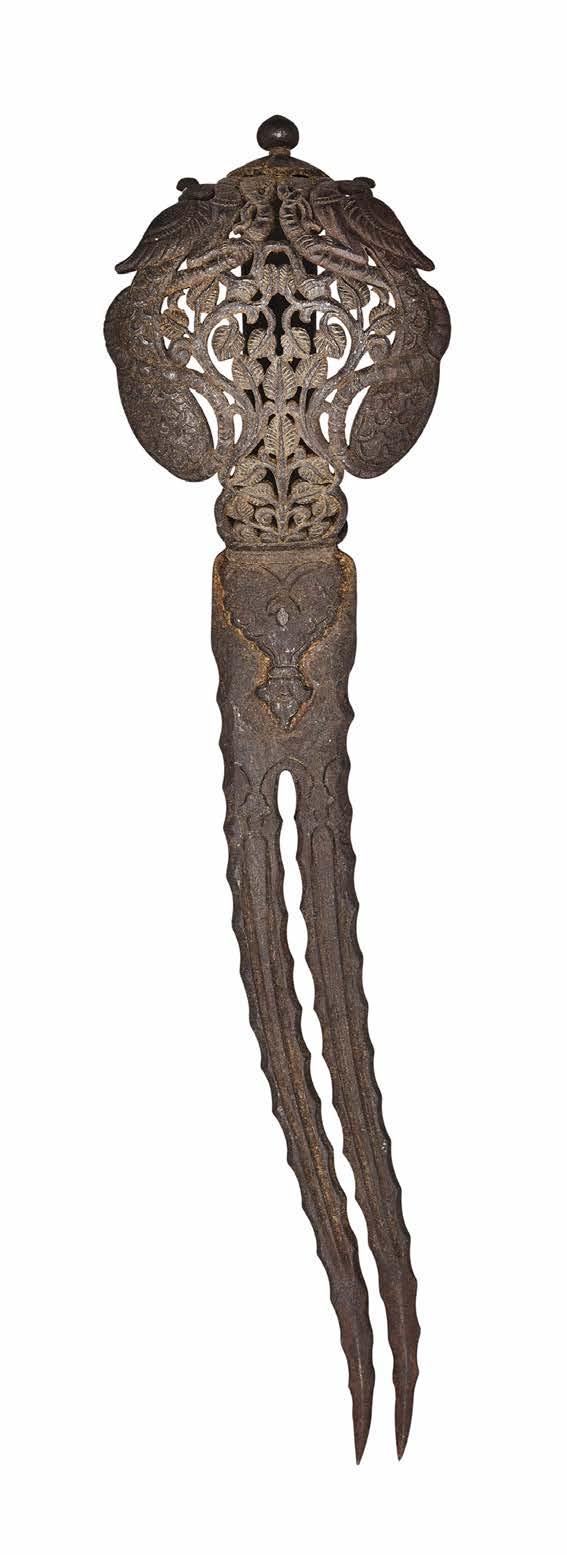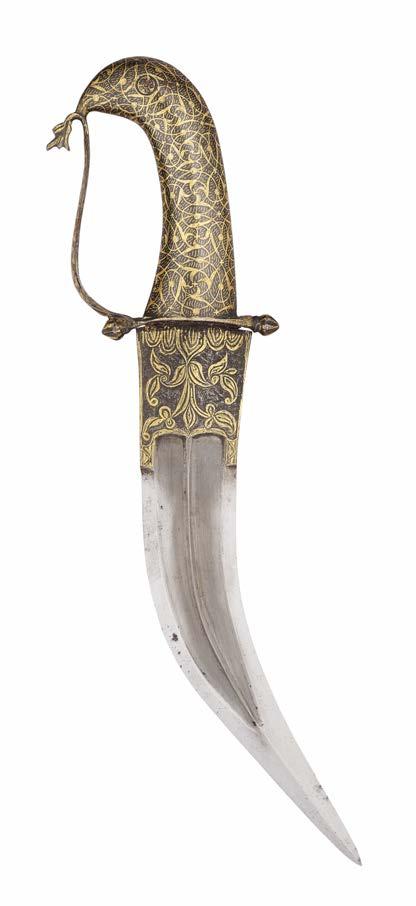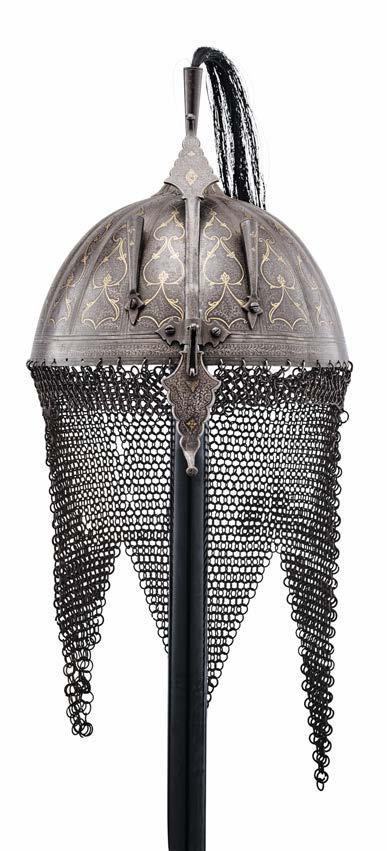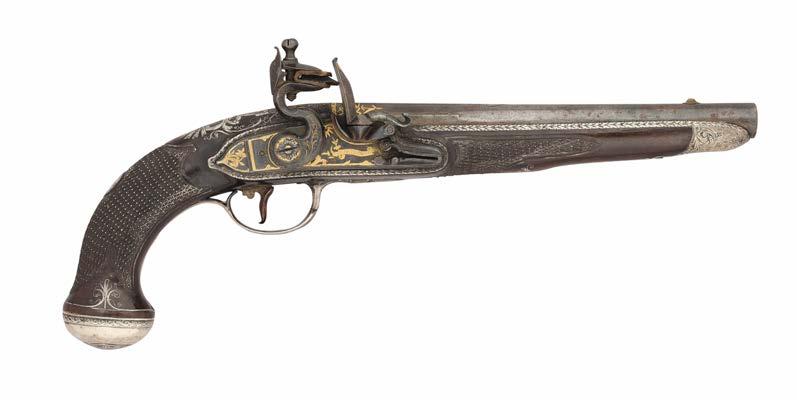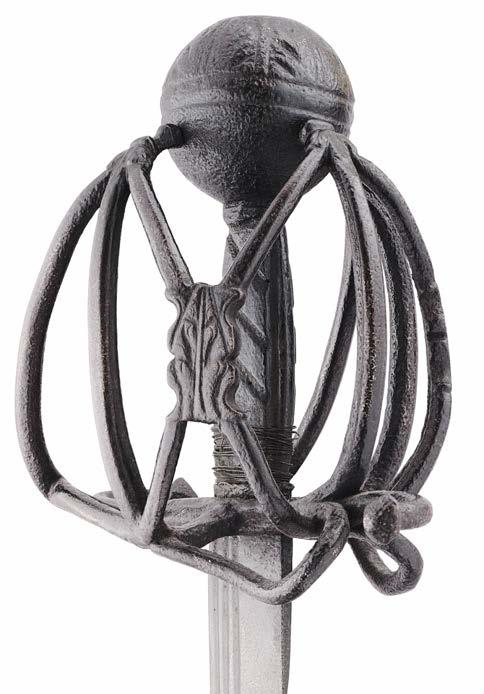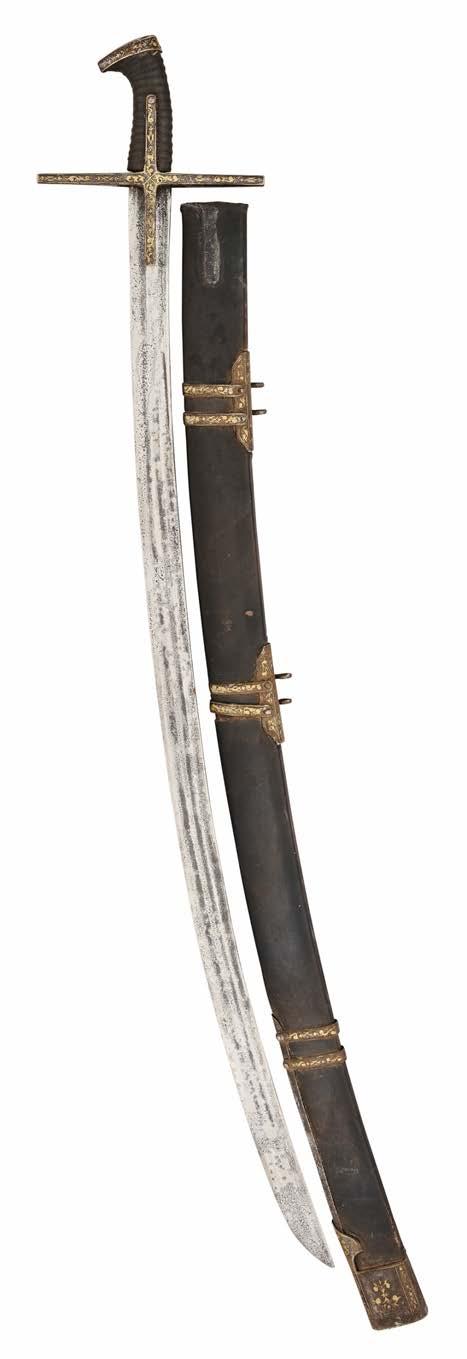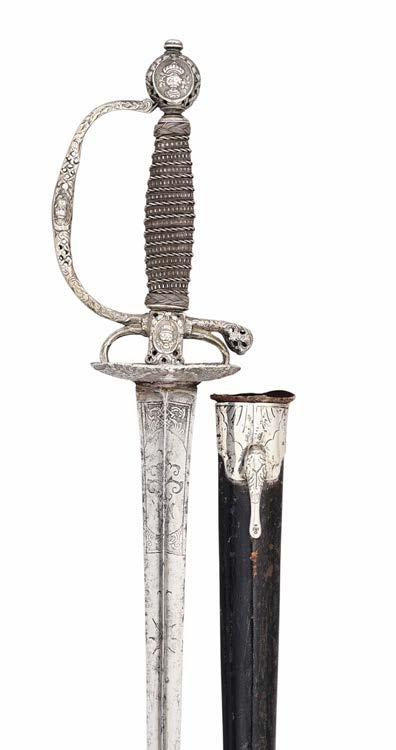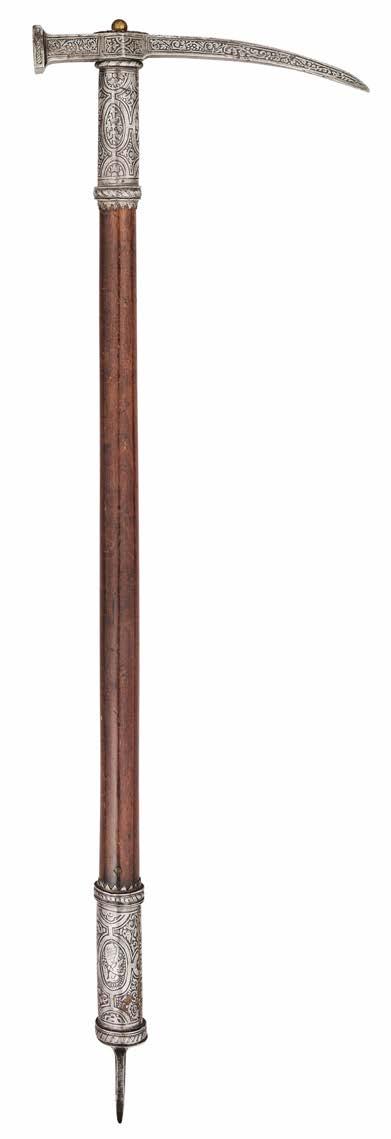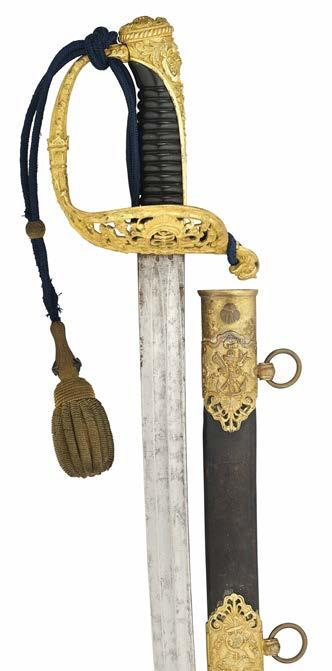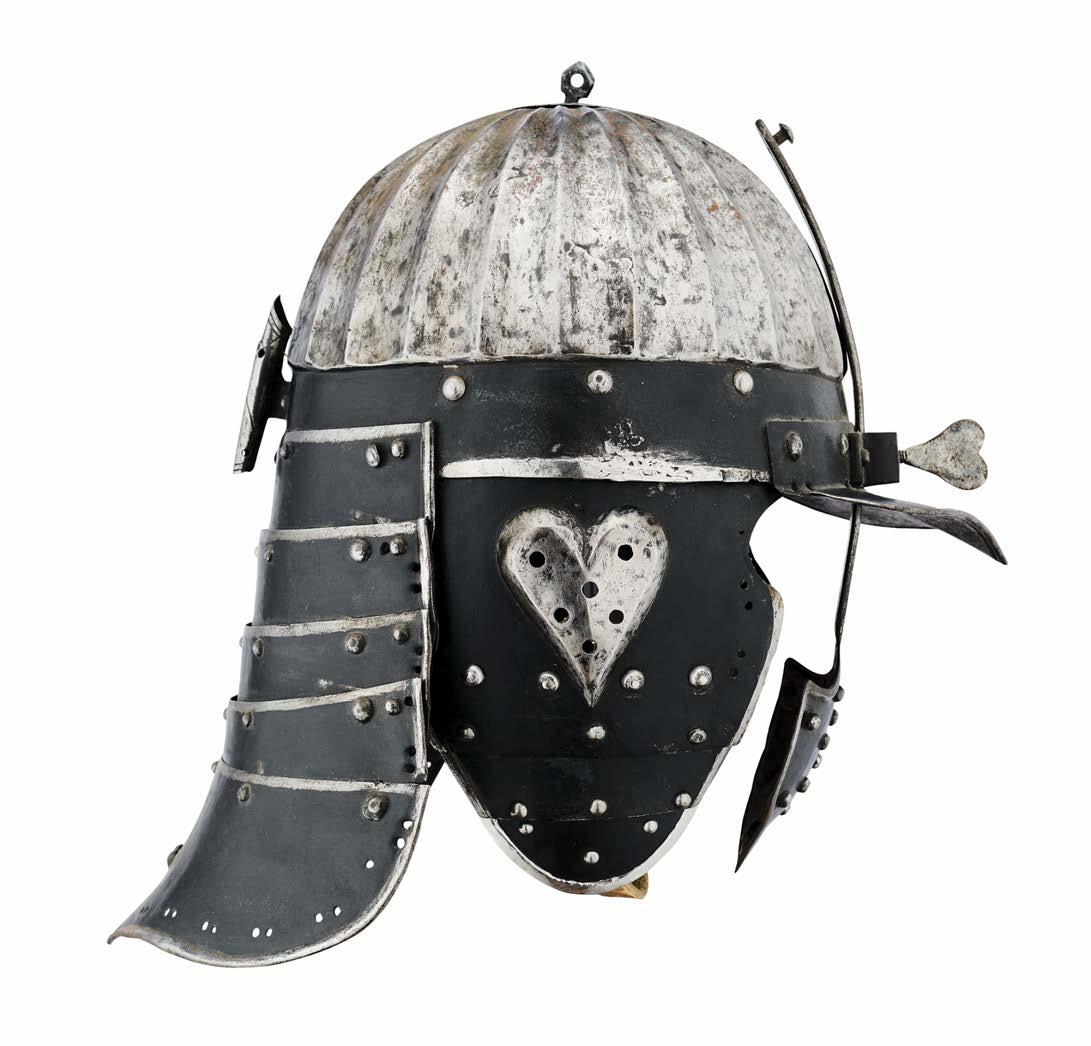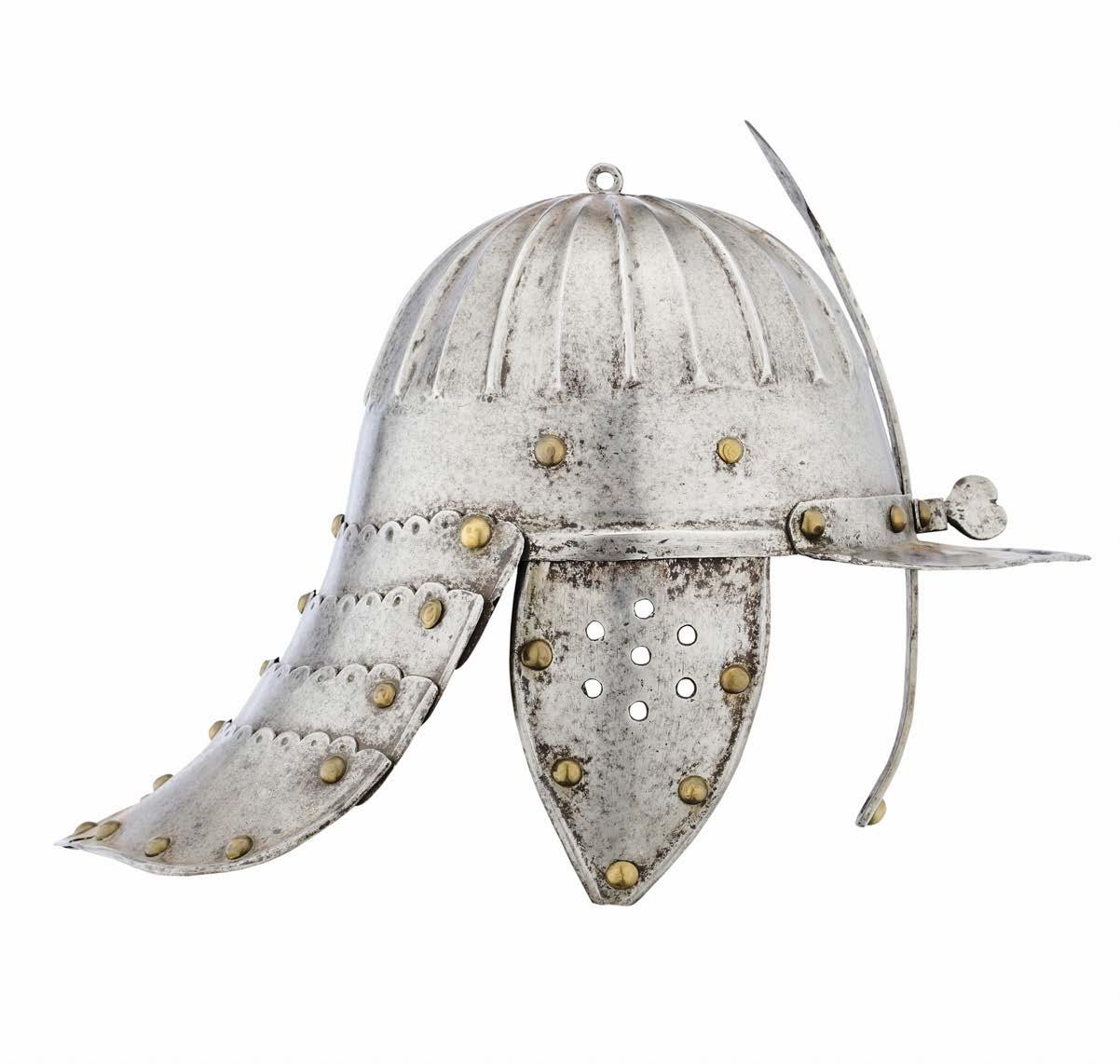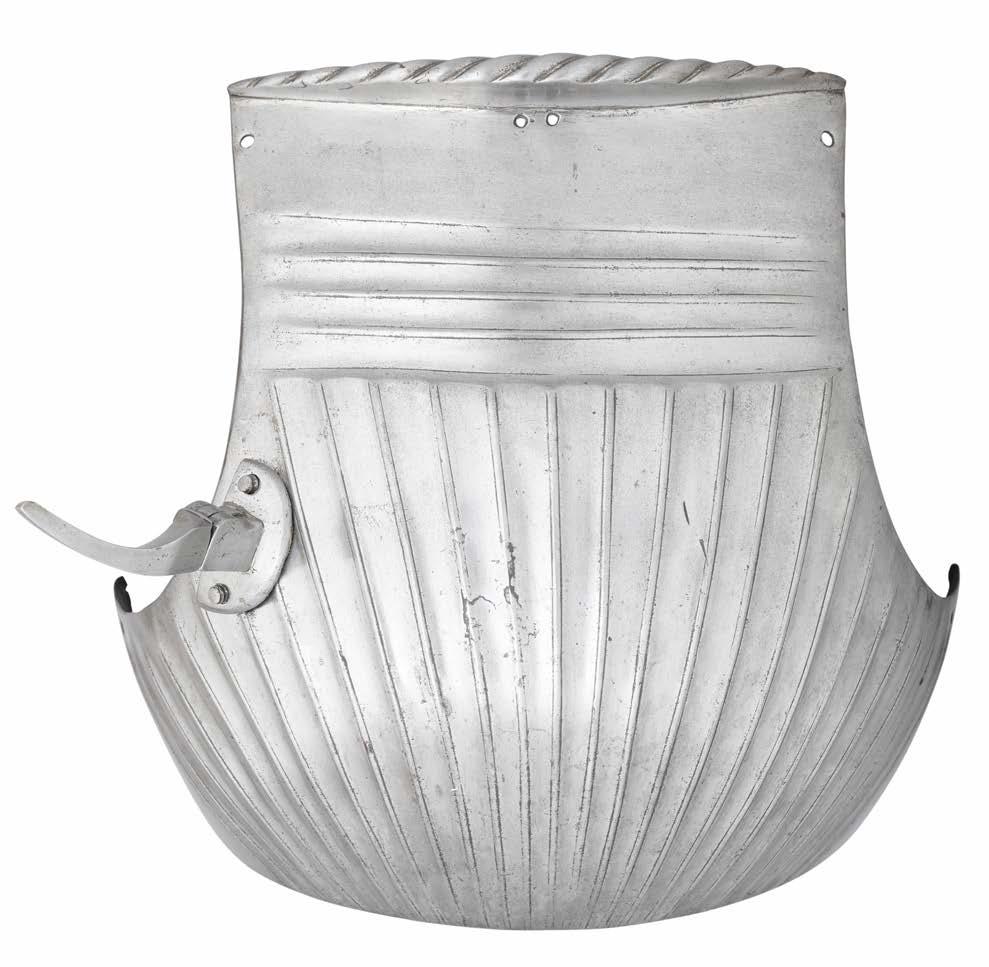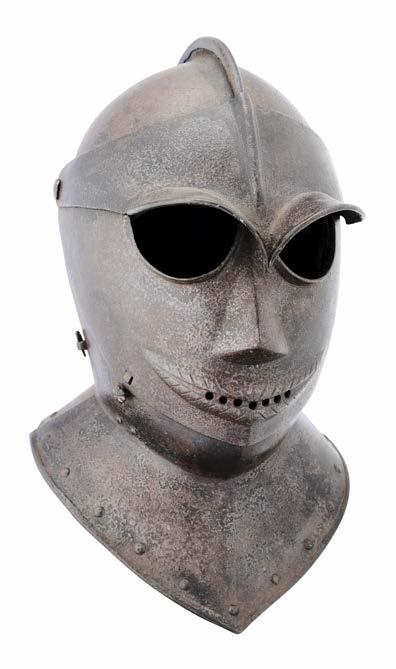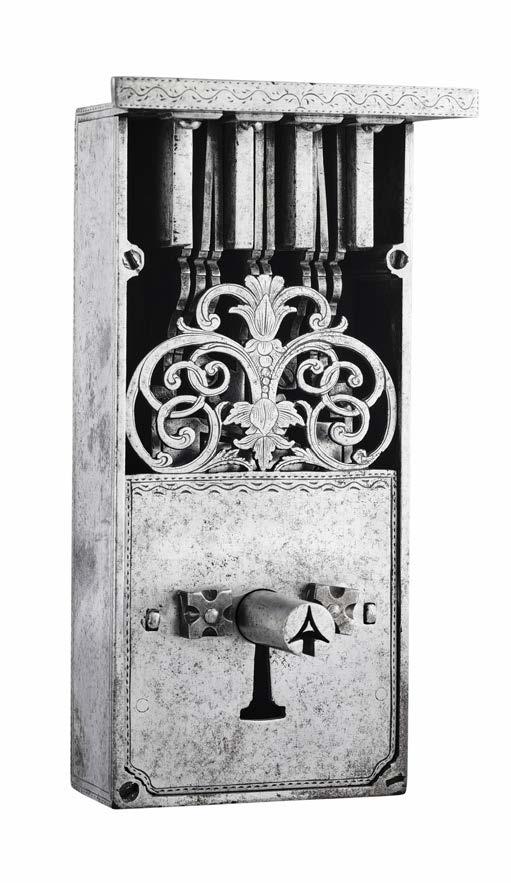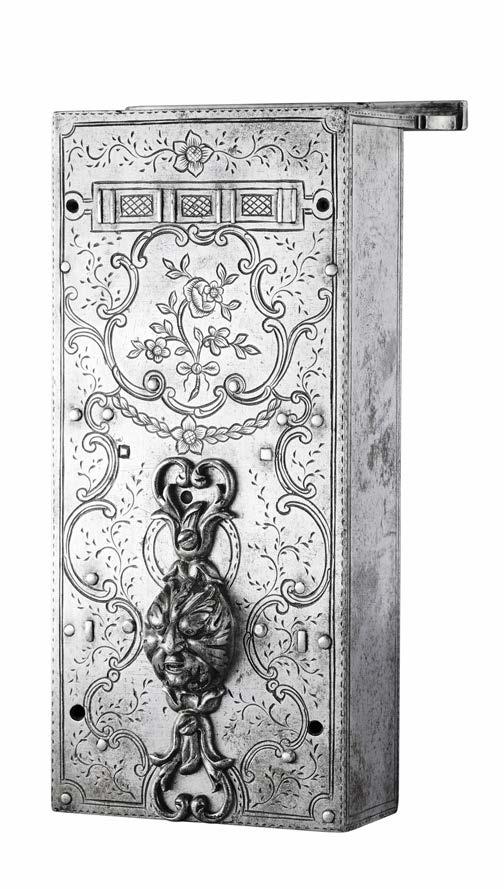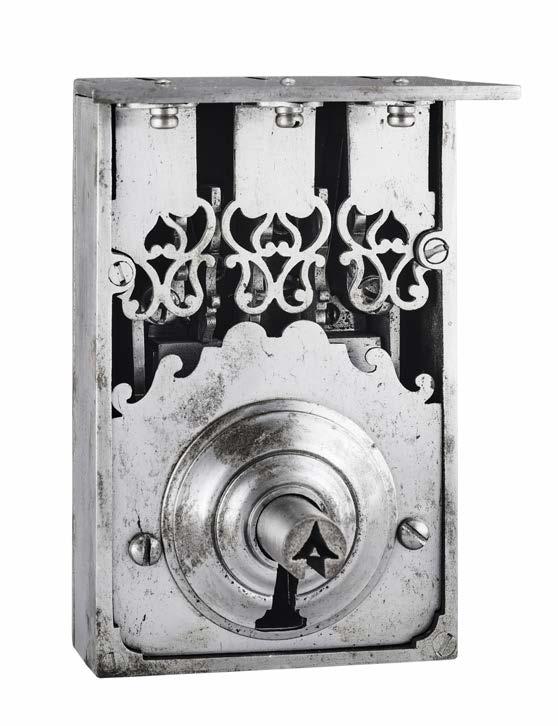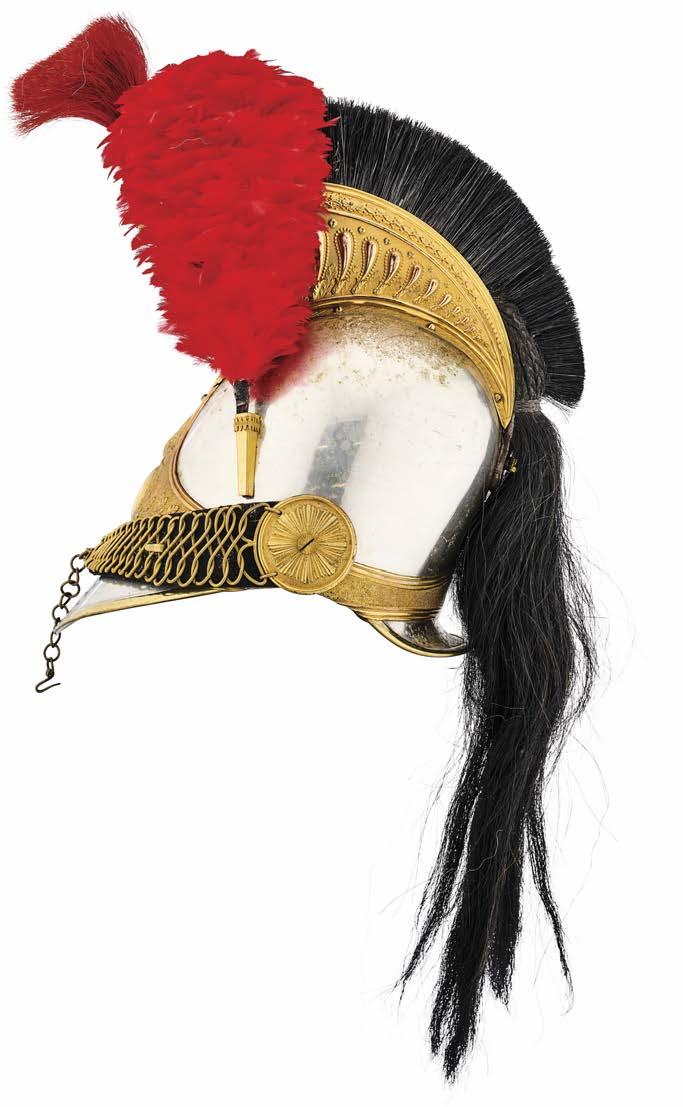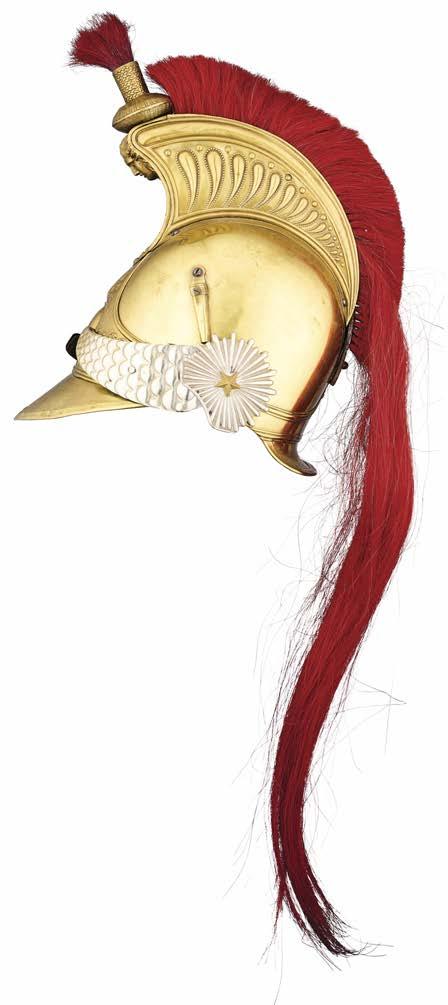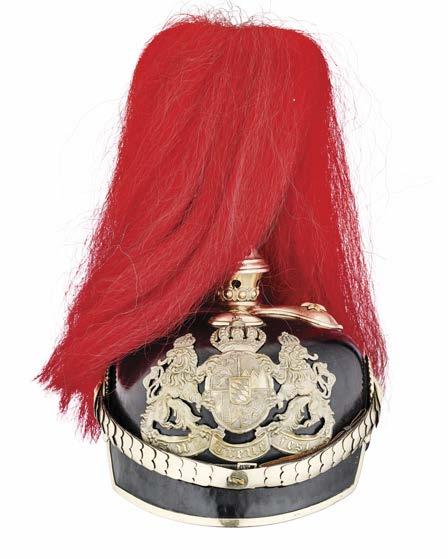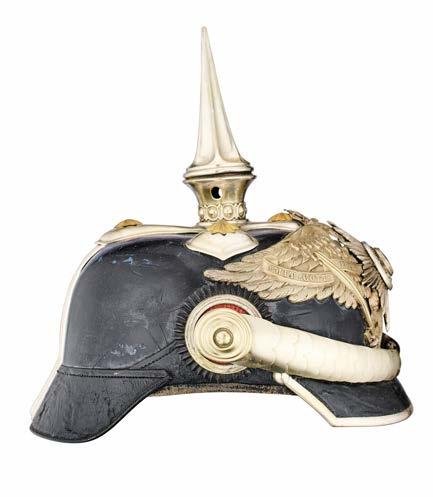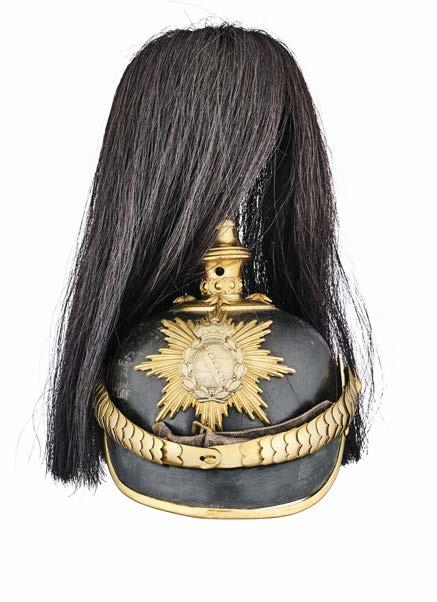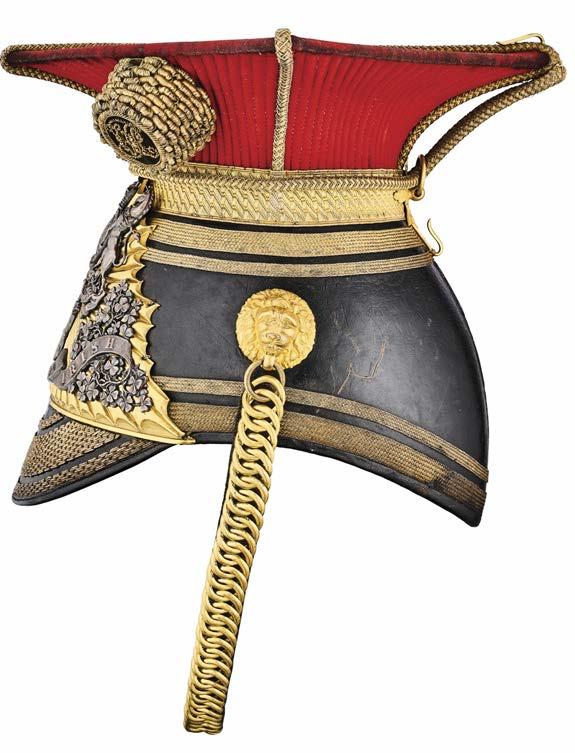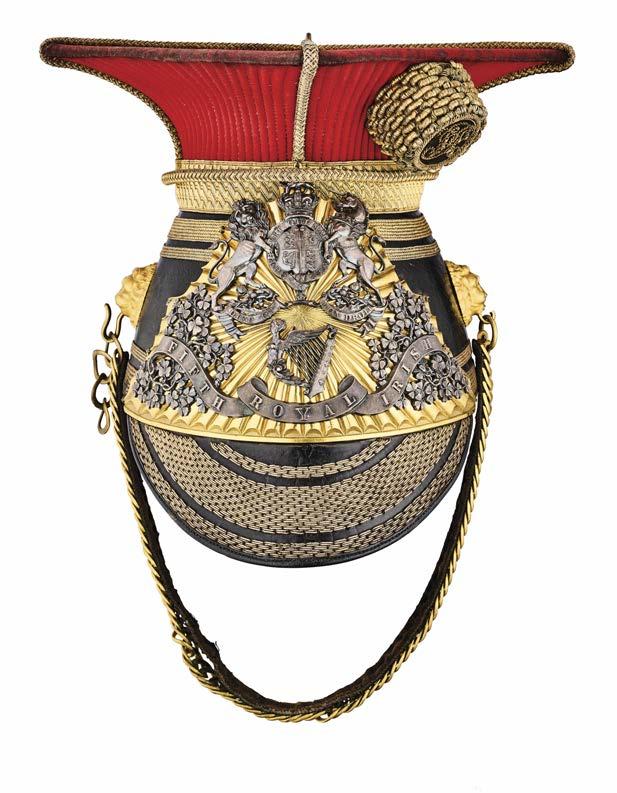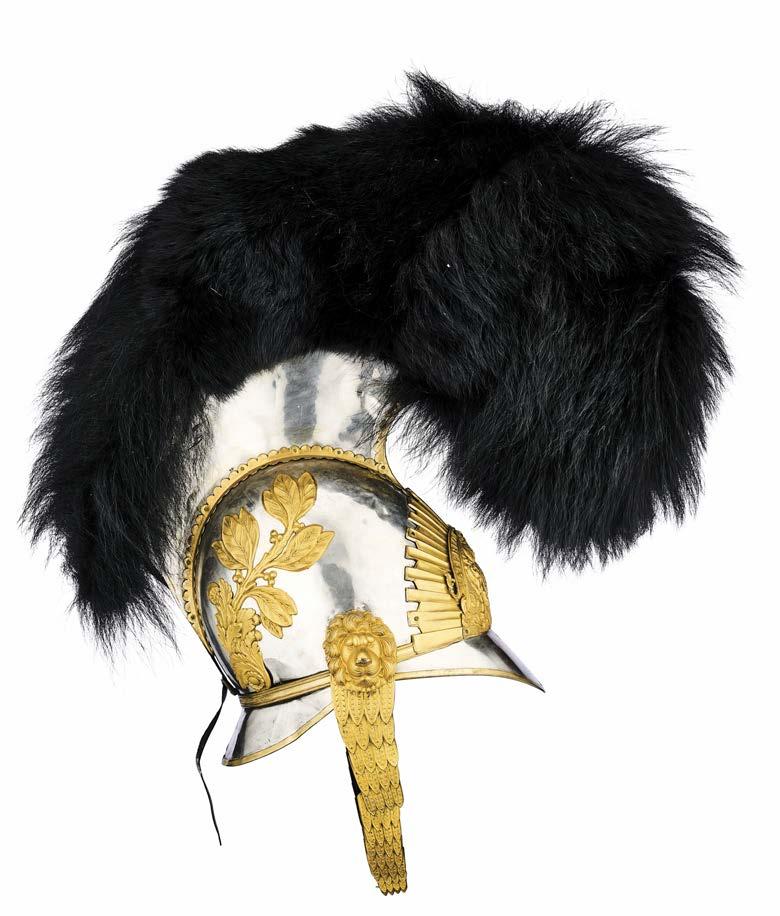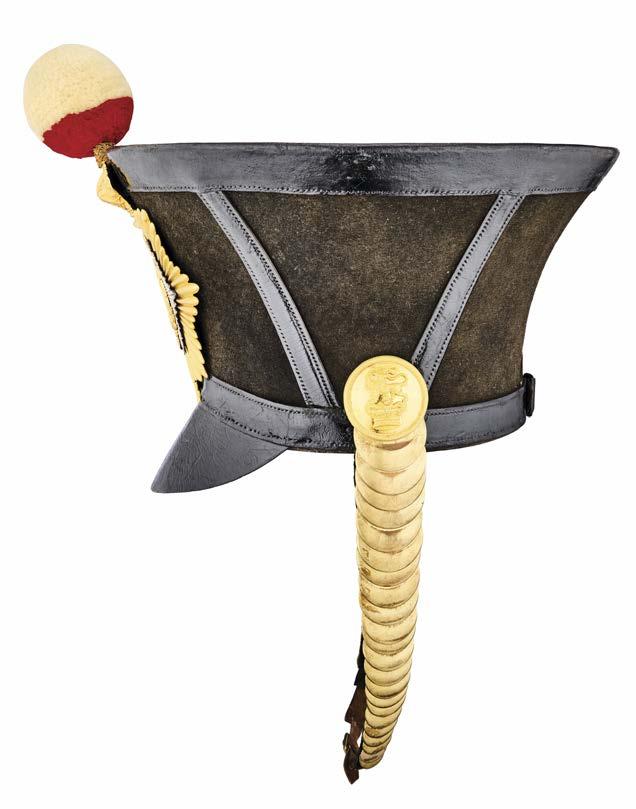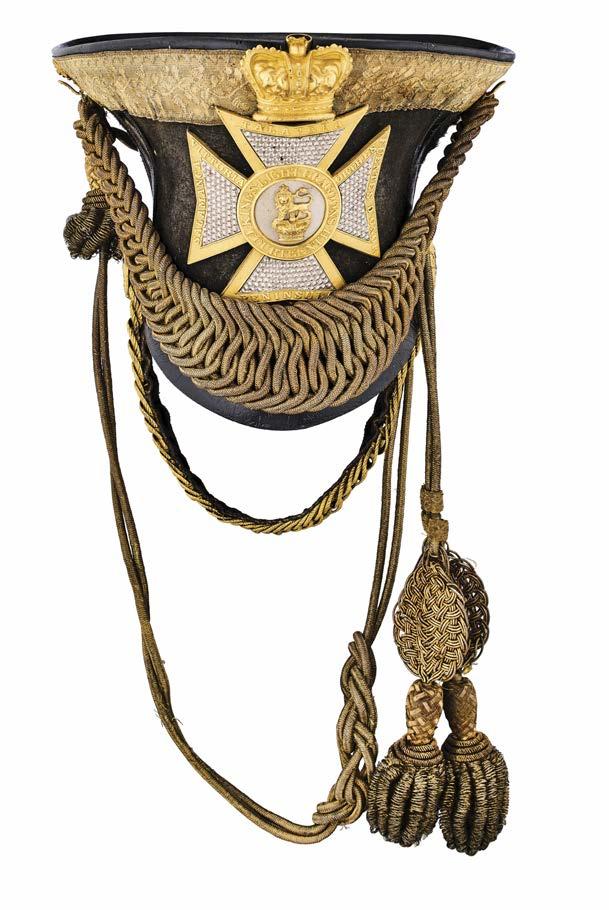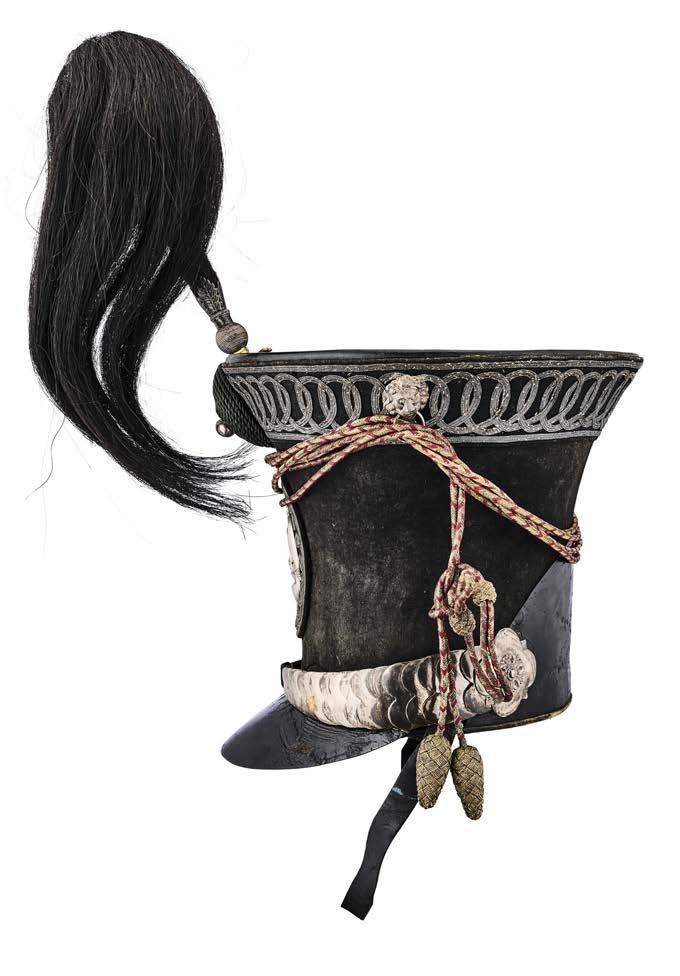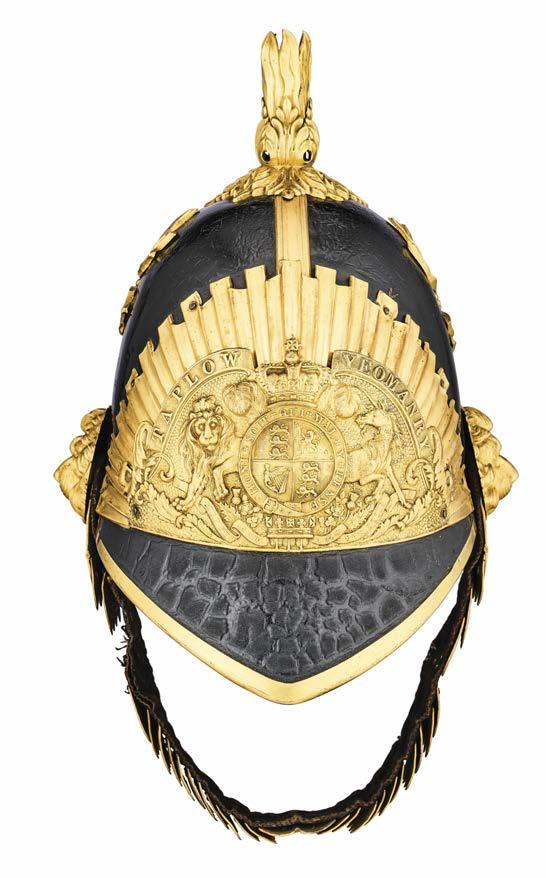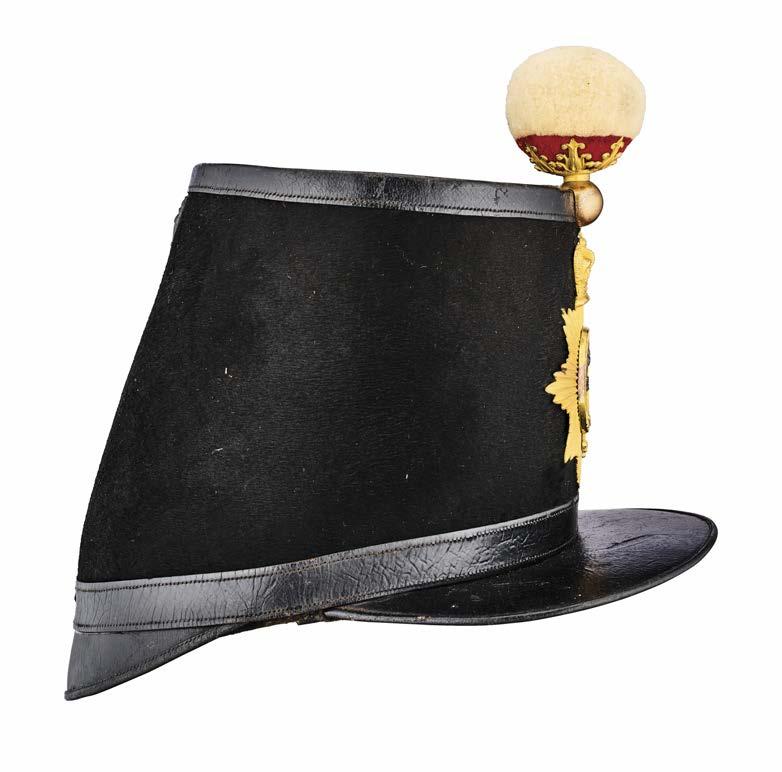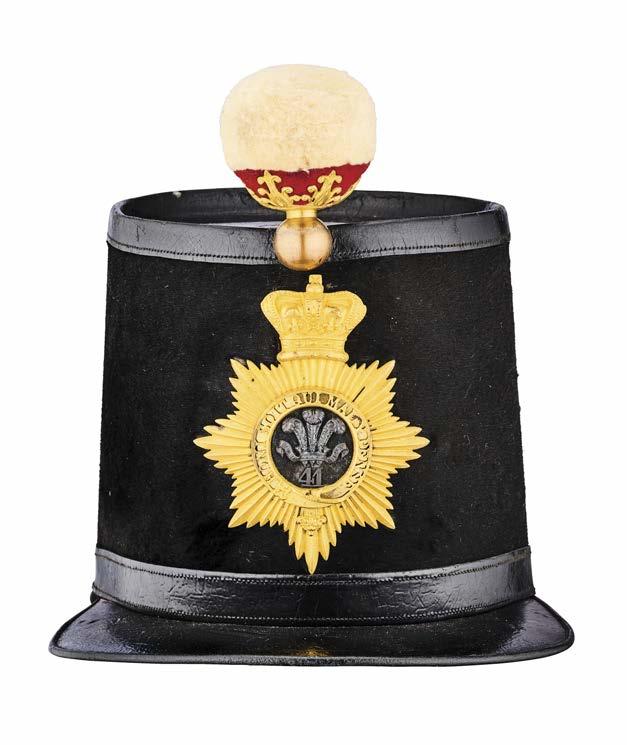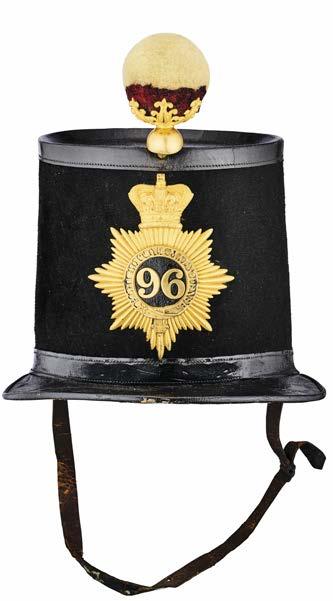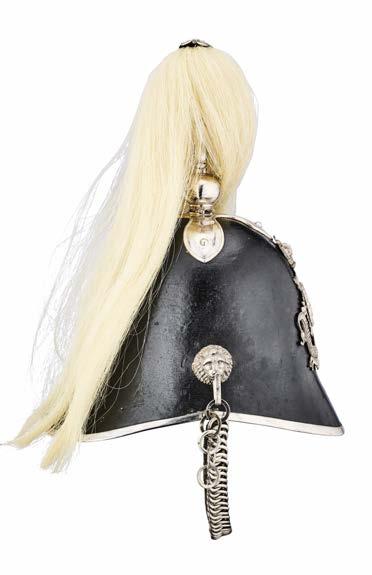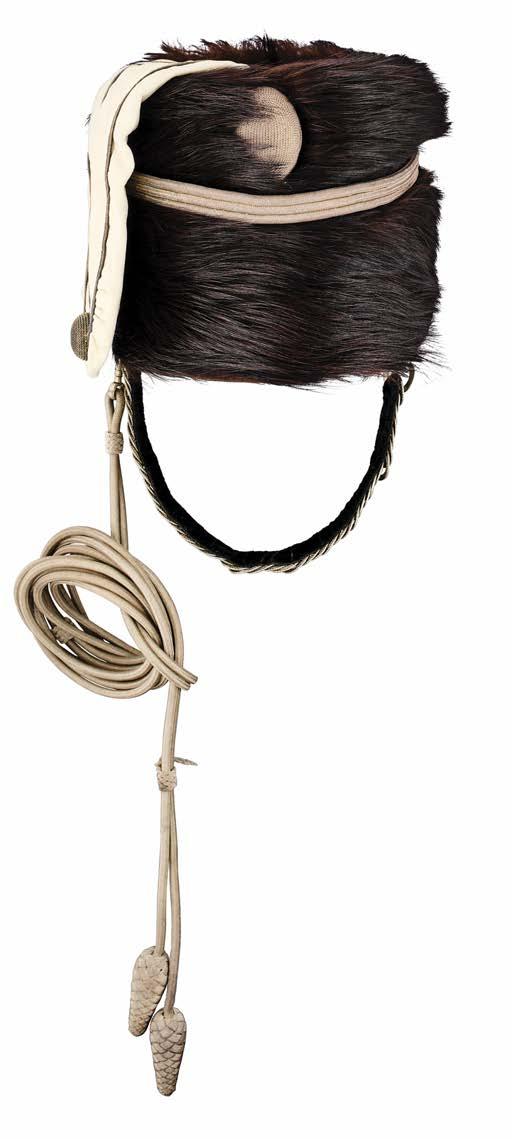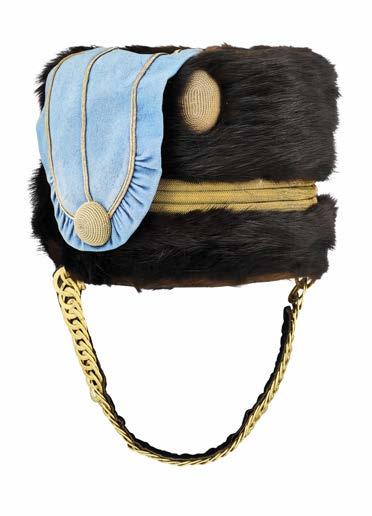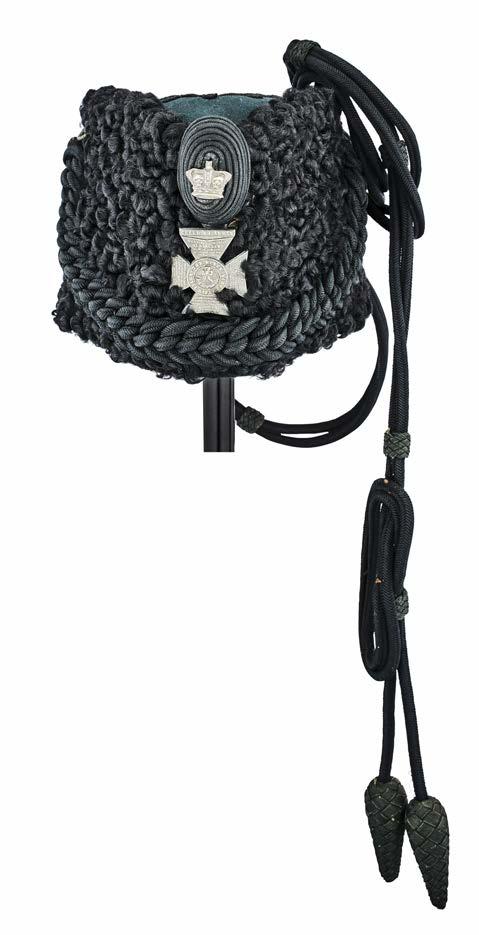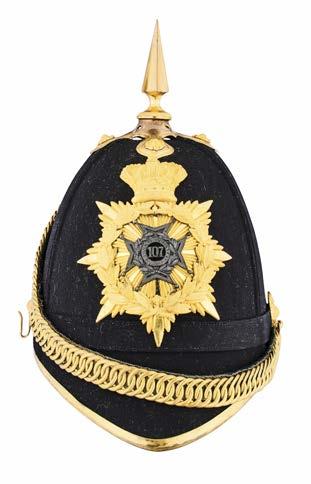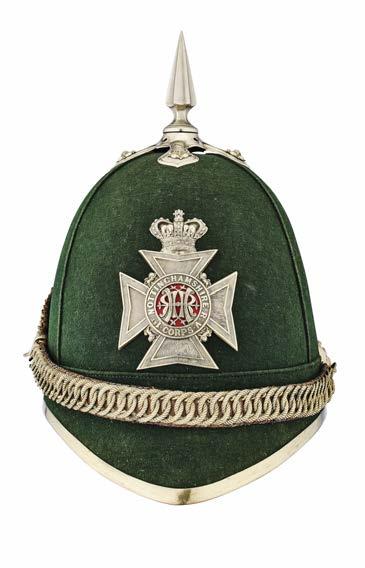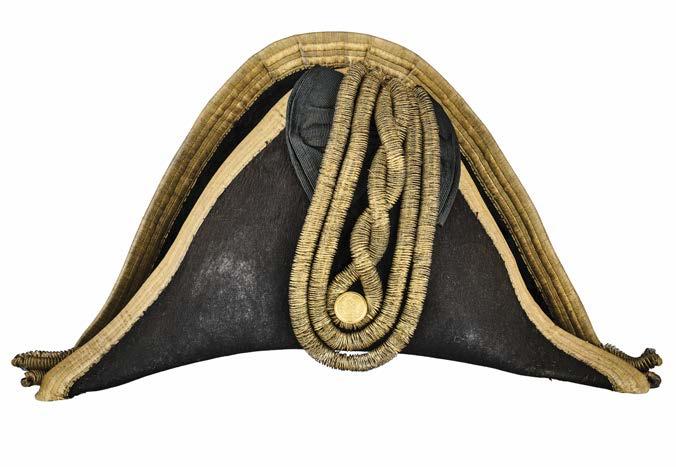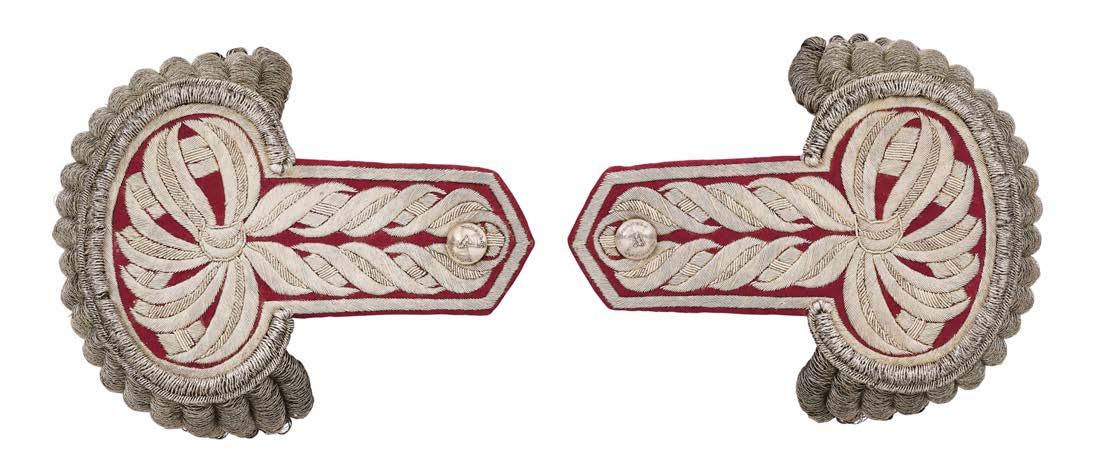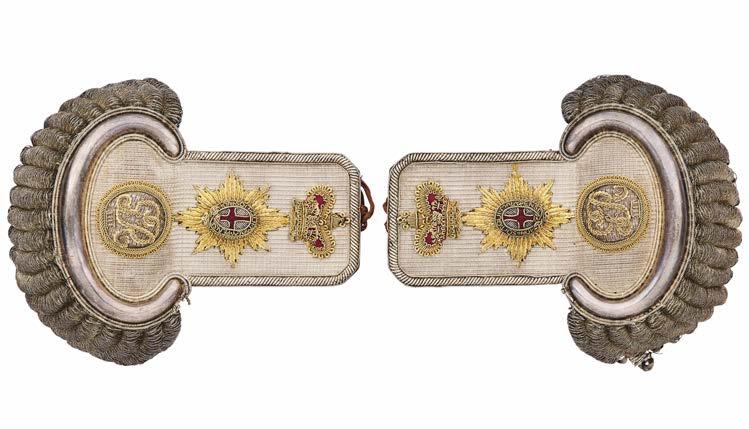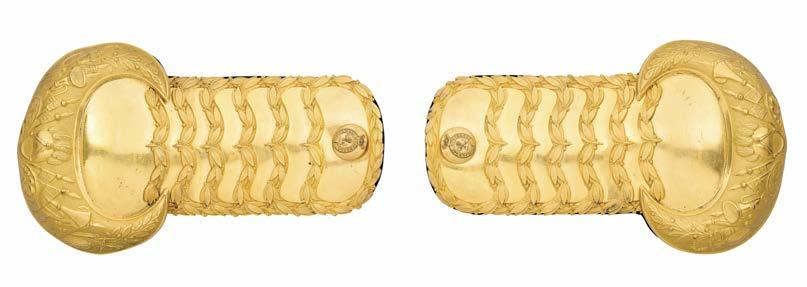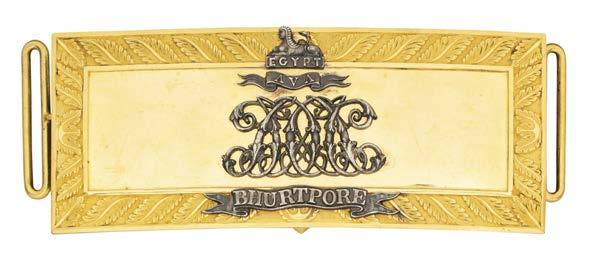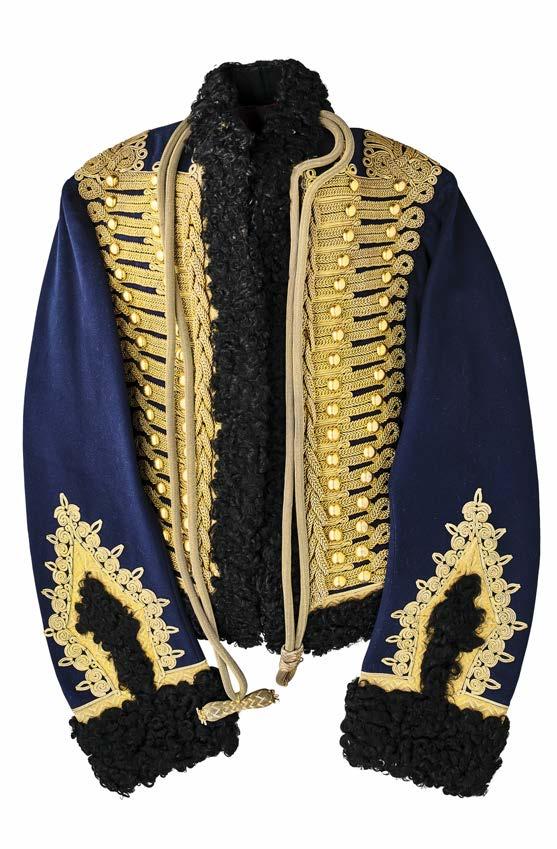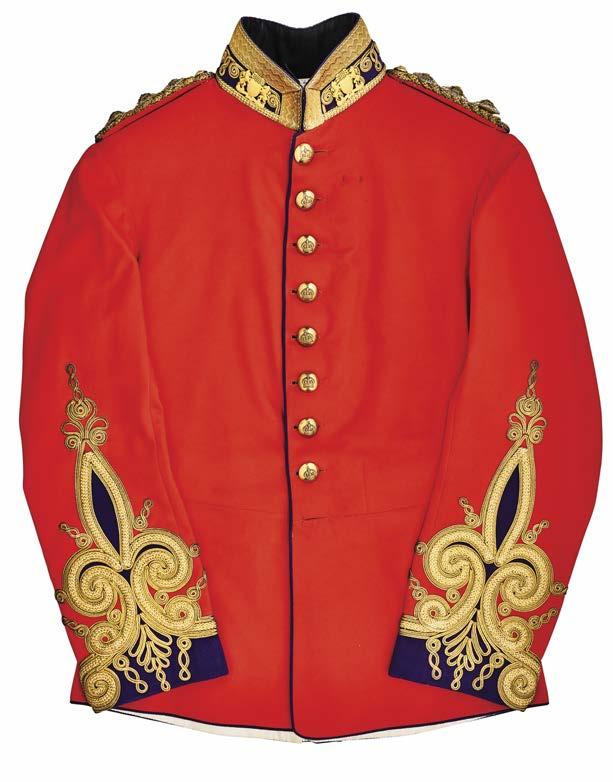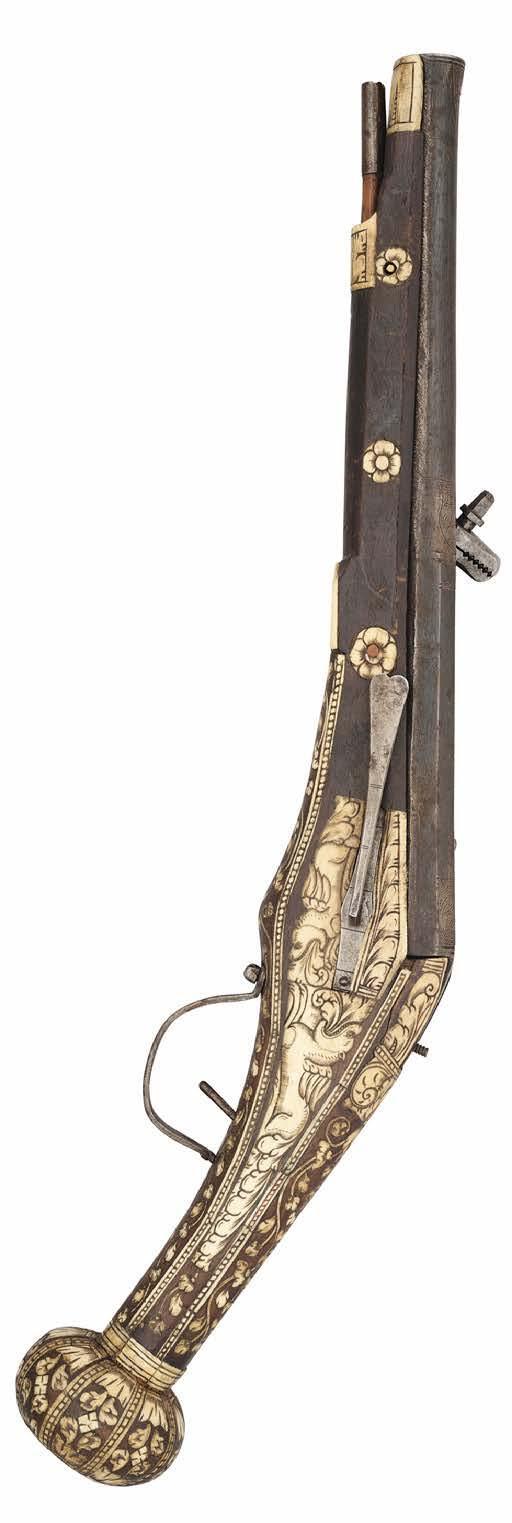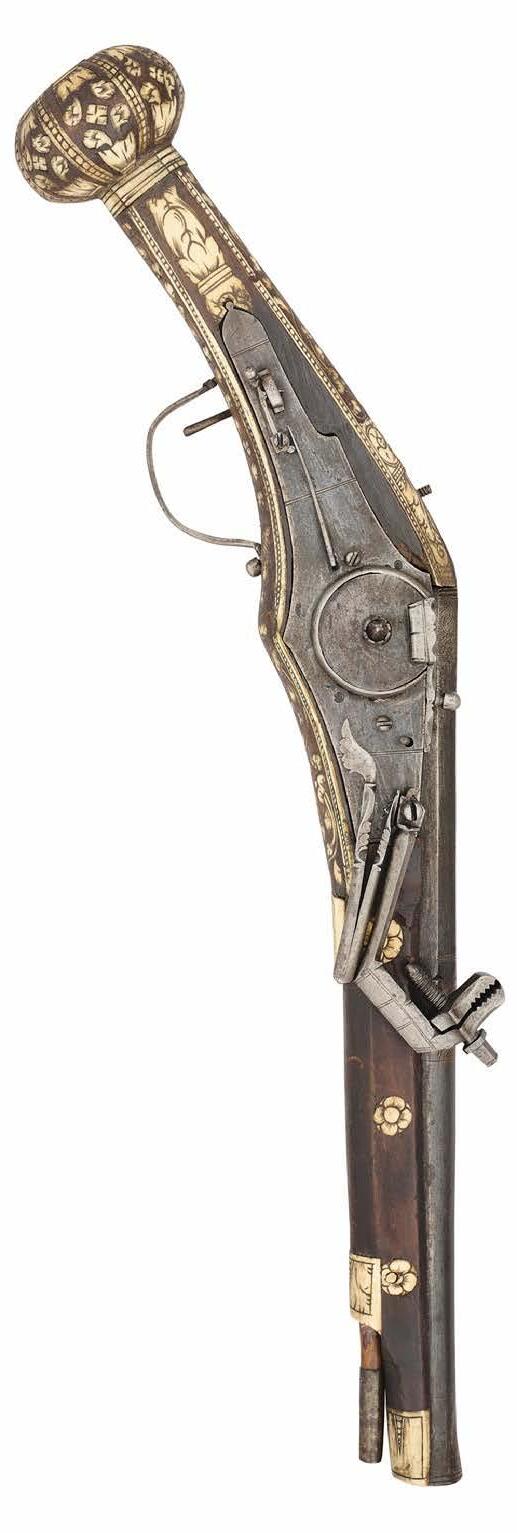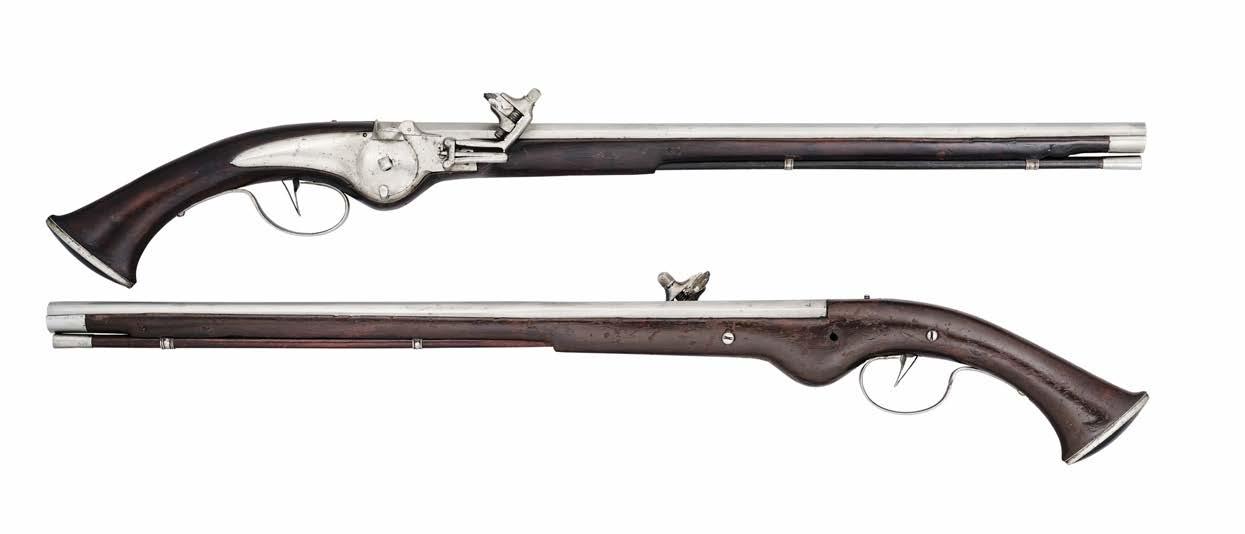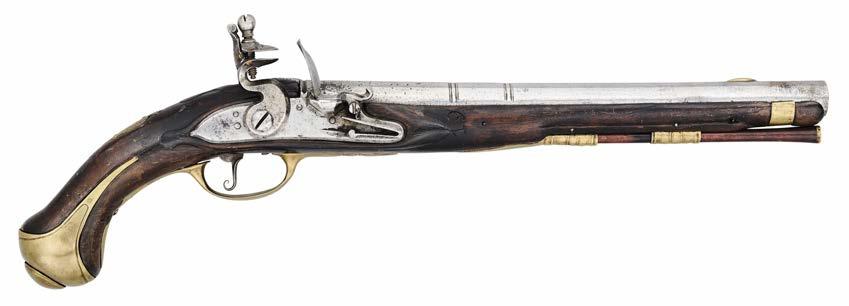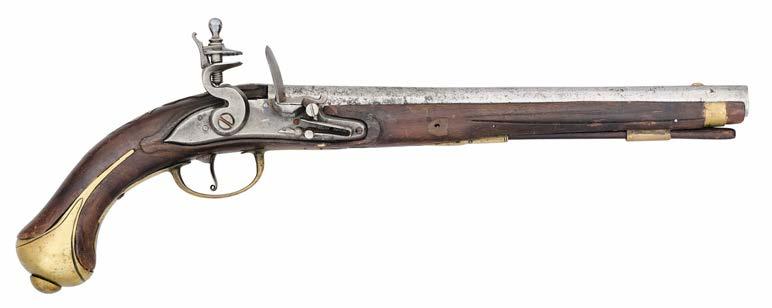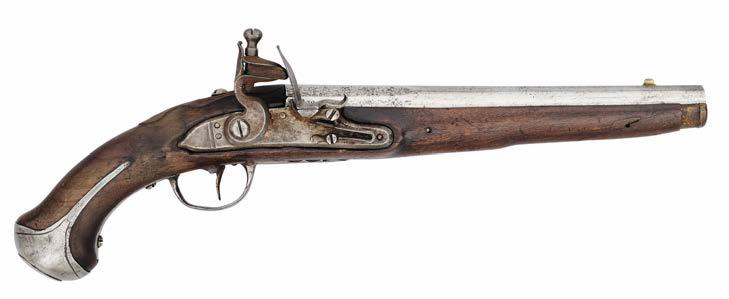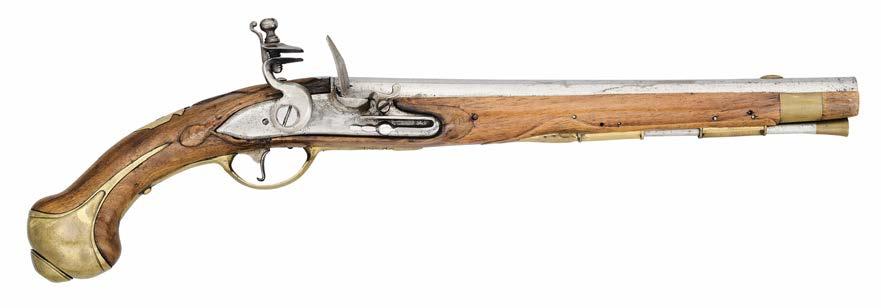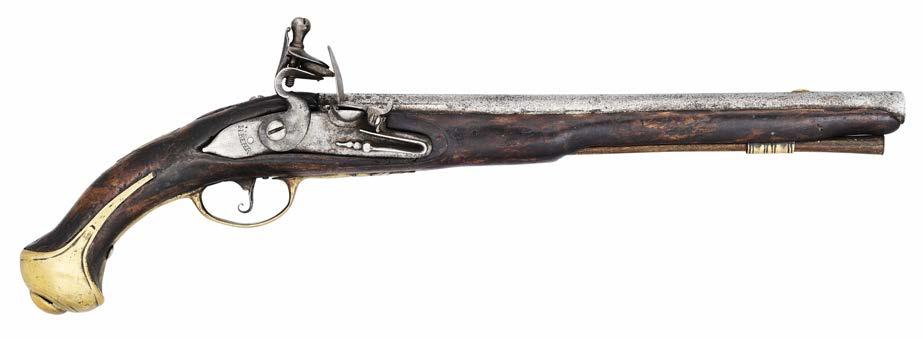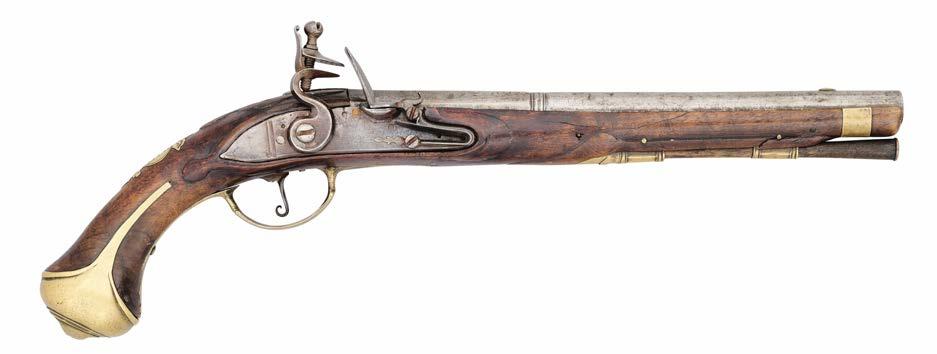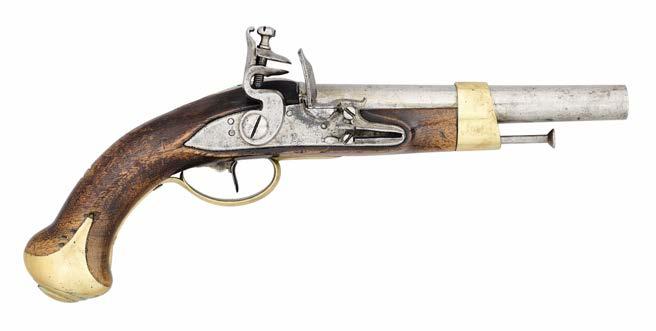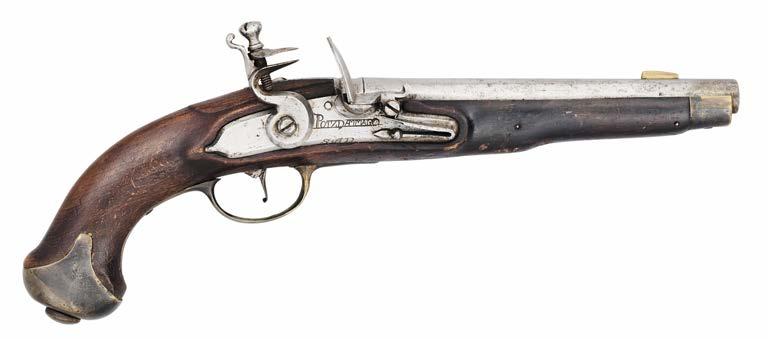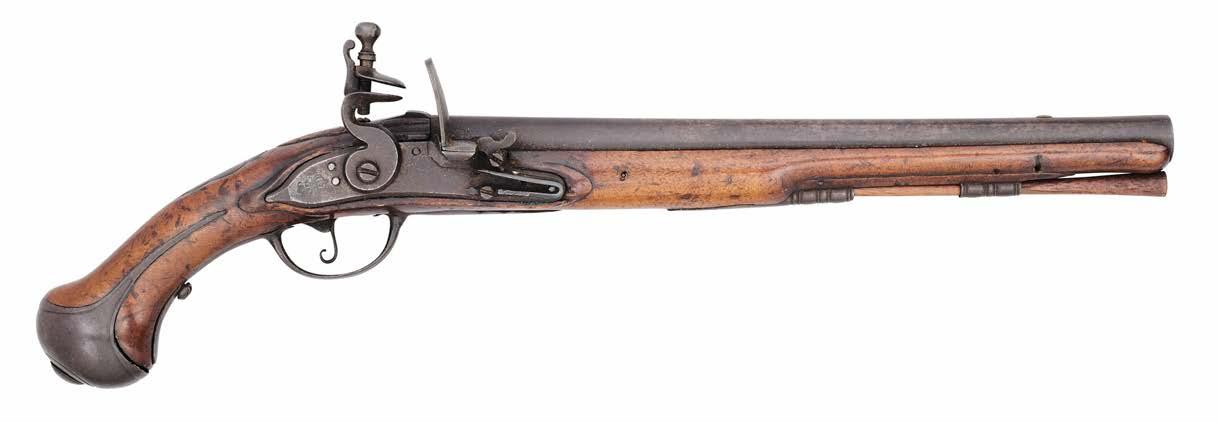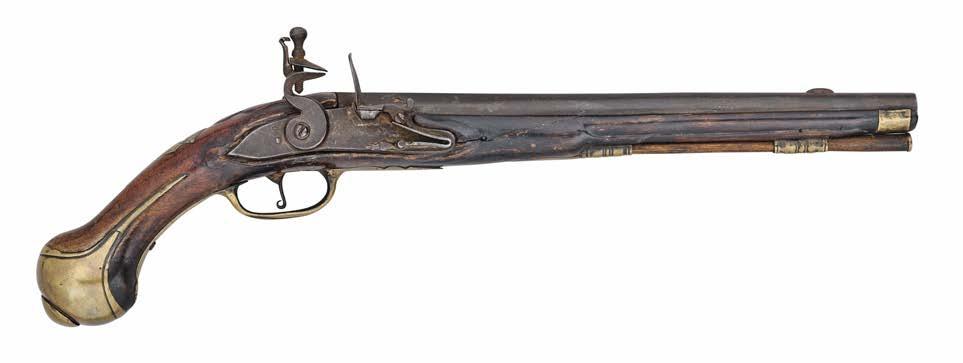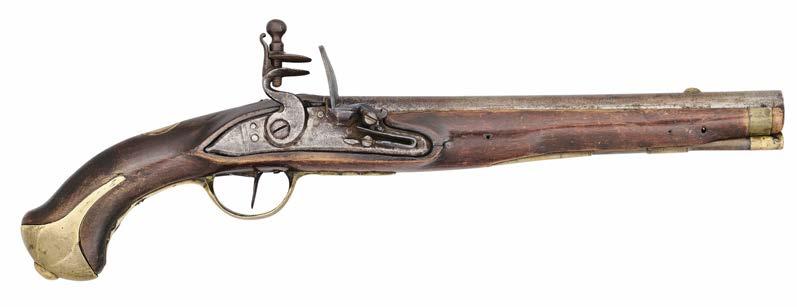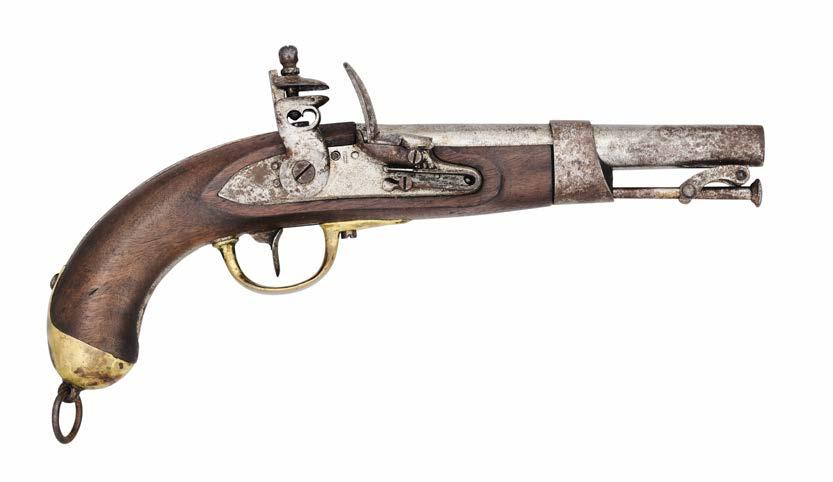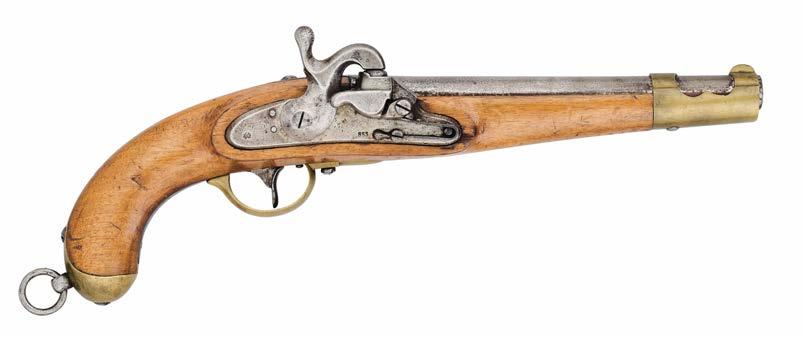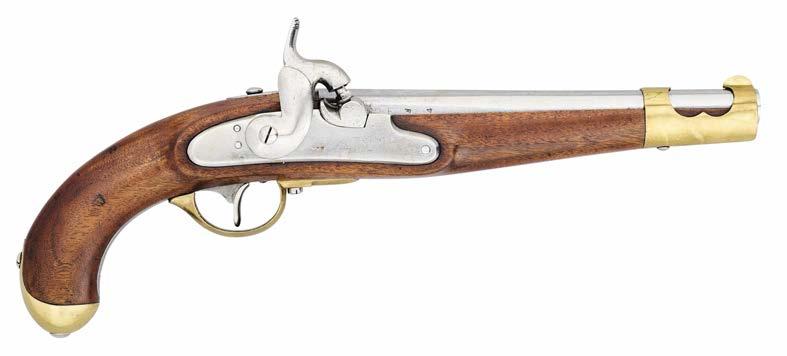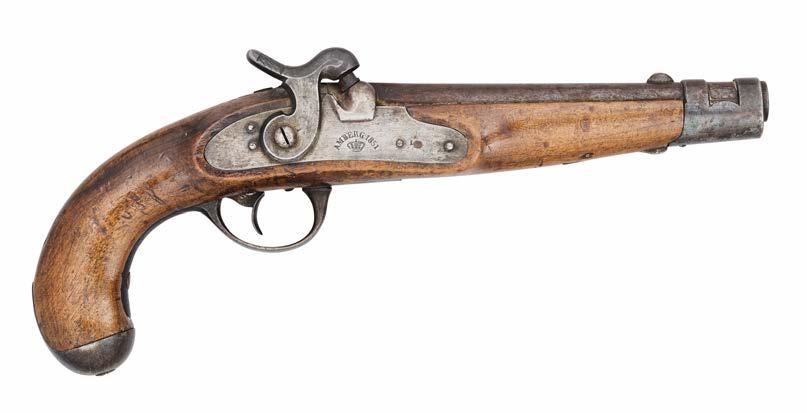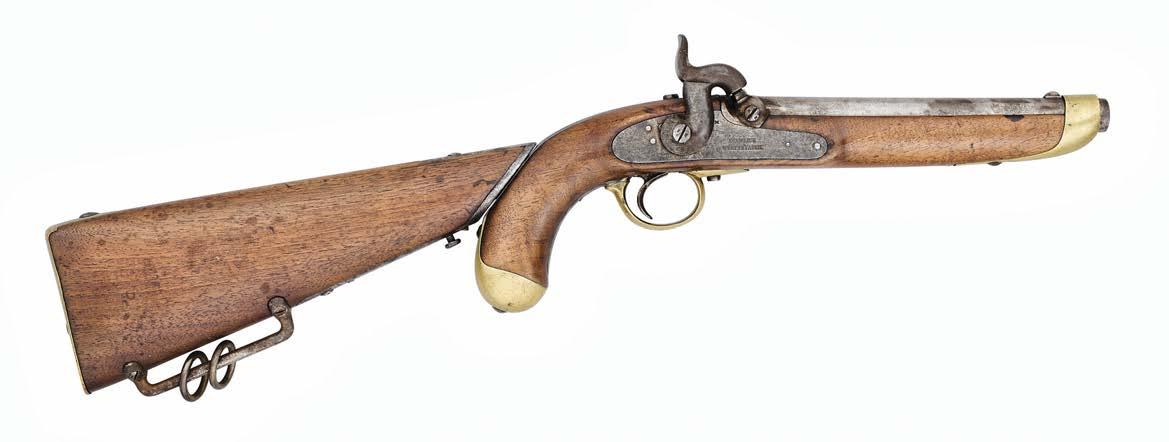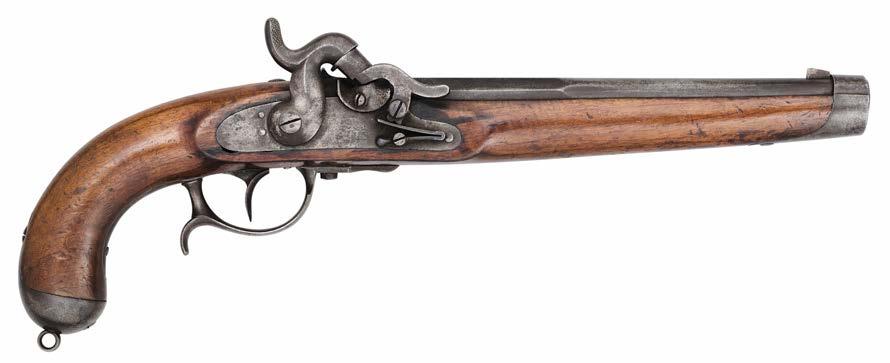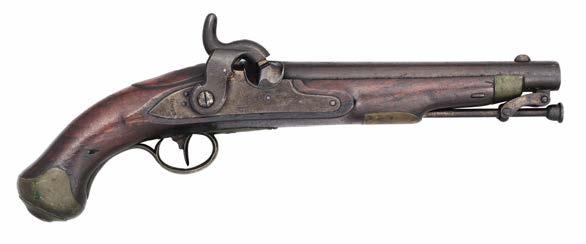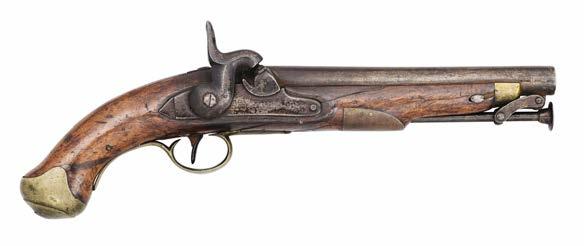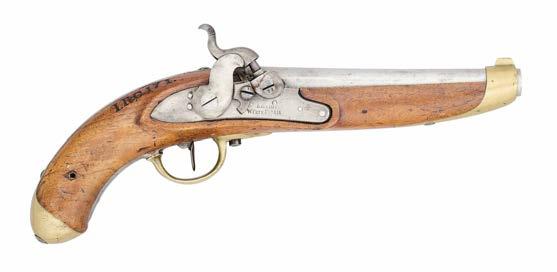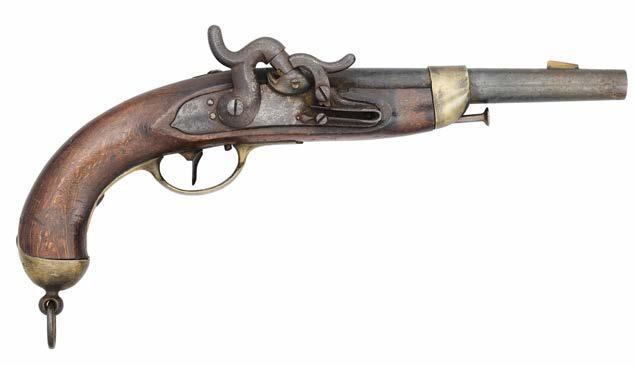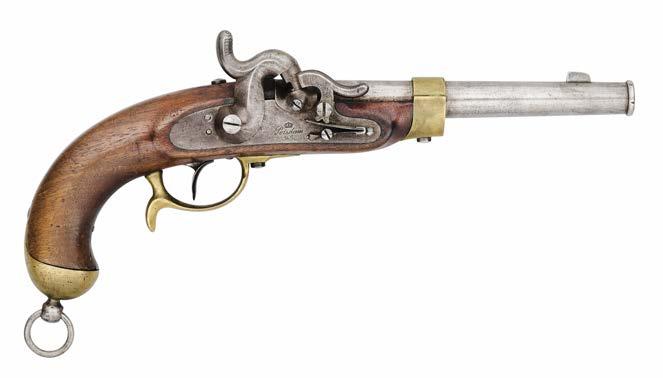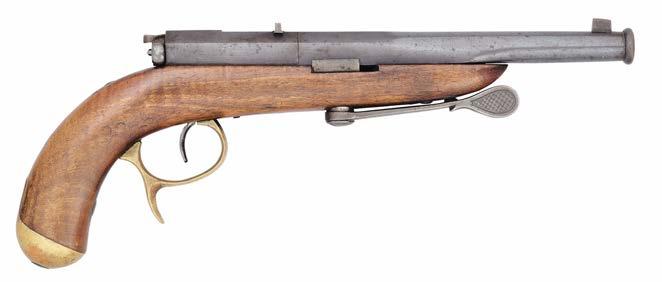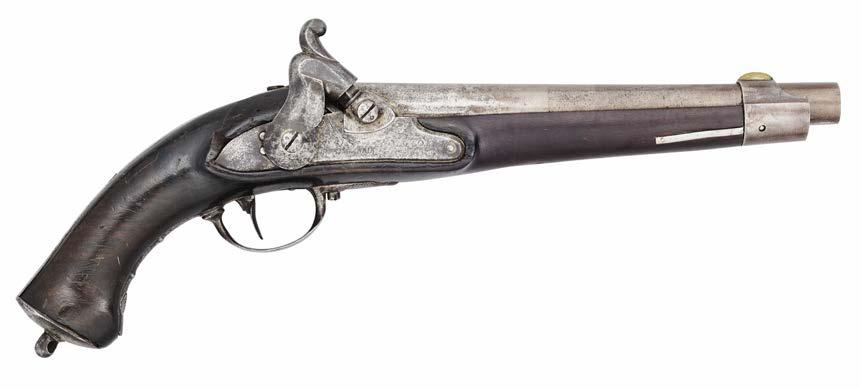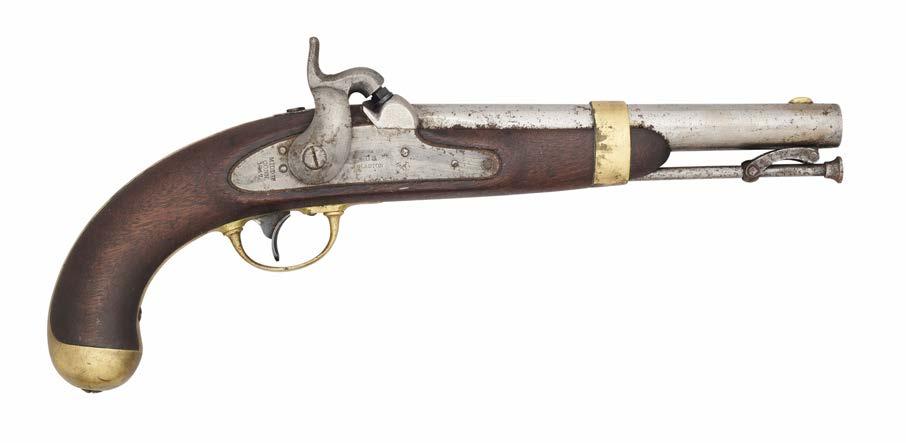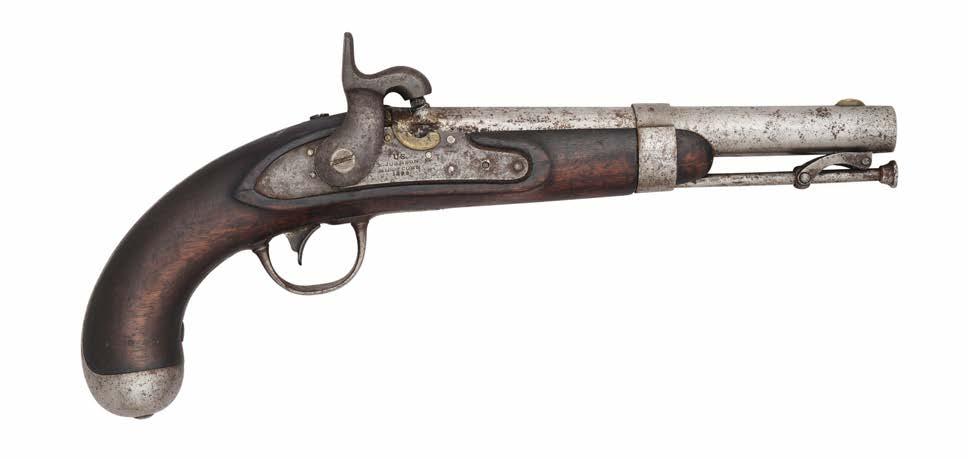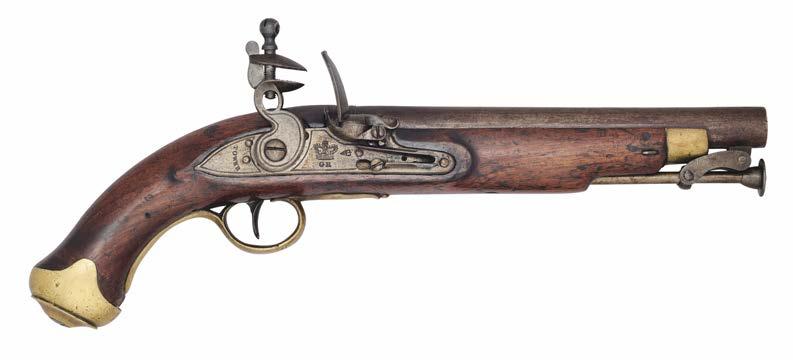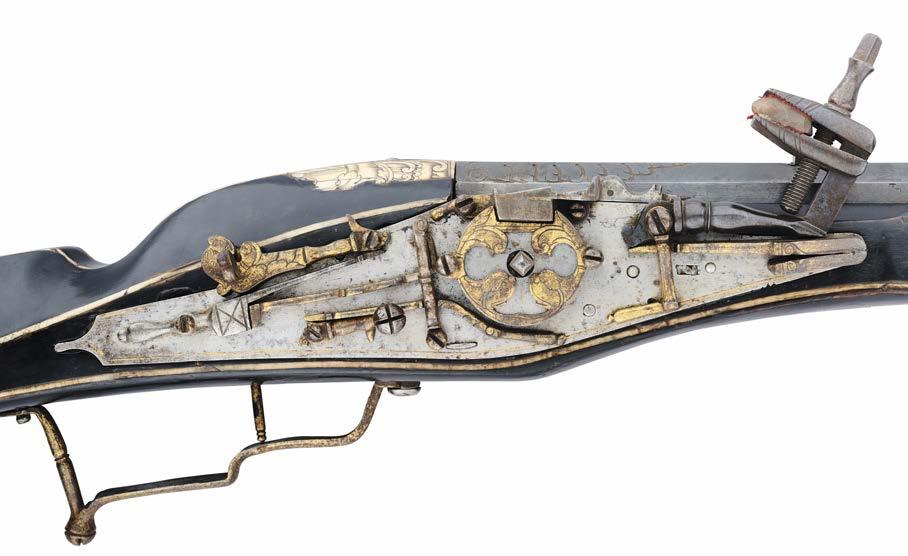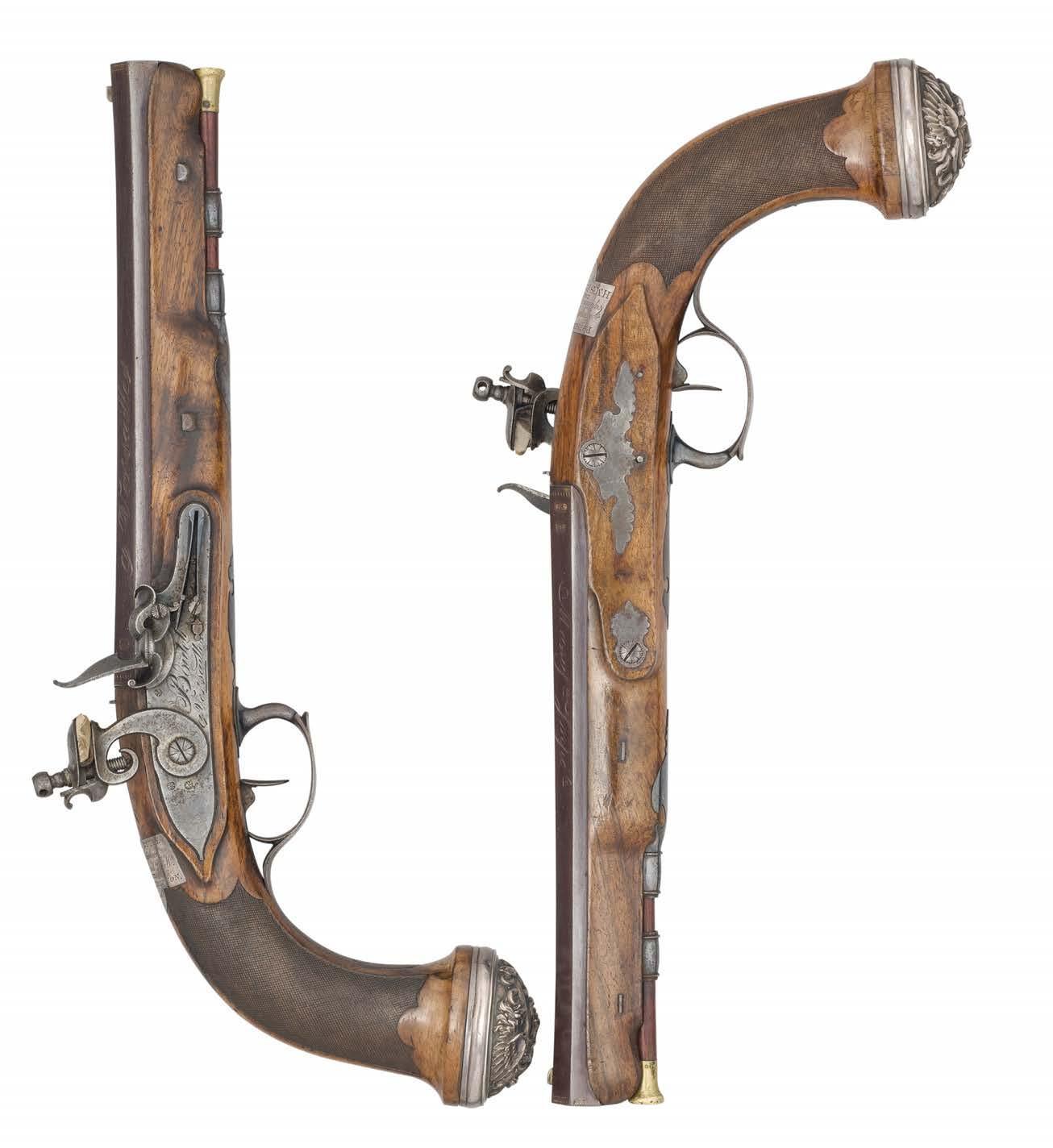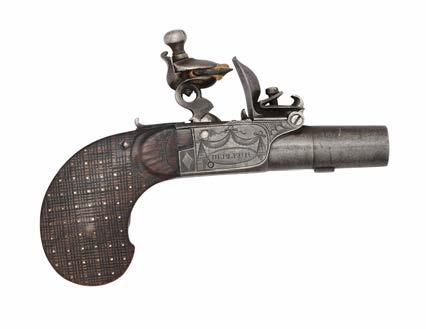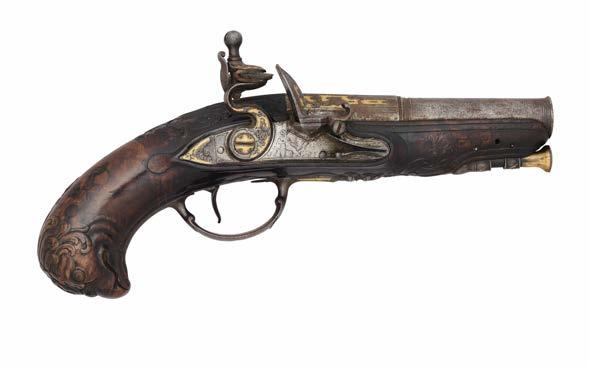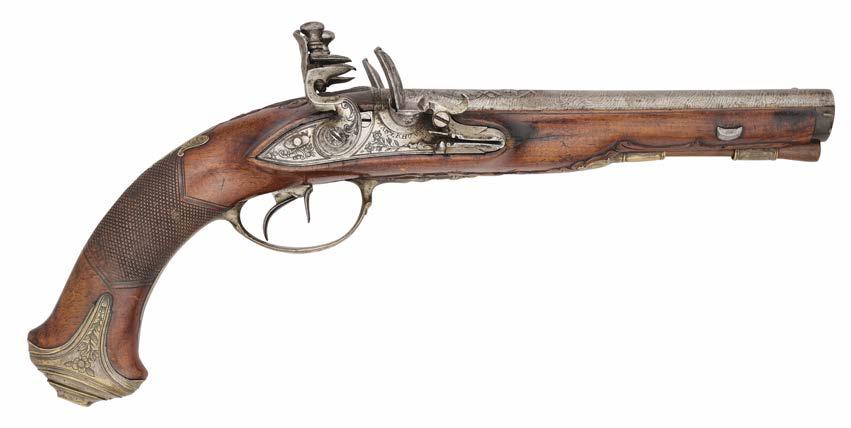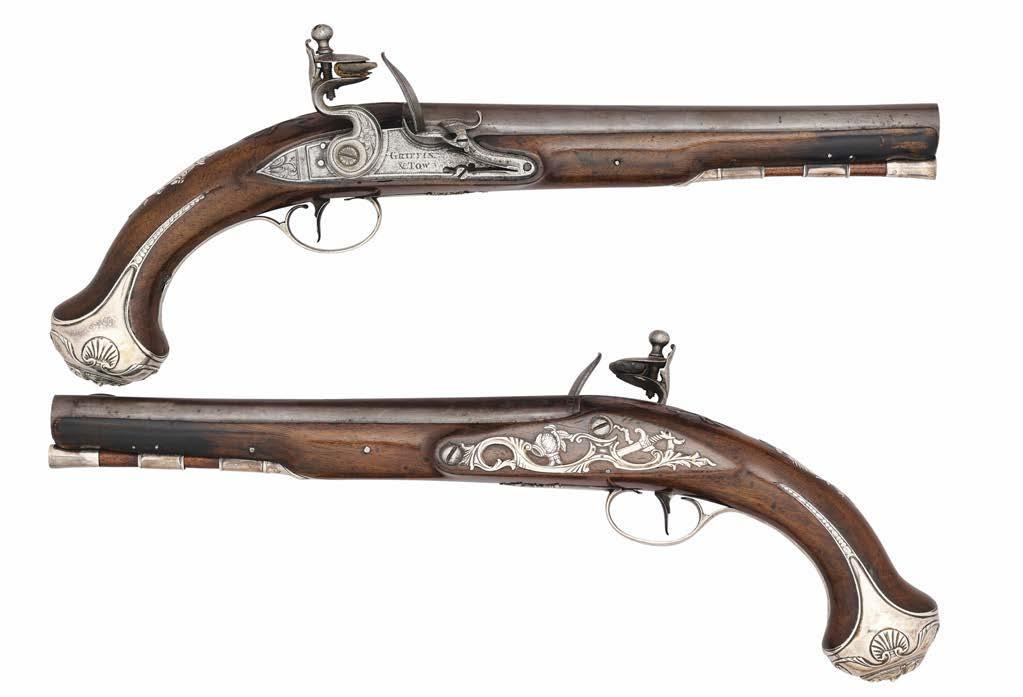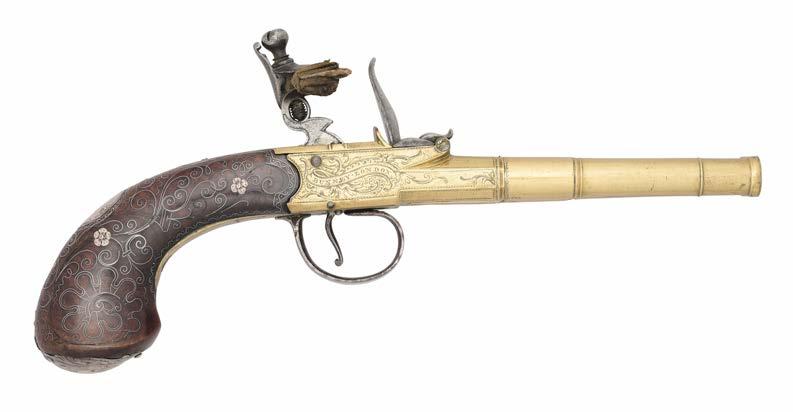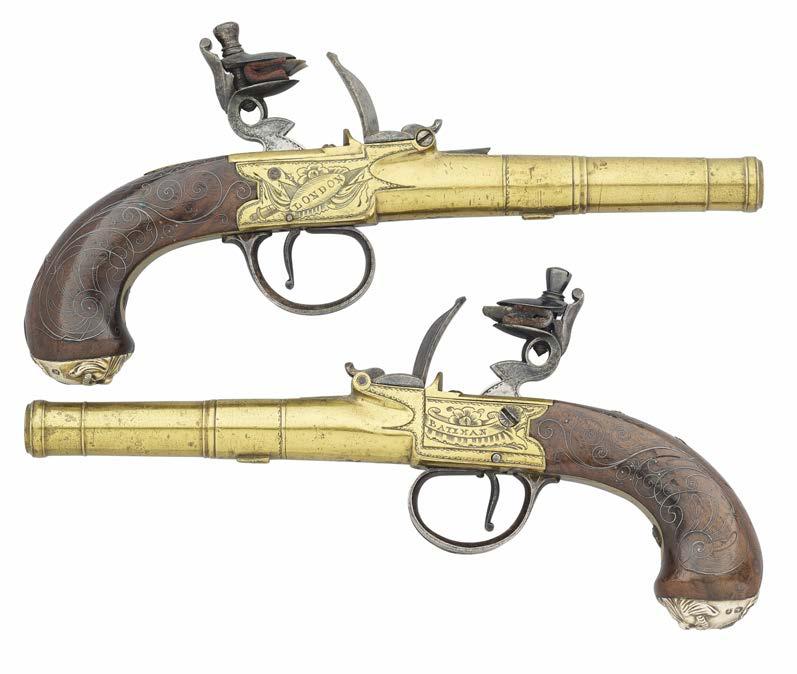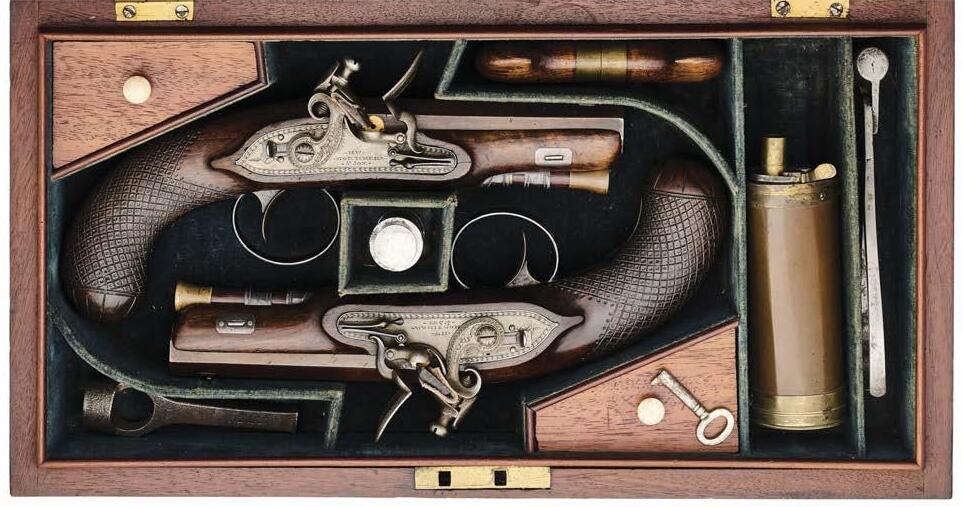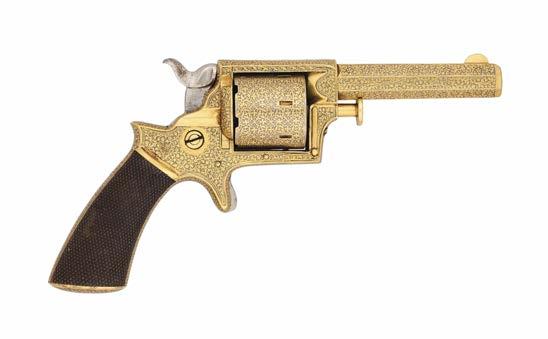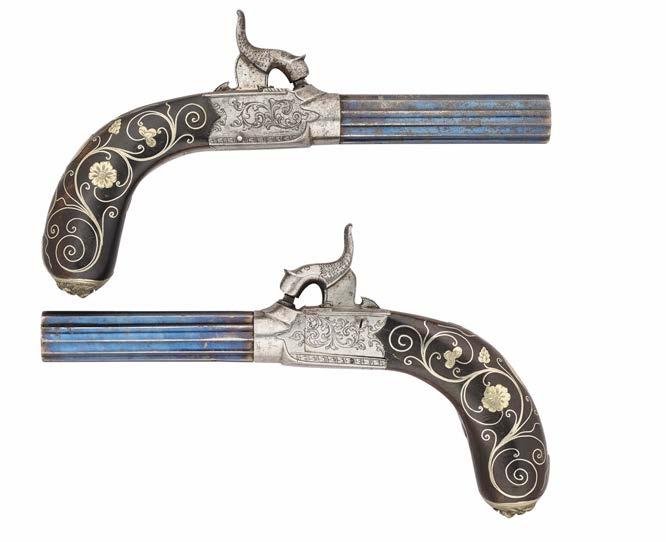SELECT BIBLIOGRAPHY
Akehurst 1968
Alexander 1992
Bailey 2013
Bell & Philpott 1960
Black, Guerin & Michaud 2007
Blackmore 1965
Blair 1974
Blair 1981
Boccia and Coelho 1967
Boccia and Coelho 1975
Breiding 2013
Bremers 2024
Brooker & Lehner 1975
Cooper 1999
De Carbonnières 2005
Dexter 1960
Elgood 2004
Elgood 2009
Flayderman 2001
Frost 1972
Gabriel 1990
Gamber & Beaufort 1990
Godwin & Oliver 2006
Goswamy & Dallapiccola 1983
Hales 2013
Laking 1922
LaRocca 2006
Richard Akehurst, Sporting Guns, London 1968
David Alexander, The Nasser D. Khalili Collection of Islamic Art, The Arts of War, Arms and Armour of the 7th to the 19th centuries, Volume XXI, 1992
De Witt Bailey, ‘The Pattern 1824 Sea Service Pistol’ in Journal of the Arms & Armour Society, Vol. XXI, No. 1, March 2013, pp. 11-15
J. Bell and J. Philpott, ‘Brief Notes on Deane-Harding Percussion Revolvers’ in Black Powder, December 1960
Joel Black, Kerry Guerin and Roger G. Michaud, Tranter Cartridge Firearms, 2007
Howard L. Blackmore, Guns And Rifles Of The World, New York 1965
Claude Blair, Arms, Armour and Base-metal Work (Waddesdon Manor Catalogue: James A.De Rothschild Collection), National Trust 1974
Claude Blair, ‘The Early Basket-Hilt in Britain’ in Scottish Weapons and Fortifications 1100-1800, 1981
Lionello G. Bocca & Eduard T. Coelho, L’arte dell’armatura in Italia, Milan 1967
Lionello G. Boccia & Eduard T. Coelho, Armi Bianche Italiane, Milan, 1975
Dirk H. Breiding, A Deadly Art: European Crossbows, 1250–1850, New York 2013
Dr Louis M.H. Bremers, The Pursuit of Honour: A History of the Pistol Duel in Britain and France, London 2024
R.E. Brooker and H. Lehner, ‘The Military Pistols Of Saxony’ in the American Society of Arms Collectors, Bulletin 31, 1975
John Cooper, ‘John Cosins, Gunmaker of London’ in The Sixteenth Park Lane Arms Fair Guide, February 1999
Philippe De Carbonnières, Lesuere Gouaches Révolutionnaires, Collections du musée Carnavalet, 2005
F. Theodor Dexter, Half Century Scrapbook of Vari-Type Firearms, 1960
Robert Elgood, Hindu Arms and Ritual: Arms and Armour from India 1400-1865, Chicago 2004
Robert Elgood, The arms of Greece and her Balkan neighbours in the Ottoman period, London 2009
Norm Flayderman, Flayderman’s Guide to Antique American Firearms and Their Values, 8th Edition, 2001
G.H. Frost, Blades and Barrels, El Paso 1972
Erich Gabriel, Die Hand- und Faustfeuerwaffen der habsburgischen Heere, Vienna 1990
Ortwin Gamber & Christian Beaufort, Kunsthistoriches Museum, Wien, Hofjagdund Rüstkammer. Katalog der Liebrüstkammer, II. Teil-Der Zeitrum von 1530-1560, 1990
Brian Godwin and David Oliver, ‘English Snaphaunce Firearms’ in The Park Lane Arms Fair Guide, 2006
B.N. Goswamy and A.L. Dallapiccola, A Place Apart: Paintings in Kutch, 17201820, Delhi 1983
Robert Hales, Islamic and Oriental Arms and Armour: A Lifetime’s Passion, St Peter Port 2013
Sir Guy Francis Laking Bart., C. B., M.V.O., F.S.A, A Record of European Armour and Arms Through Seven Centuries, London, 1922, volume III
Donald J. LaRocca, Warriors of the Himalayas: Rediscovering the Arms and Armor of Tibet, New York 2006
Mazansky 2005
Mowbray 1967
Neal & Back 1984
North 1985
O’Sullivan & Bailey 2019
Paszkiewicz 1975
Phyrr 2000
Pinchot 2014
Reid 1960
Rimer 2003
Robinson 1974
Schallaburg 1977
Schedelman 1964
Schedelmann 1972
Schedelmann 1973
Schuckelt 2010
Southwick 2001
Stone 1961
Taylerson et al 1968
Thomas 2015
Volmer 2002
von Ehrenthal 1906
Vovelle 1996
Vovelle 1999
Weaver & Godwin 2016
Wilson 2009
Yablonskaya 2006
Cyril Mazansky, British Basket-Hilted Swords, Suffolk 2005
E. Andrew Mowbray, Arms and Armor from the atelier of Ersnst Schmidt, Munich, 1967
W. Keith Neal and D.H.L. Back, Great British Gunmakers 1540-1740, Norwich 1984
Anthony North, An Introduction to Islamic Arms, London 1985
John O’Sullivan & De Witt Bailey, Robert Wogdon, Wogdon & Barton, John Barton: London Gunmakers 1764-1819, London 2019
M. Paszkiewicz, ‘Polish War Hammers: Czekan, Nadziak, Obuch’ in J.A.A.S., Vol. VIII, No. 3
Stuart Pyhrr, European Helmets, 1450-1650, Treasures from the Reserve Collection, New York 2000
Oliver S. Pinchot, Arms of the Paladins, 2014
William Reid, “The Present of Spain: A Seventeenth-Century Royal Gift’ in Connoisseur, August 1960
Graeme Rimer, ‘A Decorated 17th Century English Stonebow’ in The Twentieth Park Lane Arms Fair Guide, 2003
Henry Russell Robinson, Il Museo Stibbert a Firenze, Vol. 1, 1974
Schallaburg, Das Wiener Bürgerliche Zeughaus, Vienna 1977
Hans Shedelman, ‘Der Meister der Tierkopfranke’ in Wiener Jahrbuch für Kunstgeschichte, vol. 4, 1962
Hans Schedelmann, Die grossen Büchsenmacher, Braunschweig 1972
Hans Schedelmann, ‘The Master of the Animal-Head Scroll’ in Arms & Armour Annual, 1973, No. 35
Holger Schuckelt, Die Türckische Cammer, 2010
Leslie Southwick, London Silver-Hilted Swords: Their Makers, Suppliers and Allied Traders, with Directory, Leeds 2001
George Cameron Stone, A Glossary of the Construction, Decoration and Use of Arms and Armor, New York 1961
A. W. F. Taylersen, R. A. N. Andrews, & J. Frith, The Revolver 1818-1865, London 1968
Clive Thomas, ‘The War Hammer in Western Europe from the High Middle Ages to the Renaissance’ in London Park Lane Arms Fair Guide, Spring 2015
Udo Vollmer, Deutsche Militär-Handfeuerwaffen, Heft 1 - Bayern, Bad Saulgau 2002
Max von Ehrenthal, Die Waffensammlung des Fursten Salm-Reifferscheidt zu Schloss Dyck, 1906
Michel Vovelle, ‘La Revolution Française Images Et Recit 1789-1799’ in Livre Club Diderot, Tome III, Septembre 1791 à Juin 1793, 1986
Michel Vovelle, ‘Les Armées Françaises A L’Époque Revolutionnaire (17891804)’ in Les Collections Du Musée De L’Armée, 1989
David S. Weaver and Brian Godwin, ‘Henry Ellis of Doncaster, the Man and His Work’ in London Park Lane Arms Fair Guide, Spring 2016
Guy Wilson, ‘From Bolt to Ball: English Crossbows in the Tudor and Stuart Periods’ in The Park Lane Arms Fair Guide, Spring 2009
Y.A. Yablonskaya, English Firearms of the XVII - the Early XIX Centuries, Moscow 2006
This catalogue is dedicated to the memory of Dr Alan Richard Del Mar (8th March 1943 – 21st October 2025)
Company Secretary
Catalogue proofreader
Sage Counsel
A HANDACHI SIGNED HIKITA TABEI NO JO KIYONOBU, SHINTO
the blade with two mekugi-ana, midare hamon, fully bound tsuka with iron fuchi and kabuto-gane with some gold decoration, and shakudo and gold menuki in the form of two game birds and foliage, iron Heianjo school tsuba of lobed form inlaid with brass foliage, in its finely ribbed black lacquered saya with iron mounts en suite with the tsuka, and iron kodzuka, 67.7 cm blade
This swordsmith dates from the Teikyo period and is KIY359 in Hawley.
£1,000-1,500
A VERY RARE SOUTH INDIAN OR DECCAN SHORT SWORD, THE HILT 15TH/16TH CENTURY
with replacement double-edged blade cut with two central fullers forming a shallow ridge over each side to the point, and widening at the forte to form a disc cut with an incomplete circle on one side, russet iron hilt with tapering langet on both sides (one terminal missing, the other replaced) secured by a transverse rivet on petalled washers, integral grip swelling at the centre between pairs of stylised parrot-heads forming the quillons and pommel respectively, the latter surmounted by an associated spherical finial (old rust patination), 58.8 cm blade
For other examples of this rare type see Elgood 2004, p. 123, fig. 11.24, and Hales 2013, p. 71, figs. 153-155.
£1,000-2,000
3
A SOUTH INDIAN PATA, 17TH CENTURY, PROBABLY TANJORE
with tapering double-edged blade with shallow medial fuller over most of its length on both sides, characteristic iron hilt shaped over the hand and fore-arm, and extending as two plates riveted over each side of the forte chiselled in low relief with repeated foliage above a pair of parrots, pierced and chiselled over the hand with a diaper pattern of quatrefoils within borders of flower-heads and running foliage, the forearm pierced and chiselled with vertical alternate lines of flower-heads and foliage en suite, prominent beaded upper border, ovoidal wrist-mount, and tubular grip (old rust patination and minor holing), 91.3 cm blade
Similar examples are in the Stibbert Museum, Florence. See Robinson 1974, pp. 194-195 and 198, fig. 99a-d, and Hales 2013, p.174, fig. 421.
£600-900
A RARE SOUTH INDIAN PATALLAH, 17TH CENTURY
with broad double-edged blade widening slightly at the tip, hilt comprising long riveted slender langets of flattened triangular section extending over a third of the blade length on each side and engraved with red pigment filled symmetrical foliage, hilt comprising downcurved beak-shaped blade-catching quillons decorated en suite and set below the bent-up disc-shaped guard, cup-shaped pommel engraved with a bands of scrolling foliage between bands of S’s and pellets, and tubular grip swelling at the centre (old rust patination overall), 92.3 cm blade
For a related example sold in this Room see Fine Antique Arms, Armour & Militaria, 4 December 2024, lot 46.
£500-700
5
AN INDIAN KHANDA, 18TH/19TH CENTURY
with broad blade widening to the rounded double-edged point and reinforced with cusped silver-damascened plates over each side at the forte, the top plate along the back extending towards the point, characteristic russet steel hilt damascened in silver with foliate borders followed by gold-damascened crenelated borders, and comprising hooked quillons with reinforcing plate over each side of the forte damascened in silver with a large flower-head and foliage, pierced terminals en suite, waisted bent-up guard with integral knuckle-guard (old repair) tapering up to join the cup-shaped pommel with domed cap, the latter with stalk-like finial on a petalled mount, and slender grip of flattened diamond section, in its leathercovered wooden scabbard with curved steel chape with central fleur-de-lys on both sides and damascened with foliage en suite with the hilt, 72.5 cm blade
£1,000-1,500
AN INDIAN SHAMSHIR, 19TH CENTURY
with curved single-edged blade of finely watered wootz steel (some old rust staining and patination in places) golddamascened over its entire length along the back on each side with running foliage involving hanging pendants of flower-heads and arabesques, the forte gold-damascened with a panel of flowering foliage on both sides, a cartouche-shaped panel and oblong panel each containing foliage above on one side, and on the other with a gold-damascened cartouche containing an Arabic inscription, hilt comprising russet steel quillon-block gold-damascened with borders of scrollwork and with a foliate quatrefoil between the slender langets, quillons widening towards the tips, grip-strap and rounded pommel-cap damascened en suite, and faceted ivory grips (repairs), in original wooden scabbard (minor damage) covered in brown leather tooled with longitudinal lines and cross-hatching along one side, and steel suspension mounts each damascened en suite with the hilt, 82.5 cm blade
£1,800-2,200
A VERY RARE INDIAN EXECUTIONER’S SWORD BROUGHT HOME BY CAPT. SIR WILLIAM PEEL R.N., C.B. AND PRESENTED BY ARTHUR PEEL ESQRE.
19TH CENTURY
MP,
with 17th century broad blade of khanda form widening towards the double-edged point and pierced with a series of small holes along the back, the for te with shaped reinforcing plate on each side bordered by a series of minute dots and sandwiched between thicker plates each with pointed terminal and made in one with a ridged quillon-block, the latter with down-bent quillons each with lobed terminal, on tubular haft fitted with three copper-alloy compressed spherical mounts with turned decoration, the top one with button finial, in original wooden scabbard (damaged, incomplete and repaired) covered in brown leather tooled with diaper pattern overall and with painted inscription along one side ‘Executioners Sword. Brought Home by Capt. Sir William Peel R.N. C.B. Presented by Arthur Peel Esq re. M.P.’, 77.0 cm blade
Captain Sir William Peel (1824-1858) and Arthur Wellesley Peel, 1st Viscount Peel (1829-1912) were both sons of Sir Robert Peel, (17881850), Prime Minister from 1834-35 and 1841-46. The former served at Crimea and was awarded the Victoria Cross for his part in the Assault on the Redan. Sir Stephen Lushington’s citation reads ‘For having on the 18th October, 1854, at the greatest possible risk, taken up a live shell, the fuse still burning, from among several powder-cases, outside the magazine, and thrown over the parapet (the shell bursting as it left his hands), thereby saving the magazine and the lives of those immediately round it’. And further that ‘On the 5th November 1854, at the Battle of Inkerman, for joining the officers of the Grenadier Guards and assisting in defending the Colours of that Regiment when hard pressed at the Sandbag battery’, and ‘On the 18th June 1855, for volunteering to lead the Ladder Party at the assault on the Redan, and carrying the first ladder until wounded’. He died of smallpox on 27 April 1858 at Cawnpore, India.
Arthur Peel was a Liberal politician from 1865 to 1895. He was Speaker of the House of Commons exhibiting ‘conspicuous impartiality combined with a perfect knowledge of the traditions, usages and forms of the House, soundness of judgment, and readiness of decision upon all occasions.’
£1,000-1,500
Captain Sir William Peel RN, VC, KCB
AN INDIAN TULWAR, LATE 18TH/19TH CENTURY
with curved fullered blade etched in imitation of wootz steel and double-edged towards the point, and characteristic steel hilt including knuckle-guard with budshaped terminal decorated overall in gold koftgari with symmetrical flowering foliage, in its wooden scabbard covered in black leather seamed in silver ribbon and wire along one side, 79.5 cm blade
£1,000-1,500
9
AN INDIAN SWORD, 19TH CENTURY, PROBABLY KUTCH
with earlier slightly curved single-edged blade cut with four narrow fullers along most of its length on both sides, one side towards the forte with remains of incised marks and small dots, copper-alloy hilt retaining much of its gilding and engraved with flowering foliage against a finely punched ground, comprising pointed langets and rounded quillons of tulwar form, tapering knuckle-guard rising up to beneath the muzzle (dented) of the horsehead pommel (eyes missing), and swelling grip chased with a mane on one side, in later velvet-covered wooden scabbard, 80.0 cm blade
£600-800
10
AN UNUSUAL INDIAN TULWAR, 19TH CENTURY
of steel, with curved serrated blade double edged at the bifurcated top of Dhu-l faqar form, the back-edge and one side of the forte cusped, and characteristic hilt chiselled with flowering foliage within notched borders on both sides on the quillon-block and swelling grip, 82.5 cm blade
£600-800
A VERY RARE SOUTH INDIAN BICH’HWAS,
THANJAVUR, TAMIL NADU, EARLY 17TH CENTURY of russet iron, with slender sharply tapering bifurcated blades each with serrated double-edges and cut over both sides with a double fuller to the point of flattened diamond section, rectangular forte cut with a trefoil at the base of each blade on both sides, hilt extending over the forte on both sides as a chiselled palmette, the front curved over the back of the hand and finely pierced and chiselled with symmetrical leafy foliage inhabited by a peacock on both sides each grasping a serpent in its claw, its body entwined around the peacock’s tail, the recurved grip chiselled with a central panel of chevrons and pierced and chiselled with leafy foliage en suite with the front, and surmounted by a petalled cap with button finial, 24.5 cm blades
Two related daggers are in the Metropolitan Museum of Art, New York (inv. nos. 36.25.779 and 36.25.1009). For the first see Stone, 1961, pp.112 and 113, fig. 146.1, and for the second see Elgood 2004, p.15, fig. 1.3. Elgood states ‘The peacock and the serpents point firmly to Skanda aka Murukan or Karttikeya, all names of the war god who rides on the peacock, which inspired the commissioner of this weapon’.
£3,000-5,000
12
AN UNUSUAL SOUTH INDIAN KATAR WITH EUROPEAN BLADE, VIJAYANAGARA, 16TH/17TH CENTURY
with tapering double-edged blade adapted from a sword blade and with remains of an incised inscription on one side at the forte, characteristic russet iron hilt retaining traces of gilding and comprising a shaped riveted plate extending over each side of the forte, tapering side-bars chiselled around the borders with repeated botehs and pierced with symmetrical foliage at the top, baluster grips with two small beads between, and recurved triangular hand-guard arcaded beneath and decorated en suite with the side-bars, rising to a bud-shaped finial and with chiselled reinforcing bar beneath (old rust patination and pitting), 28.7 cm blade
See Elgood 2004, pp. 145-162.
£500-800
13
A SOUTH INDIAN KATAR, 17TH CENTURY, PROBABLY TANJORE OR GOLCONDA with tapering double-edged blade adapted from a European sword-blade, iron hilt arched over the a-shaped plate extending over each side of the forte and chiselled in bas-relief with a design of silvered symmetrical foliage, tapering side-bars (one with old repair) and both decorated over each side en suite with the plates over the forte, and grip pierced and chiselled with a silvered quatrefoil between pairs of scrolled arabesques, and retaining much of its silvering, 31.5 cm blade
£400-600
14
AN INDIAN KATAR, 19TH CENTURY with tapering double-edged blade of slightly hollow diamond section, the forte on both sides cut with converging fullers centred on a golddamascened fleur-de-lys above a panel damascened with gold foliage, hilt of characteristic form decorated overall with golddamascened scrolling foliage and comprising straight side-bars, and faceted swelling grips, in its wood-lined velvet-covered steel scabbard pierced along both sides with foliage inhabited by pairs of gold-damascened birds withing borders of running foliage, 20.5 cm blade
£400-500
A SOUTH INDIAN CHILANUM, EARLY 17TH CENTURY
with sharply tapering recurved double-edged blade cut with narrow converging fullers over most of its length along both sides, hilt retaining traces of silvering and comprising cartouche-shaped plate over each side of the forte, concave ovoidal guard over the forte with pierced border and small spherical quillons, chiselled knuckle-guard tapering up to a peacock head finial, petalled cup-shaped pommel with spirallyfluted button finial centred on a quatrefoil reinforcing plate with cusped and minutely pierced borders, and integral grip of diamond section tapering to a central spirally-fluted sphere (old rust patination and pitting), 28.2 cm blade
For a related example from the Roy Elvis Collection and sold in this Room see Antique Arms, Armour & Militaria, 7 December 2022, lot 25.
£800-1,000
AN INDIAN PESH-KABZ WITH CALLIGRAPHIC HILT, 20TH CENTURY
of steel, with tapering recurved single-edged blade of finely watered wootz steel reinforced along the cutting edge and of T-section along the back, hilt decorated overall with repeated gold-damascened flowering foliage and pierced to form the word Nasir (for Helper, one of the names of God), 27.5 cm blade, 43.3 cm overall
For a similar example, see Alexander 1992, p. 190, no. 124 (illustrated). Another was sold Bonhams Knightsbridge, 24 November 1999, lot 68. £2,000-3,000
AN INDIAN JADE-HILTED KARD WITH RAM’S HEAD POMMEL, 18TH CENTURY
with tapering slightly hollowed single-edged blade of finely watered wootz steel damascened with gold foliage along the entire length on the back, on both sides at the forte and on the pinched-in basal mount (some old pitting), spinach jade hilt of slight oval section with integral pommel carved and pierced in the round as a ram’s head (beard chipped and eyes missing), in its later textile-covered wooden scabbard with original copper-alloy locket and chape retaining some original gilding and pricked with a trellised pattern of flower-heads, the former with loop for a tassel pierced with arabesques, the latter with fluted bud-shaped terminal, 24.2 cm blade
For a related example see Hales 2013, p. 29, fig. 71. £3,000-4,000
AN INDIAN KHANJAR, LATE 19TH CENTURY
of steel, with bright curved double-edged blade of flattened diamond section at the point and cut with two fullers forming a medial ridge on both sides, the forte on each side roughly chiselled with gold-damascened foliage against a pricked ground, gold-damascened hilt comprising fluted bud-shaped quillons, tapering knuckle-guard with foliate finial, and grip decorated overall with interlaced arabesques against a flecked ground and rising up to a stylised bird’s head pommel, 24.7 cm blade
£600-800
19
A RARE INDIAN FAKIR’S CRUTCH (ZAFAR TAKIYA), 18TH CENTURY OR EARLIER
the top of mutton fat jade formed as a bellied double scroll of flattened oval section carved in low relief with symmetrical scrolling foliage, on its russet steel basal mount pierced with a double scroll retaining some of its golddamascened decoration, and sharply tapering blade of hollowed diamond section retained by a petalled silver tang washer (haft also forming the scabbard missing), 54.3 cm blade
£1,200-1,500
20
AN INDIAN BUHJ, 19TH CENTURY, PROBABLY KUTCH
with characteristic bright single-edged blade of flattened diamond section towards the point, decorated on both sides with a large silver-gilt panel chased with designs of foliage against a punched ground, and mounted on a gilt-copper elephant’s head formed in the round and with punched and chased details, on tubular haft covered in gilt silver chased overall with flowering foliage against a punched ground, and large gilt finial decorated en suite, threaded and opening to reveal a slender bright single-edged knife-blade with silvered grip, 61 cm oval
Another similar example was sold Bonhams Knightsbridge, 25 July 2012, lot 84. See also Goswamy & Dallapiccola 1983, pl. XXIX.
£1,000-1,500
21
AN INDIAN ZAGHNAL, LATE 18TH/EARLY 19TH CENTURY
with beaked double-edged blade of flattened diamond section (extreme tip missing), border engraved integral block-shaped socket incised with Indian numerals and surmounted by a silver bud-shaped finial, on slender wooden haft of circular section with silver mounts at the top and bottom, 14.0 cm head
£400-600
22
AN INDIAN TABARZIN, 19TH CENTURY
of steel, the triangular head with convex cutting-edge bordered by gold-damascened running foliage, integral block-shaped socket damascened en suite and centred on a flowerhead on both sides, on tubular haft damascened in silver with three bands of foliage and with bud-shaped terminal, 13.5 cm head, 56.5 cm long
£300-400
AN INDIAN MACE (GURZ) WITH HILT OF FIRANGI FORM, 17TH CENTURY
formed entirely of steel, with head of eight thin flanges of shaped outline surmounted by a finial chiselled as a bud, on slender haft of octagonal section, hilt comprising slightly beaked quillons with incised line decoration, bent-up guard with raised scrolled border and pierced with pairs of holes for a liner, curved knuckle-guard en suite tapering up to join the disc-shaped pommel, the latter with stalk-like finial on a petalled cap mounted on a fluted dome, and slender swelling grip of diamond section, 54.5 cm
£1,000-1,500
24
AN INDIAN MACE (GURZ) WITH HILT OF FIRANGI FORM, 17TH/18TH CENTURY
formed entirely of steel, with head of eight thin flanges each formed as a lotus-blossom pierced with a triangle, and surmounted by a double-edged spike of flattened diamond section, on slender haft of circular section, earlier hilt extending over the flattened part of the haft and terminating in a pierced palmette on both sides, short beaked quillons each on a stepped moulding, up-bent guard linked to the capshaped pommel by the tapering knuckle-guard, the latter with stalk-like finial on a thin petalled mount, and slender swelling grip, 93.0 cm overall
£800-1,200
AN INDIAN TOP, 19TH CENTURY
with domed fluted skull decorated overall with a symmetrical design of repeated tapering gold-damascened arabesques against a ground of silver-damascened foliage, fitted with two plume-holders, adjustable nasal with palmette-shaped terminals and held in the up position by a loop-catch, and surmounted by a further plume-holder on a domed petalled mount, all damascened en suite with the skull, short vandyked camail of butted rings, and in fine condition, 18.0 cm high
£400-600
26
A PERSIAN KULAH KHUD, QAJAR, 19TH CENTURY
with domed skull embossed and chased with four silverdamascened sun-in-splendours between crescent moons and stars above pairs of angels holding a crown aloft, all against a ground of chiselled flowering foliage, the rim bordered by ovoidal and circular panels containing silver-damascened Persian verses in nasta’liq, fitted with loosely damascened plume-holders, nasal with cartouche-shaped terminals, the lower one decorated with a human face, central spike of diamond section, and vandyked camail of butted steel and brass rings, 27.5 cm high
£600-800
A
FINE PERSIAN KULAH KHUD, DHAL AND BAZU BAND, QAJAR, 19TH CENTURY
of finely watered wootz steel, the first with domed skull chiselled in bas-relief with Persepolitan hunting scenes within arcades , the scenes involving horsemen hunting various game, and including a bearded figure riding an elephant, armed with a sword and wielding an axe, and a female figure at her toilette, and around the base of the arcade with the repeated scene of a lioness attacking a hind, the rim with gold-inlaid ovoidal panels enclosing Persian couplets in praise of the helmet in gold-inlaid nasta’liq, each panel between a cartouche chiselled with a hawk attacking a bird, a gold-inlaid circular cartouche at the front inscribed in gold ‘The servant of the King of Trusteeship Sulaymen’ and dated 1115 AH (corresponding to 1703-04 AD), fitted with threaded central spike of hollow diamond section on a circular mount chiselled with four birds each in a cartouche, and adjustable nasal with shaped finials, vandyked camail of small butted steel and copper alloy rings forming a repeated design, and retaining its brown velvet liner; the second of convex circular form with four gold-damascened bosses each with pierced border, the outer surface decorated en suite with the kulah khud within a double border of gold- damascened calligraphy and scrolling foliage (some loss of gold-damascening in one area), and retaining its padded brown velvet liner, leather pad and bracers; the last shaped to the forearm and decorated en suite (wrist-plates and liner missing), 26.5 cm high, 38.3 cm diameter and 35.0 cm long (3)
Provenance
Frank Paul Collection, Berlin
£7,000-9,000
A SAUDI ARABIAN SWORD, 20TH CENTURY
with bright single-edged blade cut with three fullers along the back on each side, gold-mounted hilt comprising quillon-block with pointed langets and quillons each with fluted bud-shaped tip, the forward one linked to the pommel by a knuckle-chain carrying a gold coin, foliate engraved beaked pommel-cap, filigree grip-strap bound with wire at the base, and bone grips each with a row of three gold discs, in its wood-lined scabbard engraved along both sides with scrolling foliage against wrigglework grounds, the locket chased with crossed sabres and palm tree on both sides, and suspension mounts chased with a flower-head on both sides and each carrying a suspension ring with chains and coin en suite with the hilt, 92.0 cm blade
£1,500-2,000
29
A PERSIAN ALL-METAL JAMBIYA, QAJAR, 19TH CENTURY
with curved sharply pointed double-edged blade cut with two fullers over most of its length on both sides forming a medial ridge, the forte chiselled on each side with foliage inhabited by a tiger attacking a bull, waisted hilt of oval section decorated on both sides with shaped panels encrusted with chased silver foliage within gold-damascened line borders, all against a ground of chiselled flowering foliage inhabited by a bird at the top and bottom, in original scabbard profusely decorated en suite along both sides, 32.5 cm blade
Provenance
Christie’s London, Antique Arms and Armour, 16 December 1999, lot 6 (part)
Bonhams Knightsbridge, Fine Antique Arms & Armour, 23 September 2020, lot 42
£1,000-1,200
30
A PERSIAN SWORD WITH UNUSUAL STRAIGHT BLADE, QAJAR, LATE 18TH/19TH CENTURY
with broad sharply pointed single-edged blade of finely watered wootz steel cut with three fullers along the back over most of its length on both sides, now fitted with repaired hilt comprising steel quillon-block with pointed langets (upper ones reduced) and tapering quillons, the latter each with bud-shaped terminal, grip-strap, domed pommel-cap, and polished staghorn grips, in original wooden scabbard covered in black leather (incomplete at the throat) tooled with raised fleur-de-lys along both sides and with steel chape and suspension mounts, the former encrusted with chased copper-alloy foliage on the outside, the latter with copper-alloy tiger and foliage respectively within beaded borders, 89.5 cm blade
£1,000-1,500
31
A PERSIAN AXE, QAJAR, 19TH CENTURY
of steel, with crescentic blade chiselled on both sides with a cartouche containing contemporary Persian figures seated amid foliage involving axes and a vase, a smaller cartouche beneath chiselled woth Arabic calligraphy, rounded socket and block-shaped peen chiselled with panels of calligraphy en suite, and retaining traces of gold-damascening, on faceted tubular haft in five stages retaining traces of silver-damascening, the top, central and bottom sections spirally twist and retaining some original gilding, and surmounted by a sprung clip formed as a chased and gilt bird with turquoise eyes (one missing, some old pitting overall), 19.4 cm head
Provenance
Bonhams Knightsbridge, Antique Arms & Armour, 25 November 2015, lot 11
£500-600
AN OTTOMAN SABRE, 19TH CENTURY
with curved fullered blade retaining traces of etched decoration, the lower fuller and the fuller at the forte along both sides elaborately gold-damascened with Arabic calligraphy, hilt comprising gold-damascened quillon-block with pointed langets and tapering quillons, the latter each with button tip, horn grips with copper-alloy wire binding at the base, golddamascened grip-straps and cone-shaped pommel, the former each retained by four dome-headed nails, the latter with small fixed ring for a tassel, in its wooden scabbard with remains of textile covering, and with deep locket, chape and ovoidal suspension mounts all gold-damascened en suite with the hilt, 85.5 cm blade
£1,000-1,500
33
AN OTTOMAN YATAGHAN, TURKEY, DATED 1217 A.H. CORRESPONDING
TO 1805 A.D., PROBABLY FOCA
with slightly recurved single-edged blade cut with a narrow fuller along the back on each side and inlaid along most of its length on both sides with silver scrollwork and dots, one side enclosing panels inscribed with the date, maker’s name ‘Al-Hajj’, owner’s name ‘Hussain Agha’ and two Turkish couplets, all in thuluth, and on the other with further couplets in praise of the yataghan, a shaped silver mount over the forte set with silver diamonds and pellets enriched with a red coral bead on a filigree rosette, all between twisted silver lines, in original wooden scabbard covered in black leather with silver locket and chape, the former entirely set with bands of clustered beaded ropework and diamonds, the latter chased with designs of foliage and with a monster-head terminal, 56.0 cm blade
Provenance
Bonhams Knightsbridge, Easter Arms & Armour From the Richard R. Wagner Jr. Collection, 29 April 2015, lot 56
A similar example is in the Victoria & Albert Museum (inv. no. M.964-1928). See North 1985, p. 26, fig. 157.
£2,000-2,500
A RARE OTTOMAN PALLASCH SCABBARD WITH NIELLOED SILVER-GILT MOUNTS, TURKEY, LATE 17TH CENTURY
of wood covered in hardened black leather lightly tooled with foliage between the suspension mounts on both sides, the locket, chape and two suspension mounts pierced and chased with symmetrical flowering foliage, the chape against a ground of red velvet, 82.0 cm
For a pallash with similar scabbard in the Staatliche Kunstsammlung, Dresden, see Schuckelt 2010, p. 266, no. 242.
£1,000-1,500
35
AN OTTOMAN SILVER-MOUNTED SHAMSHIR, 19TH CENTURY
with earlier Indo-Persian slender curved single-edged blade of finely watered wootz steel (areas of rust patination and polishing), hilt comprising border engraved quillon-block decorated with foliage and with pointed langets and tapering quillons, the latter each with faceted bud-shaped terminal, the forward one linked to the pommel by a later silver chain, reeded grip-strap and rounded horn grips indented for the fingers, the latter (one repaired at the base) retained by two transverse copper-alloy rivets, and pierced through the beaked pommel with a hole for a sword-knot, in original wooden scabbard covered in black leather with deep silver border engraved locket, chape and rounded suspension mounts all decorated with panels of foliage, the suspension mounts each with a ring for suspension, 80.5 cm blade
£1,500-1,800
A
RARE OTTOMAN SILVER-MOUNTED DAGGER, TURKEY, REIGN OF MUSTAFA II (1695-1703)
with robust double-edged blade cut with three central fullers within incised line borders over each side converging towards the reinforced point of diamond section, the rectangular forte with three recessed circles on both sides against a ground of inlaid symmetrical copper-alloy foliage, hilt comprising large darkly figured hardwood two-piece grip of waisted octagonal section set with twenty composition florets, thirteen retaining their original silver-gilt cap, and medial silver grip-strap (incomplete) nielloed with a design of foliage, 19.9 cm blade
For a very similar example preserved in the former “Türkische Commer” of the Electors of Saxony, now in the Staatliche Kunstsammlung, Dresden, see Schuckelt 2010, pp. 260-262, no. 235.
£4,000-6,000
A RARE LARGE OTTOMAN POWDER-HORN, 16TH/17TH CENTURY
formed from a section of curved faceted buffalo horn (minor damage) tapering up to an ivory terminal of spherical fluted form encircled below by a band of ivory and horn cintamani within ivor y lines, the top covered by a shim of ivory (slightly incomplete on one side), later turned dark horn nozzle, cut-off lever with pierced copper-alloy head, and two suspension rings each on a shaped line engraved mother-of-pearl washer, 24.0 cm high
For two very closely related examples preserved in the former “Türkische Commer” of the Electors of Saxony, now in the Staatliche Kunstsammlung, Dresden, see Schuckelt 2010, pp. 97 and 118-120, nos. 42 and 90.
£2,000-3,000
AN OTTOMAN OR BALKAN SILVERMOUNTED JAMBIYA, 19TH CENTURY
with curved sharply pointed double-edged blade cut with converging double central fuller forming a medial ridge on both sides, the forte on both sides damascened in gold and silver with foliage and Arabic calligraphy, one side framing a mosque, waisted hilt embossed and chased with foliage involving a flower-head and a rocaille on both sides, in original wood-lined scabbard embossed with symmetrical decoration en suite with the hilt withing beaded borders, foliate suspension loop at the throat on one side, and bud-shaped terminal, 27.4 cm blade
£500-600
39 AN OTTOMAN JAMBIYA, LATE 19TH CENTURY
with broad curved double-edged blade with medial ridge along its entire length on both sides, the forte on each side with gold-damascened decoration, waisted steel hilt decorated overall with loosely gold-damascened symmetrical foliage, in original wooden scabbard covered in blue velvet with large steel locket and chape en suite with the hilt, the former with fixed suspension loop, the latter with foliate terminal, 28.2 cm blade
£350-450
A RARE RUSSIAN (TULA) HUNTING DAGGER OF KINDJAL FORM, 19TH CENTURY
with tapering double-edged blade cut with two medial fullers along both sides to the point of flattened diamond section, hilt comprising waisted steel quillon mount and tall arched pommel both retaining some blueing and encrusted over each side with characteristic silver and copper foliage (some losses), and rectangular bone grip cut with vertical lines along the inner sides, and with chequering on the outer sides, in its velvet-covered wooden scabbard (plush worn off) with shaped steel locket, chape and suspension mount decorated with flowering cornucopia en suite with the hilt, the former with slender steel mount carrying a large suspension ring, 37.5 cm blade
£3,000-4,000
A CAUCASIAN KINDJAL, LATE 19TH/EARLY 20TH CENTURY
with bright sharply tapering double-edged blade cut with shallow converging double fullers on each side of the forte, the waisted hilt and wood-lined scabbard entirely covered in nielloed silver embossed and chased on the outside with symmetrical foliage against finely punched grounds, the inner side of the hilt nielloed with foliage, the inner side of the scabbard nielloed with a long central panel of scrolling arabesques centred on a flower-head, and with nielloed suspension mount and fluted budshaped terminal, 25.5 cm blade
£500-600
42
A
LARGE
CAUCASIAN KINDJAL, 19TH CENTURY
with broad tapering double-edged blade with deep offset fuller over most of its length on both sides, one side silver-damascened with cartouches and panels of stylised scrolling foliage, the other side bright, waisted hilt with dark horn grip-scales retained by three transverse iron rivets, two with a prominent stud on a gold-damascened petalled washer, in original wooden scabbard covered in plum velvet (plush worn off, some damage) with deep iron locket, chape and medial strap all silver-damascened on the outside with borders of arabesques, the locket with a starburst, a crescent moon and a star above the suspension mount, 41.2 cm blade
£500-700
A VERY RARE OTTOMAN 12 BORE MUSKET FOR BALL, TURKEY, 17TH CENTURY
the long barrel with bulbous muzzle, the former chiselled in bas-relief overall with panels and cartouches of silver-covered symmetrical arabesques and florets (some silver missing), and at the centre with a gold-inlaid inscription, ‘The owner is Osman Pasha’ in Turkish, along the top flat, the latter with slender tapering panels of foliage and wriggle work en suite, silver-encrusted arched standing back-sight with single aperture, plain tang, characteristically shaped lock with incised decoration and copper-alloy mount over the cock-bridle and the steel-spring, figured three-quarter stock with linear engraved copper-alloy foreend cap also forming the ramrod-entry, and inlaid along both sides of the foreend with diamond-shaped and triangular pieces of mother-of-pearl between mother-of-pearl dots, the flared faceted butt inlaid en suite, secured by brass pins and including some of flower-head shape and recurved form, and veneered with slender panels of ivory at the rear inlaid with groups of three wooden roundels of cintamani form and each with copper-alloy pin, ivory butt-plate (old splits), iron trigger-guard, and iron ramrod, 141.5 cm barrel
For related guns and barrels preserved in the former “Türkische Commer” of the Electors of Saxony, now in the Staatliche Kunstsammlung, Dresden, see Schuckelt 2010, p. 179, figs. 211-215, pp.217-218, figs. 205-208 and p. 274, fig. 251.
£8,000-10,000
44
A FINE TURKISH 25 BORE MIQUELET-LOCK RIFLE (SHISHANA), MID-18TH CENTURY
with slightly swamped octagonal sighted barrel of very finely twist pattern rifled with nine spiral grooves, encrusted in gold with symmetrical flowering foliage within beaded borders on the top flats at the muzzle and breech, and with encrusted gold flowers along the flats between, and retained by four silver barrel bands each chased with foliage en suite, gold-encrusted arched standing back-sight with two small circular apertures, tang covered in silver engraved with a double line of chevrons, characteristic lock encrusted with gold foliage within beaded borders, highly figured Circassian walnut full stock with green-stained horn fore-end cap, the butt with pinned silver mount around the barrel tang engraved with foliage against a hatched ground, and inlaid with pinned silver panels pierced and engraved with foliage including on the side-flat and trigger-plate, characteristic flared faceted butt divided centrally by a silver band engraved with scrolling foliage against a hatched ground, veneered with slender panels of plain and green-stained bone centred on mosaic panels of dark wood and bone of geometric design, silver sling loops each on a foliate engraved silver washer, and original iron ramrod, 82.0 cm barrel For a closely related rifle, see Bonhams Knightsbridge, Fine Antique Firearms from the W. Keith Neal Collection, 10 November 2005, lot 7.
£5,000-7,000
45
AN OTTOMAN 25 BORE MIQUELET-LOCK RIFLE (SHISHANA), TURKEY, LATE 18TH/EARLY 19TH CENTURY
with octagonal sighted barrel of finely twist damascus pattern rifled with seven spiral grooves (bore rusted) and encrusted in gold with symmetrical designs of foliage at the muzzle and breech, the latter with an engraved silver oval on the top flat, silverencrusted arched triple-aperture back-sight, a border engraved silver mount over the tang secured by tacks and decorated with a crescent moon and stars, characteristic foliate engraved lock inlaid with silver lines on the cock, full stock profusely inlaid overall with patterns of small grouped roundels of copper-alloy and green-stained horn against a ground of small copper-alloy nails, the segmented flared faceted butt inlaid en suite and enriched by shaped bone panels and lines, some of the latter stained green, and with border engraved medial silver strap, silver buttplate engraved with a crescent moon and stars, three silver barrel bands, button trigger, and bone fore-end cap (ramrod missing), 90.0 cm barrel
For a related example see Bonhams Knightsbridge, Eastern Arms & Armour From the Richard R. Wagner Collection, 29 April 2015, lot 244.
£2,000-3,000
(TORADOR) WITH ENGLISH FEATURES, MID-19TH
with tapering two-stage barrel retained by five ratan bindings on silver mounts and flared at the muzzle, the latter incised with slender lines and carrying a copper fore-sight, the breech incised ‘EX’ over ‘185’ and with large open sight at the rear, plain tang, large rounded lock and side-plates each with bird’s head terminal and decorated with incised red pigment filled
comprising trigger-guard and hinged circular patch-box cover, figured full stock with chequered pistol-grip, the butt set with
£500-700
A PAIR OF OTTOMAN 18 BORE FLINTLOCK HOLSTER PISTOLS WITH LIÈGE BARRELS AND LOCKS, TURKEY, 18TH/EARLY 19TH CENTURY
with long slightly swamped barrels each with tapering lightly engraved top flat with brass fore-sight, stepped border engraved breeches each decorated with foliage, border engraved copper-alloy tangs each with foliate back-sight, rounded copper-alloy locks each chased with foliage, cocks faced in copper-alloy, the retaining screws each with head faced with a grotesque mask, moulded figured full stocks each carved with foliage on the fore-end and around the barrel tang, the former each with green-stained bone cap, white-metal mounts cast and chased with turbans and crescents amid fruiting foliage, and comprising side-plates, escutcheons, spurred pommels, trigger-guards and faceted ramrod-pipes, scroll triggers, and original ramrods eaxh with bone and dark horn tip (barrels and locks with old wear), 33.5 cm barrels (2)
£2,000-3,000
49
AN OTTOMAN 20 BORE FLINTLOCK SILVER-MOUNTED HOLSTER PISTOL, EARLY 19TH CENTURY
50
AN UNUSUAL INDIAN 28 BORE FLINTLOCK ALL-METAL PISTOL IN THE ENGLISH TASTE, MID-19TH CENTURY
with tapering barrel decorated with a small gold palmette in front of the copper fore-sight, breech with top flat with chiselled and gilt foliate finial, the rear at the breech with engraved gold line and foliage, the latter surmounted by three gold banners, gilt touch-hole, tang with gold borders, flat bevelled lock in the English fashion inlaid with engraved foliate borders and signed ‘Isma’il Shahni’ in Arabic on a gold-inlaid foliate scroll, gold-lined rainproof pan and roller, the cock and steel decorated en suite with the lock, figured full stock, the chequering on the fore-end and butt highlighted with small silver pins, and inlaid with silver-wire scrollwork around the barrel tang, on the side-flat and on both sides above the pommel, mounts comprising side-nail plates pierced and engraved with foliage within a border of repeated foliage, tangplate en suite and secured by small silver pins, small engraved escutcheon, border engraved rounded pommel-cap, foliate engraved trigger-guard and fore-end cap, the latter with engraved extension along the bottom for the fore-end, and no provision for a ramrod, 22.3 cm barrel
Provenance
Christie’s London, Antique Arms And Armour, 20 September 2007, lot 153
£1,500-2,000
with plain octagonal sighted barrel and tang, lock naively engraved with an East India Company lion, copper-alloy full stock engraved with foliage within foliate borders, rounded butt en suite and with chequered foliate panel extending over each side on the back, engraved rounded pommel with pierced copper-alloy suspension loop, foliate engraved copper-alloy trigger-guard, and stirrup ramrod, 19.7 cm barrel
For two related examples see Bonhams Knightsbridge, Eastern Arms & Armour From the Richard R. Wagner Jr. Collection, 29 April 2015, lots 221 and 222.
£500-750
51
A BALKAN (SOULIOT) 20 BORE FLINTLOCK PISTOL WITH SILVER STOCK
with iron barrel (worn and rust patinated) lightly chiselled with foliage and with plain tang, border engraved flat bevelled lock and cock, the former with pseudo inscription, copper-alloy pan and roller, heavy full stock with straight butt and cast and chased overall in relief with symmetrical flowering foliage and shells highlighted with small nielloed panels, the fore-end involving ribbon work and a small trophy-of-arms, bulbous pommel, muzzle-sleeve and trigger-guard all en suite, the first with pierced foliate terminal, and false spirally twist ramrod, 28.8 cm barrel
For a related pair of pistols see Elgood 2009, p. 232, figs. 293-294.
£1,500-1,800
52
A BALKAN 25 BORE FLINTLOCK HOLSTER PISTOL (ZLATKAS), BOKA KOTORSKA, 19TH CENTURY
with plain barrel (lightly patinated), tang covered by a white -metal plate with back-sight and nielloed with chequering, plain rounded lock and cock, heavy white-metal full stock with bulbous pommel decorated overall with nielloed flower-heads and foliage between nielloed ribbons and against a finely punched ground, the fore-end and trigger-guard each involving a stand of banners, and false spirally twist ramrod, 26.5 cm barrel
£1,000-1,500
53
A PAIR OF ALBANIAN 25 BORE FLINTLOCK HOLSTER PISTOLS, EARLY 19TH CENTURY
with russet barrels each with tapering sighting flat over most of its length engraved with foliage at the rear, breeches each engraved with a male profile bust, foliate engraved tangs and flat bevelled locks (one cock repaired, one steel an old replacement), figured full stocks set overall with numerous dome-headed copper-alloy nails (minor losses), the back of each butt with a foliate engraved copper-alloy panel secured by tacks and with pairs of circular piercings forming a central line of diamonds filled with red lacquer, copper-alloy mounts decorated with foliate scrollwork against a punched ground and comprising side-plates (one replaced), spurred pommels each drawn-out to a turned point, trigger-guards, long muzzle-sleeves each pierced with line engraved slots along both sides, and triggers each pierced and engraved with foliage behind (ramrods missing), 22.5 cm barrels (2)
Provenance
Bonhams Knightsbridge, Eastern Arms & Armour From the Richard R. Wagner Jr. Collection, 29 April 2015, lot 266
Literature
Oliver S. Pinchot, Arms of the Paladins, 2014, p. 90, figs. 5-10
£800-1,000
EUROPEAN EDGED WEAPONS
PROPERTY FROM THE COLLECTION OF CHARLES SOMERS COCKS, 3RD EARL SOMERS (1819-83), EASTNOR CASTLE, THENCE BY DESCENT
54
A FINE AND VERY RARE ITALIAN SHORTSWORD (CINQUEDEA), CIRCA 1500 with broad tapering blade formed in three sections, the uppermost with two tapering fullers, the median with an additional slender central fuller and the base with four, struck with a mark on each face, etched and gilt with a central panel of foliage in the middle on each face, two differing scenes involving figures in classical dress, perhaps from the life of Mercury, and with much early gilding, iron hilt, comprising strongly arched quillons engraved with foliage and mythical beasts (rubbed), a pair of écusson, shaped tang enclosed by gilt copper alloy panels cast and chased with the inscriptions ‘Avdaces fortunaivat’ (fortune favours the bold) and ‘Auxilium a Supera’ (help from on high) pommel enclosed by a gilt copper alloy horseshoe shaped plaque (slightly loose, the button now flush) decorated with putti on either side and foliage on each face, a pair of large ivory grip scales (small age cracks, perhaps an early replacement), four pierced gilt copper alloy gothic tracery rondels, in a later maroon velvet-covered wooden scabbard with engraved giltcopper mounts comprising locket and chape, 68.5 cm overall
Provenance
Charles Somers-Cocks, 3rd Earl Somers (1819-83), Eastnor Castle, thence by descent Literature
Lady Henry Somerset, Eastnor Castle, London 1889, p. 20: ‘An Italian dagger with broad fluted blade, chased with figures, and partly gilt, with ivory handle, in velvet sheath, mounted with engraved metal gilt’
Sir Guy Francis Laking Bart., C. B., M.V.O., F.S.A, A Record of European Armour and Arms Through Seven Centuries, London, 1922, volume III, page 73 (the cinquedea ‘among other well-known examples of the cinquedea in England we may mention one to be seen at Eastnor Castle…..still retaining its cuir bouilli sheath).
The reference to a cuir boulli sheath is probably erroneous as the earlier record states the scabbard is velvet, as offered here.
The form and decoration of the blade and hilt are closely comparable to the Cinquedea at tributed to the ownership of Giovanni II Bentivoglio, Signore di Bologna, Bologna (MC334). See Boccia and Coelho 1975, p. 350, no. 201-202. A cinquedea struck with the same bladesmith’s mark is preserved in the Royal Armouries, Leeds, see Dufty 1974, p. 18, plates 19c and 20b.
£20,000-30,000
(reverse, with scabbard)
A GERMAN TWO-HAND PROCESSIONAL SWORD, EARLY 17TH CENTURY
with flat double-edged blade of flattened diamond section, rectangular ricasso with line engraved borders and two upturned side-lugs, slightly arched quillons incised with double line ornament on both sides and with curved scroll beneath and spatulate fleur-de-lys shaped tips, large side-ring on both sides, pommel with domed top, and tapering leather-covered grip (the upper section worn and incomplete) with double central moulding and remains of silk tassels, 122.0 cm blade
For a similar example, see Christie’s London, 18 March 1987, lot 48.
£1,500-2,000
A RARE ENGLISH BASKET-HILTED BACKSWORD, CIRCA
1560-70
with tapering blade cut with narrow triple fullers along the back on both sides, the lower fuller extending into the double-edged point (minor old lamination in the fullers on one side), blackened iron hilt of narrow bars of circular section between saltires on both sides, the saltires centred on cusped rectangular panels each chiselled with foliage, horizontally recurved quillons each with faceted button terminal, fore-guards, large hollow spherical pommel decorated over the upper half with a design of chiselled leaves, and original diagonally fluted wooden grip retaining its Turk’s heads and remains of its wire binding (old pitting), 95.7 cm blade
This is an example of a sword with one of the earliest forms of Anglo-Highland Scottish guards - known in the 17th century as an ‘Irish’ hilt – from which that of the better-known Scottish basket-hilted claymore developed. See Blair 1981, pp. 391-398.
For another example see Christie’s London, Fine Antique Arms and Armour and Books From the R.T. Gwynn Collection, 24 April 2001, lot 33.
£3,000-4,000
AN UNUSUAL ENGLISH RAPIER WITH ENGLISH CIVIL WAR CONNECTIONS, FIRST HALF OF THE 17TH CENTURY
with tapering double-edged blade of flattened hexagonal section, the central fuller on both sides of the forte incised with letters between pellet marks, an anchor mark on both sides beyond, iron hilt comprising cup chiselled as a flower-head forming ‘petals’ pierced with numerous small stars and holes, recurved scrolled quillons, and half-basket guard formed of scrolled bars either side of a heart-shaped knuckle-plate pierced en suite with the cup, the bars at the top screwed to the fluted ovoidal pommel with button finial, and original wooden grip of diaper pattern bound with horse-hair (one Turk’s head missing, some old rust patination), 106.0 cm blade
Provenance
Lt.-Colonel John Chandos-Pole, CVO., OBE, removed from Newnham Hall, Northamptonshire, Christie’s London, Fine Antique Arms and Armour, 26 October 1994, lot 104
Almost certainly carried by Sir John Gell, 1st Bt. Of Hopton, or possibly by his younger brother Thomas (‘Sweet Tom’). The latter was born in 1594. He was a Bencher of the Inner Temple, Recorder and Member of Parliament for Derbyshire in 1645, and a Lieutenant-Colonel in the Parliamentary Army, serving under his elder brother. He died in 1657. The former was born in 1593. He was a Colonel in the Parliamentary Army and in October 1642 raised a Regiment of Foot, took Derby and became Governor of the town; while in office he inflicted stiff penalties on Royalist families in the county. He was at the taking of Litchfield and the Battle of Hopton Heath in 1643. In 1645 he failed to intercept the King and his troops on their flight to Naseby and charges of misconduct were brought against him. In 1650 he was committed to the Tower and following his conviction, had his lands confiscated, but two years later he was pardoned. He was a signatory on the appeal of General Monck for Parliament in 1660. He was Member of Parliament for Derbyshire, High Sheriff in 1635, and created a baronet in 1641/2. He died in London in 1671. His buff coat and personal colour were sold at Christie’s South Kensington on 21 June 1994, lots 383 and 384 respectively.
£4,000-5,000
A
SCOTTISH BASKET-HILTED BROADSWORD, SECOND QUARTER OF THE 18TH CENTURY with tapering double-edged blade (areas of old pitting) with double central fuller on both sides of the forte etched with scrolling flowering foliage, rectangular ricasso struck with a small indistinct coat-of-arms on both sides with incised line borders, copper-alloy basket guard of Glasgow type comprising vertical fluted bars of rectangular section involving fretted panels with keyhole and small circular piercings, the side-panels with ‘ram’s horn’ terminal pierced with a heart, fore-guards, blunt wrist-guard, compressed faceted pommel with turned decoration around the button, fish-skin covered grip bound with a thick strand of twisted wire, and retaining its adjustable leather tassel and remains of its leather liner, in its wooden scabbard covered in lightly tooled black leather (damaged above the chape) with copper-alloy locket, chape and suspension hooks, the first engraved with a saltire on one side and initial ‘IC’ on the other, 82.3 cm blade
A related sword is in the Royal Museum of Scotland, Edinburgh (inv. no. LA 110), see Mazansky 2005, p. 126, F. 19 (illustrated). For two others see Christie’s London, Antique Arms, Armour and Militaria, 16 July 2003, lot 153; and Bonhams Knightsbridge, Antique Arms & Armour, 30 April 2014, lot 174.
£3,000-4,000
59
AN EAST EUROPEAN KARABELA, 17TH CENTURY, POLISH OR TURKISH
with curved blade (old rust patination) double-edged at the point and bordered along the back on both sides with alternate wide and narrow fullers, the ricasso on one side cut with a lion rampant mark, hilt comprising copper-alloy quillonblock with pointed langets and tapering quillons with faceted ball terminals, finely engraved on each side with a multipetalled flower-head centred on arabesque foliage against a minute fishroe ground, engraved silver grip-strap (incomplete), and beaked wooden grips (one with old chip) each carved with pairs of chevrons and retained by three transverse iron rivets with silver floret-shaped washers, in original wooden scabbard carved with longitudinal lines and covered in black leather (some damage and partly open along the back), copper-alloy mounts comprising locket, chape and suspension mounts decorated en suite with the quillon-block, and with two rings for suspension (one replaced, iron parts with old pitting), 85.0 cm blade
Provenance
Christie’s London, Fine Antique Arms and Armour, 26 October 1994, lot 98
£3,500-4,500
A RARE POLISH SABRE, 17TH CENTURY
with broad curved blade double-edged towards the point, cut with a narrow central fuller over most of its length and incised with a line of serrated ovals along the back on both sides, hilt comprising iron quillons of tapering circular section, one with button tip, and integral slender double langets, cord-bound leather-covered grip with transverse iron rivet on copper-alloy washers, and line engraved copper-alloy pommel-cap (top missing), in original wooden scabbard covered in blacked leather (minor old damage) with copper-alloy mounts comprising locket, chape and suspension mounts with a series of slender bands secured by iron rivets, the suspension mounts (one fixed iron ring missing) each with rows of pierced hearts and circles, 83.0 cm blade
£4,000-5,000
A RARE POLISH SABRE OF KARABELA TYPE, LATE 17TH/EARLY 18TH CENTURY
with curved single-edged blade (some old pitting, mainly at the point) etched with cabalistic symbols in a cartouche between two groups of seven dots on one side of the forte, and with a tailed cartouche etched in a similar manner on the other, ironmounted hilt comprising quillon-block with short langets and quillons encrusted with silver chevrons and dots, the latter each with button terminal, grip-strap encrusted with running silver foliage between borders of finely beaded silver, and rounded dark horn grips (minor damage) secured by three transverse rivets each with silvered head on the outside, in original wooden scabbard covered in black leather (old damage, locket missing, chape a modern wooden replacement) with suspension mounts each decorated en suite with the quillon-block, and with a ring for suspension, 80.0 cm blade
£2,500-3,500
A CENTRAL EUROPEAN PALLASCH, 17TH CENTURY, PROBABLY POLISH with broad curved blade (cutting edge with small minor old chips) fullered above a medial line along both sides to the double-edged point, one side incised with a pair of ‘eyelash’ marks and triple dots, the forte on one side incised ‘C . M . C’ between cross and dot marks, hilt comprising waisted iron quillon-block with bluntly-pointed langets and block-shaped quillon terminals, slender grip-strap, and beaked figured wooden grips each carved with pairs of chevrons and secured by three transverse iron rivets (some old wear and rust patination); together with a modern wooden scabbard covered in lightly tooled brown leather with copper-alloy mounted steel mounts and two rings for suspension, and another modern scabbard covered in tooled black leather with copper-alloy mounts including chape pierced with sacred ‘IHS’ monogram above a cross potent on one side, 75.5 cm blade (3)
£2,000-3,000
A RARE CENTRAL EUROPEAN PALLASCH, 17TH CENTURY, PROBABLY POLISH
with curved blade cut with three fullers along the back for most of its length to the double-edged point, the lower two fullers extending to the point, iron hilt comprising slender double langets, an integral thumb-ring on the inside, rear quillon with bud-shaped terminal, forward quillon extending to form a tapering up-bent knuckle-guard with bud-shaped terminal, leather-covered grip with riveted copper-alloy floret on both sides, and braised ovoidal pommel-cap (old wear and rust patination); together with a modern wooden scabbard covered in lightly tooled brown leather with copper-alloy mounts and two rings for suspension, 86.8 cm blade
£1,500-1,800
64
A CENTRAL EUROPEAN PALLASCH, 17TH CENTURY
with curved blade cut with double fuller along both sides over its entire length to the doubleedged point, hilt (loose) with double langet on the outside with incised ‘X’ between incised lines, and integral thumb-ring on the inside, flattened quillons of ‘bow tie’ form and linked by a later copper-alloy chain to the pommel-cap, leather-covered wooden grip (old worming) retaining a copper-alloy cap to one of three transverse rivets (five caps missing), the cap embossed as a star against a dotted ground, and copper-alloy back-strap and pommelcap, the latter with cusped and pierced inner edge (iron parts with some old pitting); together with a modern wooden scabbard covered in brown leather with thin steel mounts, and two rings for suspension, 74.8 cm blade
£1,000-1,500
65
A CENTRAL EUROPEAN SWORD, POSSIBLY POLISH, 17TH CENTURY
with broad fullered blade double-edged at the point, the lower two fullers extending to the point, the forte etched with scrolling foliage above an incised panel of ‘eyelash’ marks and triple dots, hilt comprising double langets of flattened triangular section, and sharply pointed quillons of tapering diamond section, wooden grip covered in leather over a cord binding and with transverse rivet with fluted washer on both sides, and linear engraved ovoidal pommel-cap (old wear and rust patination), 91.5 cm blade
£600-800
A RARE CENTRAL EUROPEAN ESTOC, PROBABLY LATE 17TH CENTURY
with long sharply tapering blade of hollow triangular section struck with a small saltire mark on both sides at the forte, hilt with iron quillons widening to the pointed tips, the latter each pierced with a slipped trefoil, and with slender bluntly-pointed langets each incised with a cross between double lines at the centre, leather-covered grip ridged for the fingers and with two transverse iron rivets each with copper-alloy floret on one side, and ovoidal copper-alloy pommel-cap linked to the forward quillon by a replacement chain, in original leathercovered wooden scabbard with deep copper-alloy chape and two suspension mounts, the former bound with seven slender bands, the latter each with three bands on both sides and ring for suspension (blade and quillons with some rust patination), 102.5 cm blade
£2,000-3,000
AN UNUSUAL POLISH SABRE, LATE 17TH/18TH CENTURY
with curved fullered blade double-edged towards the point, cut with three slender fullers along the back on both sides, the lower one extending into the point, the forte on one side with later goldinlaid and engraved crowned portrait bust above the gold-inlaid inscription ‘SIGISMVNDVS REX POL 1526’, border engraved stirrup-hilt with double langets and fluted thumb-ring on the inside, flat rear quillon widening at the tip, integral knuckle-guard fluted along the outside, bevelled pommel-cap and back-piece in one (loose), and leather-covered wooden grip (old wear and losses, one transverse rivet head missing, one replaced), in later wooden scabbard covered in black leather with shaped iron chape and suspension mounts engraved with foliate decoration, the latter each with a ring for suspension (some wear and pitting), 82.5 cm blade
£2,000-3,000
68
A RARE POLISH KARABELA, 18TH CENTURY
with earlier slightly curved blade (some old pitting) double-edged in front of the yelman to the point and cut with a double fuller along the back on both sides, the lower fuller extending into the point, copper-alloy hilt chased with flowering foliage against finely punched grounds and comprising knuckle-guard and straight rear quillon, the latter with button terminal, plain langets centred on a human mask on the outside, hound’s head pommel pierced for a thong and extending down the back, and darkened fabric-covered grip (surface losses), in original wooden scabbard covered in blackened leather (some old damage and surface losses) with open copper-alloy locket, open chape and suspension mounts, the chape and suspension mounts pierced with rows of hearts and quatrefoils against reddened fabric and between three slender bands secured by iron nails, and with two iron rings for suspension, 72.5 cm blade
£3,000-5,000
69
A POLISH SABRE OF HUNGARIAN TYPE, 18TH CENTURY with curved fullered blade double-edged toward the clipped-back point and cut with three slender fullers along the back on both sides, the lower one extending into the point, the forte etched on both sides with two panels of foliated strapwork, hilt with flat tapering quillons and slender langets with rounded tips, cord-bound leather-covered grip (minor old damage), and beaked iron pommel-cap showing copper braising, in original iron-mounted leather-covered wooden scabbard (old wear and pitting), the suspension mounts each carrying two rings for suspension, 78.3 cm blade
£1,500-1,800
70
A POLISH SABRE OF HUNGARIAN TYPE, 18TH CENTURY AND LATER with broad slightly curved blade (scattered rust patination) double-edged at the point and cut with three narrow fullers along the back on each side, the for te on both sides etched with a bird perched above elaborate flowering foliage, hilt comprising tapering flattened iron quillons and long bluntly-pointed langets, leather-covered grip bound with twisted copper-alloy wire, and copper-alloy pommel-cap with cusped borders and engraved with the figure of Christ in splendour on the flat top, in its wooden scabbard covered in black leather with copper-alloy and iron mounts comprising open chape and suspension mounts, the latter each of three slender bands enclosing an iron panel on each side pierced with hearts between circles, and suspension rings carrying two leather tabs with brass buckle for a sword-belt, 82.5 cm blade
£1,500-1,800
71
A SABRE IN POLISH 17TH/18TH CENTURY STYLE with curved fullered blade double-edged towards the point, hilt inlaid with symmetrical designs of copper-alloy foliage on the flat tapering quillons and long slender langets, ovoidal pommelcap decorated en suite, and cord-bound leather-covered grip, in its leather-covered wooden scabbard with characteristic iron mounts decorated en suite with the hilt, the suspension mounts each with two fixed rings for suspension, and in aged condition, 85.0 cm blade
£1,000-1,500
72
A POLISH PALLASCH, PROBABLY 18TH CENTURY
with earlier slightly curved blade (scattered old pitting) widening at the double-edged point and struck with a series of sun and dash marks within the slender double fullers along the back on each side, and with similar marks on both side at the forte, hilt with silver quillon block engraved with a pointed flower-head on the outside centred on a cabochon turquoise, bluntly-pointed langets, one struck with a indistinct silver mark, downcurved quillons each with foliate terminal set with a cabochon turquoise, slender grip-strap, and beaked walrusivory grips each carved with a row of chevrons and secured by three transverse rivets on silver floret-shaped washers, 68.5 cm blade
£2,000-3,000
73
AN EAST EUROPEAN PALLASCH, 19TH CENTURY
with earlier slightly curved blade (old wear) double-edged towards the point and cut with three narrow fullers along the back on both sides, the lower two converging at the point, the central fuller on both sides of the forte incised with repeated letters, hilt comprising gilt-metal quillon-block engraved with a vacant oval framed by foliage on each side and with short down-bent quillons each with scallop shell terminal, engraved gilt-metal grip-strap, and vertically reeded walrus-ivory grips with rounded scroll pommel, in original wooden scabbard covered in burgundy silk velvet (plush worn off) with silver mounts embossed and chased with scrolls and foliage (locket and chape damaged), the suspension mounts each centred on an oval on both sides and with a ring for suspension, 62.5 cm blade
£600-900
A CONTINENTAL SABRE, 19TH CENTURY
with curved bright blade double-edged at the point, etched and partly blued against a gilt ground over half its length on both sides with differing martial trophies and foliage, hilt comprising steel quillon-block fluted with a starburst centred on an oval on both sides of the langets, recurved tapering faceted quillons each with acorn-shaped terminal, the forward one linked to the grip-strap by a broken chain, and rounded ivory grips with steel-lined circular piercing for a sword-knot at the pommel, in original steel scabbard with two rings for suspension, 81.5 cm blade
£600-800
75
A CONTINENTAL SABRE IN THE EASTERN FASHION, 19TH CENTURY, POSSIBLY RUSSIAN
with curved pipe-back fullered blade doubleedged to the point in front of the shallow yelman, the forte on both sides etched with foliage, trophies and a man-in-the moon against a dotted ground, steel hilt retaining traces of silver-damascened foliate decoration on each side of the bluntly-pointed quillon-block with tapering quillons, the latter each with button terminal, slender grip-strap, cone-shaped faceted pommel, and rounded fishskin-covered grips, in original wooden scabbard covered in black leather (some old damage) with steel locket, chape and suspension mounts decorated en suite with the hilt, and retaining one ring for suspension (the other and its mount removed), 80.5 cm blade
£500-700
76
A SILVER-HILTED SMALL-SWORD BY FEESEY, CUTLER TO HIS MAJESTY, PALL MALL, INDISTINCT LONDON SILVER HALLMARKS AND MAKER’S MARK, MID-18TH CENTURY, AND ANOTHER SILVER-HILTED SMALLSWORD
the first with colichemarde blade of sharply tapering triangular section etched on both sides of the forte with symmetrical designs of scrolling foliage, one side including a Classical trophy-of-arms, heavy hilt cast and chased with gadrooning and comprising boat-shell guard, quillon-block with short hallmarked arms, recurved quillons, knuckle-guard, globular pommel with button, and grip bound with silver ribbon and two thicknesses of twisted silver wire, in its blackened leather scabbard (chape replaced) with silver locket engraved with maker’s details on one side and with a ring for suspension; the second of similar form, with slender tapering blade (rust patinated) of hollow triangular section retaining traces of etched and gilt decoration on both sides at the forte, the boatshell guard engraved with a crest and initials ‘GW’, 83.5 cm and 81.0 cm blades (2)
Mathew Feesey (1703-1769) is recorded as ‘a prominent sword cutler of Pall Mall, parish of St. James Piccadilly, Westminster. He was the maker of the silver-mounted ‘State Sword’ of General George Washington preserved at Mount Vernon, Virginia, USA. For more information see Southwick 2001, pp. 106-107.
£800-1,000
77
A FRENCH SILVER-HILTED SMALL-SWORD, MID-18TH CENTURY
with bright sharply tapering blade (old light rust patination) of hollow triangular section, the forte etched on both sides with a foliate motif in an oval between strapwork, a sun-insplendour beyond, characteristic hilt cast and chased with urns in ovals against finely punched grounds and suspended from garlanded ribbons, all against pierced trelliswork, and grip bound with crimped silver ribbon and two types of twisted silver wire between Turk’s heads, in later wood-lined black leather scabbard with white-metal chape and silver locket, the latter with cast and chased suspension hook struck with an unidentified heart-shaped maker’s mark, 78.2 cm blade
£400-500
78
A FRENCH SILVER-HILTED SMALL-SWORD, INDISTINCT SILVER MARKS, CIRCA 1770
with sharply tapering blade of hollow triangular section (point adapted), characteristic hilt cast and chased with ribboned garlands of flower-heads against pierced trelliswork, and grip bound with silver ribbon and two thicknesses of twisted silver wire between Turk’s heads, 72.3 cm blade
Provenance
Bonhams Knightsbridge, 24 & 25 May 2023, lot 84
£350-450
79
AN ENGLISH SILVER-HILTED SMALL-SWORD, LONDON SILVER HALLMARKS FOR 1767, INDISTINCT MAKER’S MARK
with sharply tapering blade (minor areas of surface rust) of hollow triangular section brightly etched with flowering scrolling foliage against a dull grey ground over most of its length on both sides, the forte on both sides enriched with blueing and gilding above a gilt panel of martial arms, one side with central gilt panel etched ‘L’HONNEUR ME FAIT SERVIR’, hilt cast and chased with gadrooning and comprising boat-shell guard, quillon-block with scrolled arms, recurved quillons, knuckle-guard, globular pommel with button, and swelling wire-bound grip, in its vellum-covered scabbard with linear engraved silver locket, chape and suspension mount, and two rings for suspension, 78.5 cm blade
£600-800
80
AN ENGLISH SILVER-HILTED SMALL-SWORD, LONDON SILVER HALLMARKS FOR 1754
with colichemarde blade (polished and with old rust patination) of sharply tapering hollow triangular section, hilt (tarnished) cast, pierced and chased with musical trophies amid foliate scrollwork and between borders of gadrooning, and comprising boat-shell guard, quillon-block with down-bent arms and lobed quillons, knuckle-guard, globular pommel with button, and swelling grip bound with silver ribbon and two thicknesses of twisted silver wire, 79.6 cm blade
£600-800
81
AN ENGLISH SILVER-HILTED SMALL-SWORD, CIRCA 1775, LONDON SILVER HALLMARKS, MAKER’S MARK OF WILLIAM KINMAN
with sharply tapering blade (rust patinated overall, point reshaped) of hollow triangular section retaining traces of etched foliate decoration at the forte, hilt (tarnished) cast and chased in imitation of contemporary cut-steel brilliants and comprising ovoidal shell guard pierced with a rayed design within borders of swagged brilliants, quillon-block with down-bent arms and lobed quillons, knuckle-guard with pierced central feature, pommel en suite with the guard, and grip bound with crimped silver ribbon and two types of silver wire, 80.5 cm blade
For details of this maker see Southwick 2001, pp. 159-160 and 291-292, pls. 75-77 (for a very similar hilt in the Royal Armouries IX. 3782).
£500-700
82
AN ENGLISH SILVER-HILTED SMALL-SWORD, MID18TH CENTURY, INDISTINCT SILVER HALLMARKS AND MAKER’S MARK
with colichemarde blade of sharply tapering hollow triangular section (some old wear and rust patination, point reshaped) retaining traces of etched symmetrical foliage over both sides of the forte, hilt (tarnished) cast and chased with shell motifs and spiral gadrooning, and comprising boat-shell guard, quillon-block with small arms, recurved quillons, knuckle-guard, globular pommel with button, and swelling grip bound with silver ribbon and two thicknesses of twisted silver wire, 81.8 cm blade
£500-700
83
AN ENGLISH STEEL-HILTED SMALL-SWORD, CIRCA 1760
with colichemarde blade of tapering triangular section retaining faint traces of etched decoration on both sides of the forte, characteristic hilt finely pierced and chiselled with scrolling foliated tendrils on the slightly dished shell-guard, quillon-block and pommel, the remaining parts (knuckle-guard repaired) and surfaces pierced and chiselled with scrolling foliage, and grip bound with silver-gilt ribbon and twisted silver wire (some rust patination), 82.4 cm blade
£400-500
84
A STEEL-HILTED SMALL-SWORD, MID-18TH CENTURY
with sharply tapering blade (old rust patination) of hollow triangular section, characteristic hilt comprising double shellguard pierced and chiselled with a flower in an oval on both sides against a ground of trelliswork, quillon-block pierced and chiselled with a rocaille and foliage on both sides, arms, lobed rear quillon, knuckle-guard, globular pommel with diagonal trellising en suite with the guard, and grip bound with steel ribbon and wire between Turk’s heads, 81.2 cm blade
£300-400
85
AN ENGLISH SILVER-HILTED HUNTING SWORD, LONDON SILVER HALLMARKS FOR 1741
with curved russet blade cut with a double fuller along the back on both sides to the double-edged point, the upper fuller at the forte on one side incised ‘A.N.D.R.I.A.’, and ‘F.E.R.A.R.A.’ along the other, hilt (tarnished) cast and chased in relief with shells and foliage against finely punched grounds, centred on a bearded ‘Green Man’s’ mask on the down-bent shell-guard and on the back of the pommel, rear quillon with grotesque head terminal, quillon-block with a lion-mask on both sides, knuckle-guard with a mask between foliage and shells on both sides, and vertically reeded tapering dark horn grip, 59.3 cm blade
£1,000-1,500
86
AN ENGLISH SILVER-MOUNTED HUNTING HANGER, LATE 17TH CENTURY
with slender slightly curved blade double-edged towards the point and deeply struck with a man-in-the-moon mark on each side towards the forte, hilt comprising natural buckhorn crossguard and grip mounted with linear engraved silver caps and ferrules, the former each with cusped upper border followed by wrigglework, 47.5 cm blade
Provenance
Bonhams Knightsbridge, Fine Antique Arms & Armour, 23 September 2020, lot 77
£400-500
A COMPOSITE HANGER, PARTLY 18TH CENTURY with curved fullered blade (some old light pitting and areas of rust patination) double-edged towards the point, silver hilt comprising reproduction slotted guard pierced with a crown at the back and with a pierced fouled anchor in the knuckle-guard, side-guard of two scrolled bars swept-up to join the knuckleguard, gadrooned globular pommel with button, and swelling spirally-grooved green-stained ivory grip bound with silver ribbon, in its black leather scabbard (some loss of finish) with linear engraved silver mounts including locket with diagonally grooved frog-hook and ring for suspension, 59.9 cm blade
Provenance
Bonhams Knightsbridge, 29 July 2009, lot 384
£600-900
88
AN ENGLISH SILVER-MOUNTED HUNTING HANGER, LATE 17TH CENTURY, SILVER MARK WK
CONJOINED, PROBABLY OF WILLIAM KNIGHT with slender curved blade (some old wear and light rust patination) double-edged towards the point and struck with profile Queen’s head mark on each side, the forte on both sides with traces of punched and gilt foliage, hilt comprising recurved quillons each with cast foliated hound’s head terminal, pommel-cap with cherub’s head between busts of Roman emperors and each against a finely punched ground, basal mounts punched with foliate decoration, and natural buckhorn grip, 44.3 cm blade
Provenance
Bonhams Knightsbridge, lot 84
For further information regarding the maker see Southwick 2001, p. 160.
£400-500
A GERMAN OR EAST EUROPEAN MACE, LATE 16TH CENTURY
formed entirely of steel, with onion-shaped head of seventeen rounded flanges surmounted by a threaded fleur-de-lys shaped spike of diamond section on a cushion-shaped base, on a tubular haft in three stages, muti-faceted beneath the head between roped mouldings, and with grip swelling towards the base and incised with slender lines becoming spiral over most of its length, and with later loop for a thong, 65.3 cm
For a mace with a haft of similar form and described as ‘Probably Turkish’ see Giquello, Paris, Collection Philippe Missillier, 6-7 March 2025, lot 468 (€32,970 including premium)
£4,000-6,000
90
AN EAST EUROPEAN MACE, 17TH CENTURY OR LATER
with iron head (pitted) of six slender tapering flanges surmounted by a domed cap, and with faceted tubular socket, on its wooden haft of slightly tapering section covered in velvet (plush worn off and damaged) secured by dome-headed copper-alloy tacks of various sizes, 20.0 cm head
Provenance
Col. Ambrose Monell Collection, New York, USA, 1930
Christie’s London, Antique Arms And Armour, 20 September 2007, lot 96
£600-800
91
AN EAST EUROPEAN MACE, 18TH CENTURY OR LATER
formed entirely of steel, with spherical head in two pieces joined centrally, cut with spiral bands and surmounted by a buttonshaped finial on a petalled cap-shaped mount, on seamed tubular haft of tapering circular section cut with spiral bands en suite with the head between cushion-shaped mouldings, compressed terminal with pierced loop for suspension on one side, and showing copper brazing overall, 48.5 cm
£800-1,000
A RARE POLISH HORSEMAN’S HAMMER (NADZIAK),
THE HEAD EARLY 17TH CENTURY
the iron head comprising flared hammer-head (old pitting) of stepped octagonal section on a short neck of square section pinched-in on the angles behind a slender ledge, rounded socket, and downcurved beak-shaped fluke of fluted octagonal section, on replacement wooden haft of circular section with reeded tubular copper-alloy mount over nearly half its length, and cap at the top en suite, 20.5 cm head
£600-800
93
AN
EAST EUROPEAN WAR-HAMMER
(OBUCH),
THE HEAD 17TH CENTURY, PROBABLY POLISH of iron, with head of tapering square section comprising hammer with waisted sides, circular socket, and robust downcurved beak-shaped fluke, decorated overall in the Ottoman taste with symmetrical designs of encrusted chased silver scrollwork, stylised tulips and pairs of silver dots, on wooden haft of circular section covered in black leather with deep copper-alloy tubular top and bottom mount, 17.0 cm head
For a discussion on Polish war-hammers see Paszkiewicz 1975, pp. 225-228.
£500-700
AN EAST EUROPEAN WAR-HAMMER (NADZIAK), 17TH/18TH CENTURY
with iron head incised over both sides with double lines (some old pitting), the waisted head of square section incised with a cross on the face, rounded socket, and downcurved beak-shaped fluke, on its leather-covered wooden haft of circular section bound with twisted copper-alloy wire, and with tubular copper-alloy mounts with raised borders incised with repeated crosses and double dots, the basal mount pierced for a thong, 13.0 cm head
For a mace (bulawa) with a similarly mounted haft see Christie’s South Kensington, 18 June 2009, lot 33.
£600-800
95
A HORSEMAN’S HAMMER (NADZIAK) IN POLISH LATE 16TH/EARLY 17TH CENTURY STYLE, 19TH CENTURY
the steel head with square flat-faced hammerhead, faceted socket and integral downcurved fluke of tapering square section, etched overall with line borders enclosing foliage inhabited by hare pursued by a hound on one side, and with a fox along the top, on its wooden haft of slightly flattened circular section with top and bottom mounts both seamed in copper braize and etched with strapwork enclosing foliage, the bottom mount with central portrait bust on each side, and fitted with a basal spike, 26.0 cm head
£500-700
96
A POLISH HORSEMAN’S HAMMER AND AXE (CZEKAN) IN 17TH CENTURY STYLE, 19TH CENTURY
the steel head with waisted axe-blade with crescentic cutting-edge, balanced by a hammer with square flat face on a stepped integral mount with short neck of square section pinched-in below a slender ledge, and ovoidal socket secured to the wooden haft by a row of four round-headed rivets, on wooden haft of tapering circular section with steel collar and basal mount each secured by dome-headed rivets, the latter with suspension ring on a swivel, and in aged condition, 18.0 cm head
£400-500
A SPANISH LEFT-HAND DAGGER, LATE 17TH/EARLY 18TH CENTURY
with tapering blade double-edged and of flattened diamond section over half its length to the point, the forte cusped along the back and etched over each side with an arm emerging from a cloud and grasping flowering foliage, ricasso hollowed for the thumb, etched on both sides with flowering foliage against a tightly whorled ground, and with an open scroll on both sides for sword-breaking, hilt comprising triangular guard with turned and roped edge, and etched with a portrait medallion of a moustachioed nobleman in contemporary costume centred on symmetrical hatched foliage, straight quillons of circular section with baluster tips, pommel of flattened ovals surmounted by a fluted cap, and wire-bound grip between Turk’s heads, 40.1 cm blade
£1,800-2,200
A SPANISH LEFT-HAND DAGGER, LATE 17TH CENTURY
with tapering blade formed in two-stages, the upper half double-edged and the lower formed with a scalloped design along the back edge and two matching notched panels, rectangular ricasso engraved with a saltire and a series of punched circles and hollowed for the thumb on the reverse, steel hilt comprising a pair of straight quillons with writhen trumpet-shaped terminals, curved triangular guard formed with a rounded turned edge decorated with diagonal fluting and engraved foliage, small two-stage globular pommel, and the grip bound with plaited wire and iron strips between iron collars, 41.2 cm blade
Provenance
Charles of London (Charles Joel Duveen), New York, 1925
George F. Harding Collection
Transferred to the Art Institute of Chicago, 1982, Acc. No. 1982.3447
‡ £1,000-1,500
99
A MEDIEVAL DAGGER IN EXCAVATED CONDITION, LATE 15TH/EARLY 16TH CENTURY with tapering blade of stiff diamond section with rectangular ricasso and retaining the remains of the scabbard at the point, hilt with down-bent quillons with swelling recurved terminal, flat discshaped pommel embossed with a rose head, and wooden or bone grip of tapering circular section carved with a diaper pattern overall, 21.2 cm blade
£300-400
100
A LEFT-HAND DAGGER IN EXCAVATED CONDITION, EARLY 17TH CENTURY, PROBABLY GERMAN OR ITALIAN with tapering double-edged blade of flattened diamond section with central fuller over most of its length on both sides pierced with slots and small holes, fullered rectangular ricasso en suite, hilt comprising arched quillons widening to the rounded tips, side-ring, barrelshaped pommel with button, and retaining the remains of its twisted wire binding, 23.0 cm blade
£300-400
101
AN ITALIAN GUNNER’S STILETTO IN 17TH CENTURY STYLE with sharply tapering blade of stiff triangular section with moulded ricasso and incised with a scale along one side, hilt comprising writhen bud-shaped quillons and pommel, and writhen horn grip inset with lines of small bone dots (rust patinated), 26.5 cm blade
£300-400
A RARE GERMAN PRESENTOIR (VORLEGEMESSER), LATE 16TH/EARLY 17TH CENTURY
with broad flat steel blade widening towards the rounded tip, incised with a small star mark on one side and secured to the hilt by a riveted rectangular steel mount, fruitwood grip of ovoidal section decorated along both sides with a row of five staghorn man-in-the-moon inlays (one replaced) between slender diagonal staghorn lines, the outer edges each with a pair of vertical staghorn lines, staghorn and iron ferrules, the former engraved with ropework, and beaked iron pommel with button (some old pitting), 32.3 cm blade
£1,200-1,500

AN EXTREMELY RARE WESTERN EUROPEAN POLLAXE (TAILLANT), MID-LATE 15TH CENTURY with triangular axe-blade balanced by a triangular hammer with large rectangular face, the former with slightly curved convex cutting-edge clipped-back at the points and pierced centrally with a circular arrangement of six holes within a latten-inlaid circle on each side, both sides with broad latten-inlaid borders with a stylised trefoil flanking the circular piercings, the borders at the socket (slightly incomplete on one side), pricked with a row of pouintilee decoration, the latter with two vertical latten-inlaid lines and pouintilee decoration en suite, the face with two rows of pyramidal ridges divided by a central latten strap (latten with some expert restorations), and surmounted by an integral spike of flattened diamond section on a tapering socket moulded at the base, short side-straps cusped at the top and each carrying a pyramidal spike, mounted on a later figured wooden haft of octagonal section and secured by four riveted side-staps, those on each side beneath the head flanked by further straps each against latten and pierced with three blind Gothic niches between trefoils (old rust patination), 16.5 cm wide head, 162.3 cm long
Literature
Clive Thomas, 'The War Hammer in Western Europe from the High Middle Ages to the Renaissance', London Park Lane Arms Fair Guide, Spring 2015, p. 49, figs. 59 and 60
Related examples with latten inlays are preserved in the Burrell Collection, Glasgow (inv. no. 2.48), The Wallace Collection, London (inv. no. A.926), The Royal Armouries, Leeds (inv. no. VII.875) and the Historisches Museum, Berne (inv. no. 1340).
£15,000-20,000
Gothic Knight with Pollaxe anonymous German woodcut, circa 1460-70 Private Collection
A RARE BELGIAN GOOSENS PATENT COMBINED CAVALRY SABRE AND 100 BORE PIN-FIRE SIX-SHOT REVOLVER, NO. 54, CIRCA 1870
with curved bright blade etched with a martial trophy between scrolling foliage on both sides of the forte, the fuller along the back on each side becoming a double fuller towards the clipped-back point, hilt (some old pitting) also forming the action and with rifled barrel, plain cylinder struck with Liège proof mark, hinged loading-gate acting against a spring, lobed rear quillon, stirrup knuckle-guard, and grip indented for the fingers and with chequered hard-rubber grips, in its steel scabbard with two suspension rings, 83.3 cm blade, 9 cm barrel Henry Gossen & Fils are recorded in Liège between 1848 and 1885. The company was granted a patent for a sabre combination revolver in 1865. For other examples see Frost 1972, pp. 153 and 154, no. 244; and Sotheby’s London, The Visser Collection, Part II, 3 June 1991, lot 137.
£1,000-1,500
105
A FRENCH LIGHT CAVALRY OFFICER’S SABRE, LATE 18TH/EARLY 19TH CENTURY
with curved fullered blade double-edged towards the point and etched with Coulaux Freres Klingenthal manufactory details along the back at the forte, robust copper-alloy hilt with ridged ovoidal langets, rear quillon with faceted button terminal, knuckle-guard with medial ridge, pommel and back-piece in one, and wire-bound leather-covered grip, in original copper-alloy scabbard lined in black leather and open along each side at the top, steel shoe, and two rings for suspension, 85.5 cm blade
For a very similar example see Bonhams Knightsbridge, 22 May 2024, lot 33.
£1,000-1,500
106
A FRENCH NAVAL OFFICER’S SWORD, LATE 19TH CENTURY
with slightly curved fullered blade with medial ridge to the double-edged point, the back at the forte etched with Klingenthal maker’s details, ormolu mounted hilt comprising halfbasket guard cast, pierced and chased with foliage involving a fouled anchor within a rococo cartouche on one side, eagle head rear quillon, knuckle-guard, pommel and back-piece all en suite with the guard, ribbed composition grip, and blue cord swordknot with bullion tassel set with silver stars (detatched), in its black leather scabbard with ormolu mounts cast, pierced and chased with naval motifs, shells and bulrushes, two suspension rings, and retaining much of its gilding, 68.0 cm blade
Provenance
Bonhams Knightsbridge, 24th April 2013, lot 69
£400-500
107
A RARE POLISH HEAVY CAVALRY SABRE, DATED 1811
of regulation pattern, with curved fullered blade (old rust patination, small nick on one side of the back edge) doubleedged towards the point and etched in Polish with dated manufactory details along the back at the forte, the latter etched on one side with crowned ‘FA’ monogram of Frederick Augustus I, Duke of Warsaw (1807-1815), copper-alloy hilt (loose) of two bars swept-up to join the knuckle-guard, langets (one incomplete), down-bent lobed rear quillon, pommel-cap and back-piece in one, and cord-bound leather-covered grip (leather incomplete) with copper-alloy oval on both sides, in its steel scabbard (rust patinated) with shoe and two rings for suspension, 88.5 cm blade
£1,000-1,500
108
A RUSSIAN HEAVY CAVALRY SABRE, DATED 1807 of regulation pattern, with curved fullered blade double-edged towards the point and etched in Russian with dated manufactory details along the back at the forte, the latter stamped ‘B.A.G.’ above ‘M.3’ on one side, copper-alloy hilt of two bars swept-up to join the knuckle-guard, the latter stamped with three inspector’s marks, copper-alloy pommelcap and back-piece in one, and ribbed leather-covered grip (leather incomplete) with copper-alloy oval on both sides, in its blackened steel scabbard with two rings for suspension, 88.5 cm blade
£800-1,000
109
A CONTINENTAL HUSSAR’S OFFICER’S SABRE, CIRCA 1820, POSSIBLY RUSSIAN with slightly curved fullered blade (some edge nicks and light rust patination) double-edged towards the point and retaining traces of watering, the forte on both sides etched with trophies and stars against partly gilt and dotted grounds and within borders of running foliage, the back etched ‘Solingen’ and with running foliage en suite with the forte, ormolu hilt comprising two bars engraved in imitation of binding and swept-up to join the border engraved knuckle-guard, the latter joined at the top to the mouth of the lion-head pommel with back-piece in one, ovoidal langets and down-bent rear quillon with rounded terminal, and fishskin-covered grip, in original steel scabbard (some old rust patination and areas of pitting) retaining some original blueing and with ormolu locket, chape and suspension mounts, the first engraved with scrolling foliage involving a bird’s head, the chape and suspension mounts each chased with a flower-head on both sides against finely punched grounds, the former chased with a design of reeds on both sides, the latter each with a roped ring for suspension, and retaining much of its gilding, 85.5 cm blade
Provenance
Sold in this Room, 24 June 2015, lot 189
£1,500-2,000
THE 1796 PATTERN LIGHT CAVALRY OFFICER’S SWORD OF WILLIAM ELLIOTT OF BORTWICKBRAE, BY WOOLEY & CO., BIRM. M, LATE 18TH CENTURY
of regulation pattern, with bright curved fullered blade doubleedged toward the point, the forte on both sides retaining traces of blueing, one side (some old spotted rust staining) etched with maker’s name, foliated ‘GR’ cypher and the seated figure of Britannia beneath a foliated scroll, and on the other with owner’s initials, crest and motto, foliated ‘R’ over ‘LD’ , and surmounted by crowned crossed thistles, steel stirrup hilt, and ribbed leather-covered grip (leather incomplete beneath the pommel on one side) bound with twisted silver wire, in its bright steel scabbard (some rust patination) engraved with maker’s name in an oval on one side at the throat, and with two split-rings for suspension, 84.7cm blade
William Elliot of Bortwickbrae held field rank with the Roxburgh and Selkirk Cavalry who were also known as the Roxburgh Light Dragoons. The regiment saw considerable active service against the rebels in Ireland during the late 1790s.
£1,000-1,500
111
A 1796 PATTERN LIGHT CAVALRY OFFICER’S SABRE, CIRCA 1800
of regulation type, with bright blade (some old rust staining at the point), the forte on one side etched ‘Tho. Gills Warranted Never to Fail’, steel hilt (some pitting) with bevelled pointed langets, faceted pommel and back-piece, and ribbed leathercovered grip (worn and damaged) bound with twisted silver wire, in its steel scabbard (rust patinated) engraved ‘12’ on one side at the throat (throat mount retaining screw replaced), 83.5 cm blade
£600-800
A FINE CASED SILVER-MOUNTED SWORD PRESENTED TO MAJOR G.A. SPOTTISWOODE, COMMANDING 2ND CITY OF LONDON RIFLE VOLUNTEER CORPS, FROM THE OFFICERS, NON COMMISSIONED OFFICERS AND PRIVATES APRIL 1863, RETAILED BY WIDDOWSON & VEALE, GOLDSMITHS, 73 STRAND, LONDON SILVER HALLMARKS FOR 1862, MAKER’S MARK OF THOMAS WILLIAM DEE & SONS
of regulation type, with slightly curved fullered blade (small areas of rust patination, circular proof stamp missing) etched over nearly its entire length on both sides with differing designs of scrolling flowering foliage, one side framing the presentation inscription, and along the other with two martial trophies and crowned ‘VR’ cypher, hilt comprising half-basket guard finely pierced and chased with foliate scrollwork and ribbons, the former incorporating the recipient’s crest and motto, the latter engraved ‘2ND City Of London Rifle Volunteers’, folding inner-guard pierced and chased with foliage en suite, lobed rear quillon, lion-head pommel with stylised mane extending down the back of the grip, and stippled grip with alternate cusped and clawed bands and dots, in its black leather scabbard with mounts engraved with symmetrical strapwork against hatched grounds, and suspension rings: in original contoured fitted wooden case covered in maroon leather (some scuffing) and lined in navy blue velvet, 82.5 cm blade
Provenance
Sotheby’s Billingshurst, 25 March 1997, lot 107
George A. Spottiswoode (1827-1899), of the printing firm Eyre & Spottiswoode, was one of the first officers to be commissioned into the 2nd City of London upon its formation in May 1860.
£3,000-4,000


A FINE CASED PRESENTATION SABRE TO THE HONORABLE LIEU.T. COL.L. WILLIAM MONSON DATED 1802 with curved fullered blade double-edged towards the point and etched in imitation of watering and gilt along one side with the presentation inscription between blued and gilt arrow-heads, and on the other with the recipient’s blued and gilt crest, motto and initials, both sides with slender blued and gilt border along the back with key terminals and including a gilt laurel branch on each side at orte, cast and chased gilt copper-alloy hilt comprising roped quillon-block with claw-shaped rear quillon, matted knuckle-guard joined to the pommel at the top and decorated with foliage in relief, the pommel with lion-mask cap, foliate basal mount, grip bound with silver ribbon and two types of silver wire, and retaining its bullion and red silk sword-knot, in its fishskin-covered wooden scabbard with cast and chased gilt copper-alloy mounts including locket with a mask of Mars in relief on both sides, chape with an openwork oval on both sides between acanthus and bullrushes, suspension mounts each with a design of clamshells between reeds on both sides and a ring for suspension, and in exceptional condition overall: in its original mahogany case (lid warped) fitted and lined in burgundy velvet with ormolu-mounted black leather belt and suspension straps embroidered in silver-gilt threads with interlace within double line borders, the border engraved buckle with applied prowling lion in relief, the lid glazed for
Sold in this Room by the descendent family, 25 June 2008, lot 195
The presentation inscription reads: ‘THIS SCYMETAR (sic) WAS PRESENTED IN THE YEAR, MDCCCII, TO THE HONORABLE LIEUT.T. COL.L WILLIAM MONSON, BY THE NONCOMMISSIONED OFFICERS AND PRIVATES OF THE LXXVI, REGIMENT, AS A TRIBUTE OF RESPECT, ESTEEM AND GRATITUDE.’
William Monson (1760-1807) received his commission into the 52nd Regiment of Infantry in 1780 before embarking to India. He became Captain on 5 August 1785 and took part in the Battle against Tipu Sultan of Mysore. He commanded a Light Company which successfully attacked the southern entrenchment of Seringapatam on 22 February 1792. Monson remained in India after the peace and was promoted Major in 1795. Two years later he exchanged into the 76th regiment where he became Lieutenant General. In 1803 he was appointed to the command of the first Infantry Brigade at the outbreak of the Mahratta War. He led the storming party at Allyghur on 4 September 1803 where he was severely wounded and incapacitated from field duty for six months. In 1804 he led a force of four thousand native Indians to keep watch on Jeswunt Rao Holkar who was threatening the Rajah of Jeypore, an ally of the British. When Holkar broke camp and retreated Southwards Mondon pursued him against the orders of Lord Lake with the intention of alarming Holkar and disbanding his army. This attempt failed and in the forced retreat the cavalry was annihilated. Monson managed to escape with his infantry but attacks on his force continued, and he arrived in Agra on 29 August with only a few hundred of the original force remaining. Despite this defeat, he was again employed by Lake in the final operations against Holkar in Northern India. He acted as second in command when his superior was wounded, from which position Monson wrote a report of the victory to Lord Wellesley. In 1806 he returned to England where he entered Parliament and died in Bath the following year.
15,000-20,000 (see inside front cover)
A FINELY CONSTRUCTED HALF ARMOUR IN THE NORTH GERMAN STYLE OF CIRCA 1530, LATE 19TH CENTURY
comprising close helmet with rounded one-piece skull rising to a low roped medial comb, fitted at its rear with neck-guard of three lames and at its front with ‘bellows’ visor and bevor attached by common pivots; collar of four lames front and rear; breastplate formed of a rounded main plate struck with Nuremburg town mark, boldly roped at the neck and arm openings, skirt of four lames carrying a pair of tassets each of four lames (some disarticulation), matching backplate with culet of five lames; a pair of vambraces including upper cannon with turner, large bracelet cowters, tubular lower cannon; a pair of mitten gauntlets each struck with Nuremburg mark, decorated throughout with bold fluting, framed in the case of the cuirass, vambraces and gauntlets with a pattern of overlapping scales, and with some painted gold finish (varnished), on a wooden stand, with typed caption ‘….Meyrick Collection….’, 130.0 cm (including stand)
The present armour appears to be based upon those manufactured in Brunswick circa 1530, such as that now preserved in the Museum für Deutsche Geschichte, Berlin (inv. nr. W2333).
For a discussion of related armours manufactured in Germany during the late 19th and early 20th century see Schedelman 1964, pp. 50-58.
£5,000-7,000
115
A RARE NORTH GERMAN ETCHED BURGONET, BRUNSWICK, CIRCA 1540
of bright steel, with skull of pronounced rounded form rising to a low roped medial comb projecting forward to a pointed peak (old patched internal repair), flanged outwards to form a bluntly-pointed neck-guard at the nape, the latter with incised line decoration, fitted with a slender tubular plumeholder, hinged cheek-pieces (old patched repair at each hinge) flanged outwards at their lower edge as a continuation of the neck-guard, on a roundel embossed centrally with an etched trefoil against a ground of florets and encircled by recessed auditory holes, and each drawn-out under the chin and secured by leather straps and an iron buckle, the main edges etched with a band of continuous loops and dots between recessed, turned and roped borders, and decorated over the skull, peak and neck-guard with etched bands of scrolling foliage inhabited by a dove on both sides of the skull, 26.0 cm high
The etched decoration is closely related to that occurring on the armour of Duke Heinrich the Younger of Brunswick, now preserved in Vienna (inv. no. 396), and thought to have been used by him in 1545 and the so-called “Giant Armour” in the Royal Armouries (inventory number II.22). They are etched with the initials F.B and A.B which Dr Alheidis von Rohr has suggested may stand Franz Bock and Bonaventura Abt respectively. The later is recorded as a painter in Brunswick 1525-52, working for the town and for Prince Heinrich the Younger (1489-1568). He is documented in 1535, ‘painting' an armour.
See Gamber & Beaufort 1990, p. 88, pl. 34.
£10,000-15,000
A GERMAN BURGONET, CIRCA 1540-50, PROBABLY AUGSBURG
of bright steel russet brown on the inner surfaces, with one-piece skull worked to form three raised and engrailed combs, made in one with the bluntly-pointed peak (minor area of old lamination) and neck-guard, and pierced with pairs of holes probably of a fabric covering, the back at the neck with a keyhole-shaped piercing on either side, hinged cheek-pieces each pierced with a circular arrangement of seven holes over the ears, and with dome-headed rivets, 26.0 cm high
Provenance
Ludwig Roselius (1874-1943), Roselius House Museum, Bremen (inv. no. 243)
This burgonet belongs to a series of virtually identical examples having three raised and engrailed combs that were worn by guards at tached to a noble German or Austrian house. Several helmets bear the mark of Desiderius Helmschmid (1513-1579), the city’s leading armourer in this period and it has been suggested that they were made by him for the bodyguard of Emperor Charles V. The present helmet, like others in the former Imperial Armoury, Vienna, is unmarked. Pairs of holes in the bowl suggest that the surface was covered in fabric, stitched in place, leaving the tall combs exposed. Burgonets of this form are raised from a single plate of steel, thus requiring considerable skill by the armourer, a challenge that was also met by contemporary Italian armourers for the triple-combed burgonets of the Farnese guard.
Related examples are in the Kuntshistorisches Museum, Vienna (inv. nos. A 477, A 478 and A 479), The Art Institute of Chicago (acc. No. 1982.2228) and the Metropolitan Museum of Art, New York (inv. no. 14.25.556). See Pyhrr 2000, p. 20, no. 28 (illustrated).
£15,000-20,000
117
A RARE NORTH EUROPEAN CUIRASSIER’S CLOSE HELMET, EARLY 17TH CENTURY, PROBABLY FLEMISH OR FRENCH
with two-piece skull (small area of lamination on the right, plume-holder missing) rising to a slender high comb crimped over and roped along the top, pointed visor with rectangular vision slits each recessed and roped along the upper edge, the lower edges to the peak and medial ridge fitting against the comb all roped, lifting-peg on the right fitting into a recess on the upper-bevor, the latter with slightly recessed turned and roped upper border and pierced with a circular arrangement of holes for ventilation, lower-bevor finely shaped to the chin and with upper border en suite and pierced with holes for a liner, hook-catch on the left and all pivoted at the same point on either side, deep gorget-plate front and rear each embossed with an incised ogee-shaped medial line, and with lower border en suite with the upper-bevor and followed by a line of dome-headed lining rivets, incised line borders and further domeheaded lining rivets along the upper border, 38.0 cm high
£7,000-10,000 117
118
A GERMAN ZISCHAGGE, CIRCA 1620-30
with hemispherical skull fitted at its apex with a transversely-pierced finial retaining a large circular washer, decorated between the washer and a broad recessed border at the lower edge of the skull with twenty-four flutes, fitted at the brow with a narrow medially-grooved peak projecting forward to an ogival front edge and pierced at its centre-rear with a rectangular hole to accommodate a sliding nasal-bar retained by a staple and wing-headed screw (restored), the spatulate lower end of the nasal-bar decorated with rivets, the skull fitted at the nape with a slender tubular plume-holder and beneath it with a slightly flaring neckguard of five lames the lowest of which has an ogival free edge, and fit ted at each side with a large pendent scutiform cheek-piece of three lames embossed in relief at the centre of the uppermost one with a heart pierced with seven small auditory holes, the main edges of the helmet formed with plain inward turns accompanied for the most par t by later small paired stitch-holes for attaching a lining and its subsidiary edges bevelled, the helmet painted black except on the fluted por tion of the skull, the embossed hearts of its cheek-pieces, all the edges of its plates, and the domed heads of its rivets (the fluted portion of the skull extensively patinated and showing some delamination and perforation of its metal), 34.5 cm
Provenance
Sold in this Room, John Woodman Higgins Armory Collection (inv. no. JWHA 957), 7 May 2014, lot 160
£1,800-2,200
A NORTH EUROPEAN CUIRASSIER HELMET, PROBABLY GERMAN EARLY 17TH CENTURY of russet iron, with two-piece rounded skull with low turned comb (damaged and pierced with two holes), fall with rounded turned peak (damaged and incomplete, old riveted repair on one side), the upper- and lower-bevors pivoted at the same points, the former carrying a triangular face-guard pierced with a pair of rec tangular vision slits each with turned lower edge, a pair of quatrefoil ‘breaths’ and a small triangular ‘mouth’ below, and single neck-plates front and rear, 27.0 cm high
£600-800
A GERMAN OR EAST EUROPEAN ZISCHAGGE, MID-LATE 17TH CENTURY of steel, with hemispherical alternately ribbed and fluted skull rising to a ring-shaped finial on a petalled washer, broad recessed border around the base of the skull with dome-headed brass rivets and with pointed peak with turned border incised ‘M’ at the front, pierced at the rear for the adjustable bar-nasal secured by a wing-headed screw and with pointed finial incised with indistinct letters, bluntly-pointed neck-guard of four upward-lapping lames each with cusped upper border pierced with small holes, and articulated on domed brass-headed rivets, and triangular single-plate ear-pieces each pierced with a circular arrangement of auditory holes (some old rust patination), 30.0 cm high
£800-1,200
A RARE SOUTH GERMAN BREASTPLATE FLUTED IN THE MAXIMILIAN FASHION, ABOUT 1520
with rounded main plate fitted with detachable folding lance-rest ( gussets and waist-lame missing), decorated beneath a plain frieze with four horizontal flutes above a continuous series of slightly divergent flutes, each emphasised by a pair of incised lines, 31.5cm
Provenance
Edward Thomas Gardner, sold Sotheby’s 20th November 1929, lot 48 (part)
Thomas Harvey Gill, Penrith Wiedeman, Hemel Hempstead
Peter Dale Ltd, sold 14th October 1974
Ian Eaves, London, sold 1996
Patrick Kelly, Henley-on-Thames
£2,500-3,000
122
A RARE GERMAN BACKPLATE FROM A KNECHTSRÜSTUNG, NUREMBERG, DECORATED BY AUGUSTIN HIRSCHVOGEL, DATED 1546
formed of a main plate struck at the top with the Nuremburg city control-mark, and etched there within a lobated frame enclosing the arms of the Holy Roman Empire and the Imperial City of Vienna beneath the date and above the serial number ‘No. 55’, fitted at each side with an extension-plate and at the base with a skir t of one lame struck at its centre with a mark, fitted with leather shoulder-straps and a belt (replaced), and the main edges formed with roped inward turns accompanied by recessed borders 38.5 cm high
Provenance
The Vienna City Arsenal (Zeughaus)
From a series of sixty Knechtsrüstungen decorated by the etcher Augustin Hirschvogel and purchased in 1546 at the beginning of the Schmalkaldic War by the Vienna citizen Georg Zimmerman. Further examples are preserved in the Vienna City Arsenal (inv. nos. 127.247 – 127.251). See Schallaburg 1977, p. 95, cat. nos. 213-20.
£4,000-6,000
A RARE ITALIAN INFANTRY BREASTPLATE, EARLY 17TH CENTURY
formed in one piece with a low medial ridge and vestigial peascod, fitted at the neck with a pierced stud for attaching a bevor and with a stud at each side for attaching a shoulder-strap, struck at the lower left and upper right with the proof-mark of a bullet, flanged outwards at the base and fitted with two turning-pins for attaching tassets (one replaced), the neck and arm-openings formed with plain turns, the neck engraved with a chain of office carrying the badge of the Order of the Most Holy Annunciation, and decorated at the arm-openings and each side of the chest with pairs of incised lines (areas of pitting), 41.5 cm high The Supreme Order of the Most Holy Annunciation was founded in 1362 by Amadeus VI of Savoy, to promote unity among nobles and prevent private wars. Membership was at first restricted to fifteen, increasing to twenty later during the reign of Charles III. A later breastplate decorated with this order and made for Carlo Emanuello III of Savoy, is preserved in the Armeria Reale, Turin. See Boccia and Coelho 1967, p. 532, nos. 467, 468.
£3,000-4,000
A RARE PAIR OF GERMAN GREAVES AND SABATONS OF LARGE SIZE, CIRCA 1530
each comprising a tubular greave well-shaped to the calf and ankle and formed of a front and rear plate connected together at the outside by a pair of hinges and secured to one another at the inside by swivel-hooks and studs, the front plate fitted at its upper edge with a later extension-plate, the rear plate fitted within a vertical slit at its lower edge with a later rowel spur, the areas adjacent to each hinge patched to allow the girth of the greave to be increased, and a sabaton formed of eight lames overlapping inwards to the fourth, the last shaped as a broad, fluted toe-cap (some pitting and wear overall), 53.5 cm high (2)
Provenance
The Brunswick Ducal Arsenal, Wolfenbuttel
Schloss Blankenburg
Schloss Marienburg, sold Sotheby’s, 5 October The Royal House of Hanover, 5 October 2005, Lot No. 302
Exhibited
Arms, Armour and Militaria lent by H.R.H. The Duke of Brunswick at the Tower of London, April 10th-October 31st 1952, Tower Exhibition, 1952, cat no. 32
Large greaves and sabatons are a feature of several armours associated with the Dukes of Brunswick, including an incomplete one of about 1540, decorated with embossed and etched scales formerly in the Blankenburg and Marienburg collections (Tower Exhibition, 1952, cat. no. 8). An even larger armour in the Royal Armouries at the Tower of London, inv. no. II.22, made in Brunswick about the same time, is decorated in the same manner (Mann, Z.H.W.K., 1932, pp. 27-31). Unusually long, but slender greaves and sabatons are to be found on a composite Brunswick armour of about 1540 in the Wallace Collection, London, cat. no. A 31 (Mann 1962, Vol. I, pp. 34-6, pl.16).
£4,000-6,000
125
A BURGONET IN MID-16TH CENTURY SOUTH GERMAN STYLE
with rounded one-piece skull rising to an engrailed comb, fitted with obtusely pointed peak, projecting backwards to a rounded neck-guard and fitted at each side with a hinged cheek-piece shaped to the outer end of the peak, etched on each side of the skull with bold scrolls of foliage carrying large flowerheads, and further designs on each face of the comb, the top of the peak and the neck-guard (varnished throughout), on a wooden stand with a portion of a typed caption ‘open casque of…. The reign of Henry VIII)’, 30.0 cm
Provenance
Ernst Scmidt, Munich
See Mowbray 1967, plate 11, no.121.
£500-700
126
A ZISCHAGGE, GORGET AND BREASTPLATE IN POLISH 17TH/18TH CENTURY STYLE
the zischagge with alternately roped and fluted skull rising up to a copper-alloy finial, a plume-holder at the rear, fixed rounded peak and neck-guard, the latter of simulated lames drawn-out to form cheek-pieces, double line and roped borders, and dome-headed rivets; the gorget of characteristic form, bent-up at the neck and with a row of small copper rivets, the front with riveted copper-alloy badge embossed and punched with triangles forming a cross and secured by copperheaded rivets, the lower border with copper-alloy mount with cusped inner edge, punched with borders of circles and also secured by copper-headed rivets; the breastplate with medial ridge and applied copper-alloy mounts en suite with the gorget, the first: 30.5 cm high (3)
£400-500
127
A CLOSE HELMET OF SO-CALLED ‘SAVOYARD’ TYPE IN FRENCH OR ITALIAN EARLY 17TH CENTURY STYLE
with two-piece skull joined along the turned low comb and bent-out to form a neck-defence with turned border, the latter with a mark on the inside, the base of the skull and border of the neck-defence each with a row of dome-headed lining rivets, bevor shaped to the chin and with sprung locking- catch with floret-shaped button on the right, and with gorget en suite with the neck-defence, mask-like visor cut-out and flanged for vision, embossed with a triangular ‘nose’, and pierced with seven circular ‘breaths’ along the embossed and incised ‘lips’, and pivoted at the same points as the fall, the latter with deep flanged arches over the eyes, and with russeted finish overall, 30.5 cm high
£1,000-1,500
128
A PAIR OF SPAUDLERS, LATE 16TH CENTURY
each formed of six downward-lapping lames, the lower edge with plain turn, and the interior with sliding rivets and later leathers (some disarticulation and lamination), 33.0 cm (2)
£400-600
MILITARIA
PROPERTY OF A LADY
135
AN EXTREMELY RARE FRENCH REVOLUTIONARY PERIOD BONNET, LATE 18TH CENTURY
of blue felt with pale mustard coloured plain woven wool lining, rising to a point and with four lines of white silk piping meeting at the top and originally attached to a red woollen tassel (missing), and with large and small tricolour cockades, the deep brim with white silk border (incomplete) and embroidered with an anchor and foliage in varying shades of off-white, green and brown floss silk threads, the left side with an oval red felt appliqué embroidered with initials ‘PM’ (probably those of the original owner) in silver sequins within a border of foliage stitched in silver threads (minor moth damage)
Provenance
Bonhams Knightsbridge, 23 July 2008, lot 273
An old handwritten paper label originally with the bonnet, now missing, is inscribed ‘Cap of Liberty part of the dress in which the late J. MacGibbon Esq.r escaped France in the year 1794’.
This rare survival is of a type referred to as a ‘Bonnet de Police’. In this case however it seems most likely that it belonged originally to a member of the revolutionary army, which was a political group distinct from the regular army, charged with enforcing the decrees of the Convention, particularly in the area of supplies. The presence of the anchor would suggest that the bonnet was intended to be worn by a marine.
For other examples see Michel Vovelle, ‘La Revolution Française Images Et Recit 1789-1799’, Livre Club Diderot, Tome III, Septembre 1791 à Juin 1793, 1986; ‘Les Armées Françaises A L’Époque Revolutionnaire (1789-1804)’, Les Collections Du Musée De L’Armée, 1989; and Philippe De Carbonnières, Lesuere Gouaches Révolutionnaires, Collections du musée Carnavalet, 2005.
£2,000-3,000
A
VERY RARE FRENCH REVOLUTIONARY PERIOD ‘SANS-CULOTTE’S’ BONNET, LATE
18TH CENTURY
of blue felt with buff-coloured linen lining, rising to a point with red woollen tassel, one side with outer borders and central line of light brown piping, the deep brim of brick-coloured felt embroidered in white and black thread with the figure of a ‘sans-culotte’ smoking a pipe above embroidered branches of laurel, the motto ‘VIVE LES SANS CULOTTES’ above, the upper edge embroidered with laurel en suite (some old wear and minor moth damage)
The sans-culottes were people of the lower classes in late 18th Century France, a great many of whom were radical and militant partisans under the Ancien Regime. The expression sans-culotte is believed to have been used first on 28 February 1791 by Jean-Bernard Gauthier de Murnan in a derogatory sense when speaking about a “sansculottes army”, and came into general use during the demonstration of 20 June 1792.
£1,800-2,200
A FRENCH CAVALRY OFFICER’S HELMET
the massive skull of silvered steel, with gilt front plate embossed with a grenade between bayleaf and olive sprays, the tall gilt crest with embossed decoration to the sides and black horsehair upper crest, scarlet “shaving brush” and gilt ring in an ornate socket, the silver front and back peaks with a narrow gilt edging, chin-scales of plaited gilt wire on black cloth, attached to circular gilt bosses, scarlet feather plume to the left of the skull in a gilt socket, nine-tongued headband of black leather with traces of gold tooling (the skull showing areas of rust, otherwise in good condition)
£800-1,200
138
A FINE FRENCH CAVALRY OFFICER’S HELMET, 19TH CENTURY
of gilt metal, with a tall gilt crest having embossed decoration to the sides and top, the front bearing Medusa’s face above a grenade, a black “shaving brush” in an ornate gilt socket and a black horsehair tail to the rear, the lower part of the skull covered by leopard skin and mounted with a corded chin-chain secured by embossed circular discs, the left side mounted with scarlet feather plume in small gilt socket, nine-tongued leather headband, bearing traces of gold tooling, in very good condition
£600-900 138
139
A BRASS FRENCH CAVALRYMAN’S HELMET
the skull mounted with a crest bearing embossed decoration and a scarlet horsehair mane, the front with a red “shaving brush” in an ornate socket, and a scarlet horsehair tail, Helios Head and a flaming grenade to front, embossed white-metal chinscales, attached by rayed bosses (minor dents, left-hand plume absent, otherwise fair condition)
£500-800
A FRENCH CAVALRYMAN’S HELMET
the tall brass headdress, the skull mounted with a brass crest embossed with foliate decoration, and a red hair upper crest, pointed panel to the front edged with three lines of whitemetal, with holes indicating a previous ornament (now lacking), tapering chin-scales of plaited wire on leather backing, with bosses bearing a brass star, nine-tongued black leather headband (small dent to skull, otherwise in fair to good condition)
£600-900
141
A BAVARIAN OFFICER’S PICKELHAUBE
with black leather or fibre skull and gilt edging to the square front peak, burnished tall gilt fluted spike on a cruciform base with star-shaped screw-heads, National and State cockades, good gilt front plate of the Arms of Bavaria, tan leather headband and pale green silk divided lining (some dents to the skull, otherwise near very good condition)
£700-1,000
142
A GERMAN OFFICER’S PICKELHAUBE with tall black leather or fibre skull, and squared peak with gilt edging, massive spike on wide cruciform base, very fine gilt eagle to front, holding orb and sceptre in its claws and mounted with a Reservist’s Maltese Cross in white-metal, domed tapered chin-scales with alternating two-and threelobed plates, attached to large pointed back and silver rosettes, fifteen-tongued black leather headband
£600-900
143
A BAVARIAN OFFICER’S PICKELHAUBE
with black leather or fibre skull and white-metal squarecornered peak, good white-metal chin-scales, attached to National and State cockades, scarlet horsehair plume on a tall tapering fluted white metal spike on a cruciform base with star-shaped bolt-heads, brown leather headband and brown silk divided lining, Bavarian front plate of stamped dull whitemetal, in good condition
£600-800
144
A GERMAN SENIOR OFFICER’S PICKELHAUBE with black leather or fibre skull and square peak, the latter with white metal edging, tall fluted spike with decorative pearl ring on a cruciform base, with yellow-metal screw-heads, massive Guard Eagle front plate bearing the Suum Cuique star, domed chin-scales with National and State cockades, in good condition
£450-650
145
A SAXON OFFICER’S PICKELHAUBE
with black leather or fibre skull, black drooping horsehair plume with its gilt spike on a circular base with four star screwposts, front plate of gilt rayed star mounted with the arms of Saxony in white-metal, and domed gilt metal chinscales, with State and National discs: in its black leather carrying-case
£400-600
146
A CONTINENTAL CUIRASSIER’S HELMET
a massive early example, probably for an officer, with an attached label stating it to be an 1842 Pattern, with markings of the 3rd Squadron of the 2nd Cuirassier Regiment, steel front and back peaks, both with copper alloy edging, and a steel skull constructed in two parts, the lower one forming an external headband, plain sides to the gilt crest, and the front embossed with a crowned royal cypher in the form of an L beneath a Guelphic crown, upper crest of coarse black hair, tapered gilt lobed chin-scales, attached by lion head bosses, small rosette with white outer and black inner above the left-hand boss (leather headband worn and distressed)
£600-800
147
A FINE AND RARE RUSSIAN ARTILLERY OFFICER’S KIVER, DATED 1878
with black leather top and peak, the latter with gilt metal edging, the blue cloth body trimmed with black velvet and gold lace with scarlet piping, and mounted with a gilt scroll with Russian inscription dated 1878 above an 8-pointed rayed white metal star with blue enamelled centre, gilt crossed gun-barrels to front and sides, tapered festoon of gold braid at the rear terminating with miniature bullions, tapered domed brass chinscales formed of tri-lobed plates, black leather headband and watered silk divided lining bearing small gilt initials, in very good condition
The inscription reads, in Russian ‘Filippopol 34.5.January, 1878’. The Battle of Plovdiv (Filippopol), which resulted in a Russian victory and the retreat of Ottoman forces, was one of the final battles of the Russo-Turkish war of 1877-78.
£3,500-5,000
A FINE VICTORIAN OFFICER’S CHAPKA OF THE 17TH LANCERS, CATER & CO, 6 PALL MALL, LONDON
with black patent leather skull and gold embroidered peak, trimmed with two rows of gold French braid, extremely good rayed gilt front plate, mounted with the Royal Arms, Death’s Head, and four Crimean War battle honours in white-metal, the square upper part of white cloth with pleated sides and gold cords across the top and down the angles, gold bullion rosette on the left side, embroidered with the VR cypher on a blue velvet ground, which conceals the plume-socket, the join between the skull and upper part covered by a row of gold lace with a blue central stripe, pale leather headband and red silk lining (lacking chin-chain, plume and cap-lines, the upper part slightly toned, otherwise near very good condition)
£3,500-5,000
149
A VICTORIAN OFFICER’S CHAPKA OF THE 5TH ROYAL IRISH LANCERS
good patent leather or fibre skull and peak, both trimmed with rows of gold French braid, narrow gold gimp cords across the scarlet upper part, three-quarter inch gold “bias and stand” pattern lace covering the join between the skull and the upper part, bullion rosette with embroidered VR cypher on black velvet covering the plume-socket, the rayed gilt front plate mounted with the Royal Arms, Maid of Erin harp and title-scroll, edged with shamrocks, all in white metal, lion’s head bosses for chinchain (chain absent, some dulling to embroidery, edges of upper part discoloured, lining grimy, with maker’s name illegible, plume and cap-lines absent, otherwise good condition)
£3,000-4,000
150
AN OFFICER’S HELMET OF DRAGOON PATTERN, CIRCA 1818
with silvered skull, the peaks with gilt edging, the back mounted with gilt bay leaf sprays, the rayed gilt front plate mounted with a device struck with the Royal Arms below WATERLOO and PENINSULA, a white-metal crest edged with strips of wavy-edged gilt metal and bearing a black bearskin upper crest, four-pointed chinscales lined with black velvet and with lion’s-mask bosses (unlined, otherwise in good condition)
£3,000-5,000
A FINE OFFICER’S 1834 PATTERN HELMET OF THE INNISKILLING DRAGOONS
with gilt metal skull mounted with foliate decoration, the gilt crest embossed with oakleaves, bearing a lion’s forepart to the front, and fittings for attachment of a bearskin upper crest, the rayed gilt front plate mounted with the Royal Arms and scroll inscribed WATERLOO above a band inscribed INNISKILLING DRAGOONS, tapered gilt chin-scales with foliate edges on velvet lining, attached by rose bosses, padded headband edged with velvet (small dents to skull, gilt worn and stained, otherwise in good condition)
£3,000-4,000
AN OFFICER’S BELL-TOP SHAKO OF THE 76TH REGIMENT
the black felt body with V-shaped leather reinforcements to sides, with sunk black leather top and plain peak, with a magnificent gilt crowned star plate mounted with a smaller cut steel plate bearing an elephant, bayleaf wreath and 76 in gilt metal, with HINDUSTAN scroll above and PENINSULA below, tapering chin-scales of gilt plates attached by gilt bosses each mounted with fine Royal Crest, white-over-red pompom (lining absent)
£1,200-1,800
A VICTORIAN OFFICER’S SHAKO OF THE 14TH LIGHT DRAGOONS, CIRCA 1840
the bell-top headdress with black felt body edged with gold oakleaf lace, sunk glazed black leather top, V-shaped side-bars and drooping peak, narrow gold cord, forming a festoon with bullion tassel, cap-lines with flounders and tassel finials, large gilt Maltese cross to the front with diamond cut white-metal studs to the arms, and a gilt crown above, the central circlet inscribed with FOURTEENTH KINGS LIGHT DRAGOONS, the tapered chin-chain with gilt corded links, attached by gilt bosses bearing WIVR cypher in white metal, the plume-socket behind the crown at front top centre, pale leather headband and red silk lining: in its shaped tin with brass plaque inscribed ‘J Roberts Esq, West Kent Yeo’, (gold lace slightly dull, one chain-boss lacking its securing nut, silk lining possibly a replacement, lacking plume, otherwise good condition)
£2,000-3,000
A BELL-TOP SHAKO, PROBABLY FOR A YEOMANRY OFFICER
with black leather sunken top, a row of narrow silver braid circlets around the upper part of the body and a black corded boss in front, above a large white metal Rose, within a silver Russia braid figure, patent leather peaks to front and rear, tapering chin-scales formed of white metal plates, black horsehair stand-and-fall plume in a blackened metal socket behind the front boss, narrow cap-lines of gold cord with crimson flecks and small acorn finials, secured by lion’s heads, plain black leather chinstrap with buckle, red leather headband and lining with label of Hawkes-Moseley, 14 Piccadilly, in good condition
£2,000-3,000
A FINE OFFICER'S BELL-TOP SHAKO OF THE 22ND (CHESHIRE) REGIMENT
the black felt body with V-shaped leather reinforcements and drooping peak, gilt star mounted with the Garter star in cut steel with “Cheshire” scroll, tapering chin-scales with circular gilt plates, attached to circular gilt bosses bearing the Royal Crest, on each side of the top, a lion’s head with a gilt ring, black leather band to bottom of body, white-over-red pompom in a gilt socket
£800-1,200
AN UNUSUAL GEORGIAN OFFICER’S HELMET OF THE TAPLOW YEOMANRY, CIRCA 1850
with black patent leather skull of the 1818 “Roman” pattern (old crazing) with gilt foliage to the black and rayed gilt front plate, with a vertical “candlestick” socket on an acanthus leaf base, the front plate overlaid by a smaller gilt plate struck with the Royal Arms within the Garter flanked by their supporters beneath scrolls inscribed with the regimental title, pointed front peak and rounded back peak, both with gilt edging, gilt chin-scales attached with large lion’s head bosses, fine tentongued red leather headband
£2,000-3,000
A VICTORIAN OFFICER’S HELMET OF THE WORCESTERSHIRE YEOMANRY
with tall black patent leather skull (old crazing), and vertical domed strips of white metal to sides and back, white-metal crest with slotted sides and top bearing a red and white horsehair plume, drooping to the left, shaped white-metal plate to front of skull mounted with a fine gilt device of the Royal Crest above the VR cypher within an oval inscribed QUEEN’S OWN REGIMENT, flanked by the Lion and Unicorn above the regimental title, the front and back peaks of black leather, with white-metal edging, fine white-metal chin-chain, attached by lion’s head bosses, the headband of quilted black silk
£1,000-1,500
A FRENCH-PATTERN OFFICER’S SHAKO OF THE 41ST (WELCH) REGIMENT, 1855-61
with black silk covering to body, sunk black leather top and peaks, white-over-red pompom in a gilt socket above a gilt rayed star with the Prince of Wales’s plumes and numeral 41 on a black leather backing within a gilt circlet incised with the Garter motto, pale leather headband (lining now absent) and black leather chinstrap, in good condition
£800-1,200
159
A VICTORIAN OFFICER’S BLUE CLOTH SHAKO OF THE 25TH FOOT (KING’S OWN BORDERERS) with tapered back and flat black patent leather peak, gold lace around the top, with narrow lace below, and on sides, bottom and rear, red-over-white pompom in a gilt socket, the ball mounted with VR cypher, narrow gilt chin-chain, pale leather headband and quilted crimson silk lining, Queen’s Crown above the Garter circlet between gilt bayleaf sprays, with central white-metal castle above the numeral XXV and a scroll inscribed NISI DOMINUS FRUSTRA, in near very good condition
£800-1,200
160
AN OFFICER’S ALBERT SHAKO OF THE 6TH (ROYAL 1ST WARWICKSHIRE) REGIMENT
with parallel-sided black felt body, the top edge with ‘oakleaf’ lace, and peak edged with silver embroidery, black leather top, tapered white-metal chin-chain attached to lion’s head bosses. pale leather headband and crimson silk lining, gilt crown above a star in cut steel, mounted with a white metal VR cypher, within a gilt oval inscribed WARWICKSHIRE, black drooping horsehair plume in gilt socket (minor damage to leather top, lace tarnished, lining damaged and discoloured, a few moth-holes to body, otherwise in fair condition)
£600-900
161
A FRENCH-PATTERN OFFICER'S SHAKO OF THE 96TH REGIMENT, 1855-61
with black silk covering to the tapered body, sunk black leather top and flat peaks with green lining, white-over-red pompom in a gilt ball socket, above a gilt QVC rayed star bearing a circlet incised with the Garter Motto and numerals 96 on a black leather ground, pale leather headband and red silk lining bearing the label of Moorland & Landon, 7 New Burlington Street (the lining very stained, otherwise good condition)
£600-800
162
A FRENCH-PATTERN OFFICER’S SHAKO OF THE ROYAL JERSEY MILITIA, 1855-61
with black silk covering to the tapered body, sunk leather top and flat peak, and a double row of silver lace around the upper edge, red-over-white pompom in gilt socket to the front, the rayed star plate mounted with a white metal circlet with numerals IV on a domed gilt ground within a white metal bayleaf wreath inscribed with the regimental title, pale leather and red silk lining (the lining slightly worn, otherwise near very good condition)
£600-800
163
A VICTORIAN OFFICER’S SHAKO OF THE 96TH REGIMENT (HERTFORD MILITIA) with black silk covering to the body, black leather peaks and sunk leather top, with a crowned rayed star mounted with the VR cypher within a circlet inscribed with the unit title, the lining of pale leather and red silk, bearing the label of JB Johnstone, a white over red pompom in a white metal socket, black leather chinstrap, and a black lion’s mask to the rear (incorrect fitting to pompom socket, otherwise near very good condition)
£400-600
164
A FINE OFFICER’S SHAKO OF THE SCOTTISH RIFLES with tapered black cloth body edged with narrow black “thistle” lace at the top, and wider lace of the same pattern at the bottom, flat black peak, black square cord cap-lines, hooked at the sides forming a festoon across the front and with acorn finials at the ends, corded boss at the front, bearing a white-metal mullet, above a bugle horn in dulled white-metal, fine pale leather headband and crimson lining bearing details of Hawkes & Co: in its shaped tin (mint condition, but lacking plume)
£400-600
165
A VERY FINE OFFICER’S HELMET OF THE WESTMINSTER DRAGOONS
with white-metal skull and gilt edging and fittings, the gilt star plate bearing Prince of Wales’s plumes in an oval Garter above a scroll inscribed 2nd COUNTY OF LONDON, spike with purple drooping horsehair plume, fine silk headband, rosettes for chin-chain (absent, otherwise in very fine condition)
£1,800-2,500
A FINE OFFICER’S HELMET OF THE SHROPSHIRE
YEOMANRY
the white-metal skull with narrow gilt edging, large crowned gilt shield with foliate edging, bearing three “logger heads” within an oval gilt strap, mounted on a diamond-cut whitemetal star, gilt wreath and rosettes, white horsehair plume in a gilt spike with knop and cruciform base, fine quilted silk headband, gilt chin-chain lined with blue leather
£1,600-2,400
167
A VERY FINE OFFICER’S HELMET OF THE 1ST KING’S DRAGOON GUARDS
the gilt skull with laurel wreath above the peak, bearing a diamond-cut white-metal star mounted with the Royal crest/cypher on red enamel within a gilt Garter incised with the motto in blue enamel, above a white-metal scroll inscribed KINGS DRAGOON GUARDS, gilt chin-chain with red leather lining and rose bosses, scarlet horsehair plume on a gilt spike with cruciform base, quilted brown silk headband and half lining. (minimal dents to skull, lining as found, otherwise in very fine condition)
£1,200-1,800
A FINE OFFICER’S HELMET OF THE 5TH DRAGOON GUARDS
with fine gilt skull, peak and plume-socket, with a fine cut-steel star mounted with a gilt oval with ‘5’ surrounded by P.C.W. DRAGOON GUARDS, white-over-red horsehair plume, narrow gilt-brass chin-chain on red leather with rose bosses, quilted silk lining (lining now stained, otherwise in very fine condition) £1,200-1,800
169
A HELMET OF THE 1ST LANCASHIRE YEOMANRY
with white-metal skull and peak, the skull bearing three lions in white metal on a shield, within a strap inscribed with the regimental title on a yellow metal star within an ornate whitemetal shield, between sprays of oak leaves and bay leaves, similar ornamentation to the peak and rear, white-over-red drooping horsehair plume, in a foliate socket on its acanthus leaf base, white-metal chin-chain with leather lining, attached by rosettes, and an eight-tongued leather headband: in its hessian carrying-bag (leather items perished, otherwise near very good condition)
£800-1,200
170
AN OFFICER’S HELMET OF THE ROYAL MIDLOTHIAN YEOMANRY CAVALRY
with black patent leather skull, front and rear peaks, the front plate of dull white-metal crown above ornate thistle sprays, mounted with gilt St Andrew’s Star within a strap inscribed with the Garter motto and regimental title, white-metal spike on a cruciform base, the chin-chain with lion’s head bosses, lined with black velvet, black leather lining, in very good condition
£600-900
171
AN OFFICER’S HELMET OF THE LEICESTERSHIRE YEOMANRY
the skull of black leather or fibre, the peaks with narrow white-metal edging, cruciform spike-base and plume-socket also of white-metal, plume of drooping white horsehair, fine white-metal star plate to front in the form of a rayed star with initials LYC in script on a ribbed ground within an oak and bayleaf wreath, above a three-part scroll inscribed PRINCE ALBERT’S OWN, white metal chin-chain, with black velvet lining, attached by lion’s head bosses, black velvet lining and black silk headband (detached but present), in good condition
£600-800
172
A TROOPER’S 1871 PATTERN HELMET OF THE FIFE LIGHT HORSE
with white-metal skull and full copper-alloy and white-metal fittings, adjustable leather sweatband, lined white-metal chinchain, white horse-hair plume, and in fair condition
£600-800
173
AN OFFICER’S BUSBY OF THE 4TH QUEEN’S OWN HUSSARS
the black sable cap with yellow cloth bag, the seams trimmed with gold Russia braid and a gold gimp but ton, gold purl caplines with sliders and acorn finials, pale leather headband and silk lining (lacking boss, plume and plume-socket, otherwise very good condition)
£800-1,200
174
AN OFFICER’S BUSBY OF THE YORKSHIRE HUSSARS of very fine black fur, with triple silver cords and scarlet bag with silver Russia braid and corded button, scarlet cloth boss bearing the Prince of Wales’s plumes in gold and silver embroidery, bright white-metal corded chin-chain with black velvet lining, eight-tongued buff leather headband and details of H Poole & Co. (lacking plume and plume-socket, otherwise in near very good condition)
£800-1,000
175
AN OFFICER’S BUSBY OF THE PEMBROKESHIRE YEOMANRY
the black sable cap with white bag trimmed with silver Russia braid and corded button, corded boss to front, silver cap-lines with acorn finials and corded white-metal chin-chain, 12tongued leather headband and crimson silk lining with details of Hawkes & Co, Piccadilly (no plume or plume-socket, silver elements slightly dull, otherwise near very good condition)
£800-1,200
176
A GOOD HUSSAR OFFICER’S BUSBY
in black sable, scarlet bag with gold corded button and gold Russia braid trim to the seams, corded gold oval boss to front, and triple gimp cords to the body, eight-tongued pale buff leather headband and crimson quilted silk lining, with label of Jones Chalk-Dawson (slight wear to fur, chin-chain and plume absent, otherwise good condition)
£600-800
177
A VICTORIAN OFFICER’S BUSBY
the black fur cap, stated to be of the Royal Gloucestershire Hussars, with plain scarlet bag and triple gold/yellow flecked body-cord, small gilt lion’s head bosses for chain attachment, 8-tongued leather headband and lining bearing the label of Cater & Co, 56 Pall Mall, below the cypher of Queen Victoria: in its metal tin (no plume or plume-socket)
£500-800
178
AN OFFICER’S BUSBY OF THE 3RD KING’S OWN HUSSARS, CIRCA 1910
the good black sable fur cap with garterblue bag on the right side, seams trimmed with gold Russia braid, oval cockade of gold gimp at the centre of the top in front, triple row of gold cord around the cap, and cap-lines with gold acorn finials, pale leather headband, and lining bearing label of Hamburger Rogers, complete with cotton bag and tin named to Capt Watson, 3rd KO Hussars (no plume or plume-socket)
£400-500
179
AN OFFICER’S BUSBY OF THE 18TH HUSSARS of dark brown sable fur, dark blue bag trimmed with gold Russia, a triple row of gold cords around the body, and corded oval boss to front, fine pale twelve-tongued headband, gold gimp cap-lines and good chin-chain, label of Hawkes & Co, named to E.H. Bayford, 18th Hussars (busby plume absent, bag possibly a replacement, body-cords and button dull, with some wear to fur at edges, otherwise good condition)
£400-600
180
AN OFFICER’S BUSBY OF THE KING’S ROYAL RIFLE CORPS
the fine folding cap with astrakhan sides and rifle-green top, the latter bearing an ornate figure in black Russia braid, oval boss to front, mounted with white metal QVC, above a blackened metal Maltese Cross inscribed with the regimental motto and battle honours, black square-cord cap-lines, secured by small metal bugle-horns, forming a plaited festoon to front, pale leather headband and narrow black leather chinstrap (plume and one bugle-horn missing, otherwise in nearly very good condition)
£400-600
181
A VICTORIAN OFFICER’S BUSBY OF THE ROYAL EAST KENT MOUNTED RIFLES
the tapered body with astrakhan sides and black leather sunk top, bearing a label inscribed R882 OFFICER’S BUSBY ROYAL EAST KENT MOUNTED RIFLES, white-metal chin-chain, with corded links and black velvet lining, attached by lion’s head bosses, black cotton headband and crimson silk lining, with plume-socket, in very good condition (plume absent, otherwise in very good condition)
£600-900
182
AN OFFICER’S HELMET OF THE 107TH BENGAL INFANTRY of blue cloth with gilt peak-edging, and spike in cruciform base, fine gilt crowned star-plate mounted with a blackened metal numeral 107 and inscribed BENGAL INFANTRY within a bay leaf wreath on a Maltese cross, within a gilt wreath, gilt chin-chain with velvet backing, pale leather headband and crimson lining with details of PW Flight of Winchester (spike base rubbed, otherwise mint condition)
£600-900
183
A VICTORIAN OFFICER’S HELMET OF THE KING’S ROYAL RIFLE CORPS
the black cloth helmet with dulled metal edging and fittings, the Maltese Cross plate bearing the QVC, regimental title and motto, and rows of battle honours, corded white-metal chin-chain, and fine red leather headband, in near very good condition
£500-800
184
AN OFFICER’S HELMET OF THE CARDIGAN ARTILLERY
of blue cloth, with gilt peak-edging and ball, with fine Royal Arms plate with Gun and regimental title, gilt chin-chain with velvet lining, pale leather headband and crimson silk lining (gilt ball slightly rubbed, otherwise in mint condition)
£400-600
185
A VICTORIAN OFFICER’S CLOTH HELMET OF THE ROBIN HOOD RIFLES
of rifle green cloth, with white-metal spike, corded chin-chain on blue velvet lining, the white-metal plate with QVC above a Maltese Cross bearing the initials RHR reversed and regimental title, buff leather headband with details of Hobson & Sons, in near very good condition
£400-600
186
A VICTORIAN OFFICER’S HELMET OF THE CIVIL SERVICE RIFLE VOLUNTEER CORPS
187
A FLAG OFFICER’S COCKED HAT OF THE ROYAL NAVY
the grey cloth helmet with blackened metal peak-edging, spike on cruciform base, chin-chain and QVC Maltese Cross plate with Prince of Wales’s plumes, on blue cloth backing, buff leather headband (minimal moth damage, otherwise in very good condition)
£600-800
a very tall hat, with wide gold lace folded over to form an apparent edging of one inch, and gold bullions at the corners, with a double row of gold bullion, surrounding a third twisted row, secured by a gilt button, on a black silk rosette, with fine pale leather and crimson silk lining bearing the label of Latour & Co, 8 New Bond Street: in its shaped tin (in good condition)
£400-600
188
A VERY FINE PAIR OF VICTORIAN SENIOR OFFICER’S EPAULETTES BY JOHNSTONES, 6 REGENT ST., LONDON
stated to be “worn in court dress by a Colonel or Lieutenant Colonel of the staff c.1840-1858”, the straps of blue cloth richly embroidered in gold thread, with buttons bearing QVC and boxed bullions, the crescents similarly embroidered, brass fastenings, red leather lining, in very good condition (2)
£500-700
189
AN EXTREMELY FINE PAIR OF GENTLEMAN’S FULL DRESS EPAULETTES OF THE QUEEN’S BODYGUARD FOR SCOTLAND
the straps of green velvet embroidered in gold with Corps Badge on the crescents, and a row of gold bullions, hinged brass plate with clips for attachment to a coatee, small gilt shoulder-buttons, mounted with crown, title, and St Andrew’s star, in mint condition (2)
£500-700
190 AN EXTREMELY FINE PAIR OF VICTORIAN OFFICER’S EPAULETTES
the straps of gold “check” pattern lace, edged with corded Enniskillen and mounted with a massive crown and star, in fine white-metal and silver embroidery, above the VR cypher, gilt crescents edged with large boxed gold bullions: in their fitted tin, together with a typed label inscribed ‘Pair of Full Dress Epaulettes of a Colonel of the staff bearing cypher of Queen Victoria. From the type of attachments made between 1837 and 1840’ (in very good condition) (2)
£600-800
191 AN FINE PAIR OF OFFICER’S EPAULETTES OF THE 23RD LANCERS
of crimson cloth, embroidered with silver “ribbons”, crescents and bullions of silver embroidery, with pink velvet lining, whitemetal buttons bearing the sphinx and battle-honours Talavera and Waterloo: in their shaped box (in very good condition) (2)
£500-700
192
A FINE PAIR OF GEORGIAN OFFICER’S EPAULETTES
the straps of silver lace edged with corded Enniskillen, burnished white metal crescents, rank badges in gold embroidery for a Lieutenant Colonel, above a gold-embroidered Royal Cypher of George III, lining of red leather and pink velvet: in shaped tin with plaque of J Jones, London & Dublin (silver bullions slightly tarnished, otherwise in near very good condition) (2)
£500-800
193
A PAIR OF EPAULETTES OF THE STAFFORDSHIRE YEOMANRY, CIRCA 1830-40
with straps formed of ten overlapping rows of wavy-edged and studded white metal plates, burnished metal crescents, bearing a gilt Stafford Knot and edged with large silver or white metal boxed bullions, the interior of dark blue velvet, and black lining to the straps: in a fitted metal case, together with a label inscribed “Pair of Full Dress Epaulettes of an officer of the Staffordshire Yeomanry 1830 - 40” (very good condition) (2)
£500-800
194
A PAIR OF EPAULETTES OF THE 86TH (ROYAL COUNTY DOWN) REGIMENT
the shoulder straps formed of gilt scales, mounted at the outer ends with whitemetal bugle horns, the wings formed of seven rows of narrow gilt chain edged with short gold bullions, scarlet and yellow linings, in good condition (2)
£400-600
195
A CASED PAIR OF OFFICER’S EPAULETTES OF THE ROYAL ARTILLERY
the straps with gold lace with narrow red stripes, the crescents mounted with grenades in silver embroidery, plain crescents, buttons with crown, and three gold bullions, red cloth lining to straps: in their shaped tin (2)
£400-600
196 A SUPERB CASED PAIR OF LIGHT INFANTRY OFFICER’S WINGS
with straps and tapered wings of white-metal chain, edged with corded Enniskillen and a row of small silver bullions on the outer edge, burnished dome mounted with a gilt buglehorn within a bayleaf wreath, red leather lining bearing a paper label inscribed ‘ARMY & NAVY APPOINTMENTS Lonsdale King St, Cov’t Garden’, complete with attachment laces: in their shaped tin (minimal dulling, and in near mint condition) (2)
£500-800
197
A FINE CASED PAIR OF LIGHT INFANTRY OFFICER’S WINGS OF THE 44TH (EAST ESSEX) REGIMENT
with shoulder straps and tapering wings of gilt chain, edged with corded Enniskillen, bearing a burnished gilt domed boss, mounted with a bayleaf wreath and bugle-horn, gilt buttons, struck with a crown, XLIV and REGIMENT: in their carrying-tin (slightly tarnished, otherwise very good condition) (2)
£400-600
198
A SUPERB CASED PAIR OF WINGS FOR A VICTORIAN FLANK COMPANY OFFICER OF THE 54TH (WEST NORFOLK) REGIMENT
with shoulder-straps and tapering wings faced with gilt chain, on the centre of the wings a domed burnished gilt boss bearing a white-metal grenade within a gilt wreath, the shoulder-straps with slotted brass fastenings for attachment to a coatee, and with small gilt buttons struck with a QVC above “54”: in their cylindrical carrying-tin with red velvet lining (minor wear to linings, otherwise very good condition) (2)
£400-600
199
A FINE PAIR OF OFFICER’S SCALES OF THE BENGAL ENGINEERS
of gilt metal, the plates with foliate edging, the buttons with a crown above a lion within a circlet inscribed BENGAL ENGINEERS, the crescent edged with trophies-of-arms lined with blue cloth, in near mint condition (2)
£500-800
200
A VERY FINE CAVALRY OFFICER’S POUCH OF THE INDIAN ARMY
of black leather, the top edged with a narrow row of gold embroidery, the richly-gilt metal flap edged all round with foliate decoration and mounted with the Sphinx and a scroll inscribed AVA above foliate initials AC reversed and intertwined, and battle-honour BHURTPORE beneath, gilt loops, in very good condition
£300-400
201
A SILVER CAVALRY TRUMPET, LONDON SILVER HALLMARKS FOR 1934, MARK OF BOOSEY & HAWKES bearing an inscription reading ‘Presented to the Officers of the Royal Deccan Horse by H.H. Harindar Singh, Rajar of Faridkot, 1934’ (minimal dents, otherwise very good condition)
£600-800
202
AN OFFICER’S PELISSE OF THE ROYAL GLOUCESTERSHIRE HUSSARS
the “Beaufort Blue” jacket edged and trimmed with gold “Wave” pattern lace, four rows of gilt ball buttons to front and seventeen loops of wide gold chain-gimp, the top ones forming a knot at the shoulders, the body, collar and cuffs trimmed with black astrakhan, rich gold plaited neck-lines with gold sliders and woven olivet ends (slight discolouration to edges of loops, and some wear to the lining, otherwise very good condition)
£2,000-2,500
203
A FINE OFFICER’S COATEE OF THE SURREY YEOMANRY
the knee-length uniform of French grey cloth, with scarlet collar, cuffs, and edging to the skirt turnbacks, twenty-one white metal ball buttons, stamped with a crown above initials SYC, to front, one-inch silver vellum lace, forming a frame around the rows of Russia braid, epaulettes with vellum lace straps, edged with “corded Enniskillen”, bearing a crown and small crescent embroidered SURREY YEOMANRY CAVALRY, with silver bullions, plain back, with triple figures of vellum ending in silver tassels, white skirt-turnbacks edged with scarlet cloth between two rows of Russia, joined by a crown on scarlet backing and two tassels, the spherical buttons engraved with initials SYC, pale silk lining (minimal moth-holes and discolouration)
£1,200-1,800
204
A FINE AND RARE GEORGIAN GENERAL OFFICER’S COATEE
of scarlet cloth with blue facings, loops of gold plait to collar, cuffs and sleeves, eleven pairs of loops to the blue turnbacks in front, with gilt General Officer’s buttons bearing the Sword and Baton within a bayleaf wreath, plaited gold cord to right shoulder forming an aiguillette with massive swags and gilt finials, two buttons at the waist behind, and four chevrons of gold embroidery between white turnbacks on each skirt, gold figures on blue cloth skirt turnbacks, in near very good condition, the gold embroidery bright
£1,200-1,800
A FINE GENERAL OFFICER’S FULL DRESS COATEE, PROBABLY VICTORIAN
the double-breasted uniform of scarlet cloth with blue collar and cuffs, two rows of gilt buttons to the front, each bearing a crossed sword and baton within a bayleaf wreath, the collar, cuff-slashes and pocket-flaps all bearing gold oakleaf and acorn embroidery, white cloth skirt-linings and turnbacks, the latter bearing sword and baton devices in gold embroidery, crimson silk beckets to left breast, and beige silk lining, two holes in the shoulders for attachment of epaulettes (absent), in near very good condition
£1,000-1,500
AN OFFICER’S JACKET OF THE 1ST WEST YORKSHIRE YEOMANRY
the blue uniform edged all round with silver Russia braid, twent y-eight loops of Russia and a row of white metal ball buttons to front, Russia decoration to collar, sleeves, pocket and backseams (minimal moth damage, stitching faults to braid on right sleeve and wear to interior, otherwise near very good condition)
£600-900
A FINE FIELD OFFICER’S
FULL
DRESS UNIFORM OF THE BUCKINGHAMSHIRE HUSSARS
an "invisible" green jacket, with scarlet collar edged and trimmed with silver lace and Russia braid figuring, five rows of white metal buttons, the outer rows of half-balls, and the centre row full balls, nineteen loops of silver chain-gimp, copiously figured with silver braid, false pockets formed with Russia braid to the sides, the backseams trimmed with a double row of silver chain-gimp edged with Russia forming a trefoil at the top and an Austrian knot at the waist, plaited shoulder-cords of silver chain-gimp and Austrian knots with Field Officer’s copious Russia braid, “scroll and eye” ornamentation to the sleeves, good buff silk quilted lining (badges of rank removed from shoulder-cords and silver lace slightly toned, otherwise near very good condition)
£1,000-1,500
208
A RARE GEORGIAN OFFICER’S COATEE
the scarlet uniform with tall scarlet collar edged all round with gold lace, blue chest turnbacks closing with hooks and eyes and almost completely covered with gold lace loops, the cuffs and skirt turnbacks also trimmed with gold lace, gilt buttons, and attachments for epaulettes (absent), in near very good condition
£800-1,200
209
A RARE GEORGIAN OFFICER’S COATEE OF THE DUNDEE MILITIA
the double-breasted scarlet uniform with yellow cloth collar, round cuffs and lapels, Sheffield plate buttons bearing “6” above crown, in pairs to fronts and cuffs, and two pairs on skirt-sashes, “jampot” cuffs, each with two pairs of loops, buff turnbacks and skirt-linings, red cloth flaps to skirt pockets, each with two pairs of embroidered silver loops, button-holes with loops of plain embroidery, a woven metal braid strap to right shoulder, with twist “bullions”, with attached label inscribed ‘6th N British (Dundee) militia c1800’ (minor moth damage, slight dulling to scarlet cloth, lining stained, otherwise good condition for age)
£500-800
A FINE EDWARDIAN OFFICER’S FULL DRESS TUNIC OF THE WESTMINSTER DRAGOONS
the scarlet tunic with purple cloth facings and piping , the collar edged with gold lace, traced with gold braid figuring and bearing badges in gilt metal, the sleeves with a large gold gimp figure edged with Russia braid, plaited gold gimp shouldercords bearing Captain’s badges of rank in silver embroidery, gilt buttons mounted with King’s crowns, the interior lined with quilted silk and label of Hamburger Rogers & Co, named to Captain Illingworth, in near mint condition
Captain P. H. Illingworth served in the 2nd County of London Imperial Yeomanry (Westminster Dragoons) between 1901 and 1902.
£500-800
211
AN OFFICER’S JACKET OF THE STIRLINGSHIRE YEOMANRY, CIRCA 1800
of bright scarlet cloth with black collar and round cuffs, both edged with silver Russia braid, three rows of plain ball buttons, the outer rows edged with silver Russia to form a false “plastron”, narrow braid backseams, forming an eye at the shoulder and a trefoil at the waist, tapering shoulder-chains on black velvet backing edged with Russia, the collar bearing a single loop and button (one small moth-hole, otherwise very good condition for age)
£400-600
END OF DAY ONE
THE ROBERT E. BROOKER JR. COLLECTION OF RARE ANTIQUE ARMS AND ARMOUR
PART THREE
Robert Elton Brooker, Jr. started collecting firearms in 1954 at the age of 17, when he identified an original Colt revolver for sale in Morelia, Mexico. This led to a lifetime of collecting and scholarship related to technology development and geopolitics viewed through the lens of European military pistols. His first book, British Military Pistols 1603-1887, was published in 1978. This was followed by Armes de Poing Militaires Francaises (2006), Landeszeughaus Graz, Austria (2007), and finally British Military Pistols and Associated Edged Weapons (2016), an updated version of his original book, illustrated largely with items from his personal collec tion. He authored scholarly articles about Napoleon's Mamluk guard, Saxon military pistols, Neapolitan pistols, and other topics, plus t wo unfinished book manuscripts: one about Spanish and Latin American pistols, another about the Bavarian Army Museum collection. He received the Great Medal of Honor from the Austrian state of Styria in 2008.
Alongside his collecting and scholarship, Brooker built a career initially as an officer and pilot in the US Marine Corps. In the summer of 1959 he was granted a leave of absence from the Marines to work as an interpreter for the American Exhibition in Moscow. While there, he happened to be in the room where Richard Nixon and Nikita Khrushchev entered and filmed what later became known as the Kitchen Debate. Following an MBA at Harvard Business School, he served in senior management roles at Cummins Engine Company, NL Industries, Lord Corporation, and Connell LP. He oversaw the development of horizonal drilling technology that later transformed the oil and gas industry. He retired from business to obtain a PhD in Art History from Brown University. He speaks six languages and was an enthusiastic scuba diver. All these achievements took place alongside his wife of 60 years, Kitty Brooker. He has four children and six grandchildren.
The Robert Brooker Jr. Collection represents the greatest collection of its type assembled in the history of the subject. Spanning more than three centuries and comprising a unique group of munition firearms, edged weapons and associated objects, its magnitude, breadth and quality are truly remarkable.
Robert Elton Brooker, Jr.
A RARE BRACE OF GERMAN (LOWER SAXONY) 35 BORE WHEEL-LOCK BELT PISTOLS, BRUNSWICK, CIRCA 1580
with blued two-stage barrels each engraved respectively with a bearded face and symmetrical foliage at the flared muzzle, and with a differing design of foliage forward of the line engraved and notched girdle, oc tagonal breeches each engraved with foliage against hatched grounds at the rear, one struck with a letter ‘H’, and the other with a quatrefoil mark (see Neue Støckel 6479 and 8485), blued tangs and flat locks, the latter each incised with pairs of ver tical lines, flat wheel-covers each with a border of wrigglework, sliding pan-covers each with sprung release-pillar, safety-catches each acting against an external spring, line engraved dogs of early form and each acting against a chiselled spring with foliate terminal, fruit wood full stocks each inlaid with white staghorn flower-heads along the fore-end on both sides, butts profusely inlaid in white staghorn with engraved scrolling foliage, the side-flats each with white staghorn panels engraved with a pair of foliated dragons breathing fire, all within beaded white staghorn borders, compressed ball-pommels en suite with the stocks and each carved with a fleur-de-lys on a shield at the base, slender iron trigger-guards, line engraved iron belt hooks, one pierced with a hole, foliate engraved horn fore-end mounts, ramrod-pipes and fore-end caps, iron-tipped ramrods, one probably original, and retaining much of their original blueing, 34.0 cm and 34.8 cm barrels (2)
Provenance
Robert Brooker Collection no. 1707
‡ £15,000-20,000
213
A RARE 32 BORE GERMAN WHEEL-LOCK HOLSTER PISTOL (PUFFER) OF THE SAXON ELECTORIAL TRABANTENLEIB-GARDE OF AUGUSTUS I (REIGNED 1553-1586), DATED 1564
with swamped two-stage barrel, the forward section with a pair of turned slender lines, octagonal breech punched with small circles, the dated top flat stamped with an unidentified maker’s mark ‘SH(?)’, a dagger between, plain tang, flat lock with tapering pointed tail and flat wheel-cover, looped safety-catch acting against an external spring, sliding pan-cover (inoperable) with release button, chiselled dog-spring with foliate terminal, blackened full stock (some old wear) stamped in imitation of natural staghorn sparsely inlaid with white staghorn plaques along both sides of the fore-end (slender old split along the upper edge on one side) and around the barrel tang engraved with formalised strapwork, white staghorn side-nail washers each engraved as a flower-head, the underside of the fore-end carved with a scallop shell and overlapping leaves, spherical pommel inlaid with a white staghorn roundel engraved with the arms of Saxony and the Heredit ary Archmarshalship of the Holy Roman Empire, slender iron trigger-guard, engraved white staghorn fore-end cap (repaired), and replacement wooden ramrod with engraved horn tip, 40.3 cm barrel
Provenance
The Saxon Electoral Armouries, Dresden
Robert Brooker Collection no. 537
‡ £6,000-8,000
(reverse)
A GERMAN 32 BORE WHEEL-LOCK HOLSTER PISTOL (PUFFER), LATE 16TH CENTURY
with slightly swamped two-stage barrel incised with slender lines around the forward section, octagonal breech stamped with initials ‘RH’ (Neue Støckel 3065), a barrelsmith’s mark on the top flat between, a lion rampant in a shield (Neue Støckel 5497), tang with line engraved borders, plain flat lock with safety-catch acting against a foliate spring, sliding pan-cover with slotted release button, dog with chiselled spring, and flat wheel-cover, fruitwood full stock inlaid with white staghorn panels within incised borders, the panels variously engraved with foliage and scrolls, those flanking the barrel tang engraved with a profile mask, but t profusely inlaid with staghorn scrolls and engraved ball-flowers, ball-pommel en suite, tapering slender iron trigger-guard, foliate engraved staghorn ramrod-pipe (repaired, a small piece of the stock missing behind) and fore-end cap, and replacement horntipped ramrod, 31.4 cm barrel
Provenance
Robert Brooker Collection no. 2099
For similar pistols see Sotheby’s London, The Visser Collection, Part II, 3 June 1991, lot 6; and Christie’s London, The Armour y of Their Serene Highnesses the Princes zu Salm-Reifferscheidt-Dyck (Part II), 23 September 1992, lot 547. ‡ £5,000-7,000
(reverse)
215
A GERMAN 32 BORE WHEEL-LOCK HOLSTER PISTOL, LATE 16TH CENTURY
with slightly swamped two-stage barrel lightly engraved with foliate designs (worn) at the turned muzzle and forward of the girdle, octagonal breech with incised decoration and initials ‘HP’, grooved tang, plain flat lock with incised safet y-catch with cross-slotted head and acting against a spring with bifurcated foliate engraved terminal, the dog-spring en suite, dog engraved with a foliate profile head and a monster-head, the latter on the jaws, foliate engraved sliding pan-cover with slotted release-button, and flat wheel-cover roughly engraved with a double-headed eagle, fruitwood full stock inlaid with white staghorn panels engraved with scrollwork on both sides of the fore-end, the panels at the side-nails engraved respectively with monsters and a profile head amid fruit and foliage, and with open foliage flanking the barrel tang, the back of the butt with long panel engraved with hatching, and all within white staghorn line borders, ball-pommel profusely inlaid with white staghorn scrollwork and engraved ball-flowers between lines of ropework, and with horn roundel engraved with a helmeted male profile bust, iron trigger-guard and baluster trigger, and horn ramrod-pipe and fore-end cap both engraved with overlapping foliage (ramrod missing), 31.0 cm barrel
Provenance
Robert Brooker Collection no. 4029 ‡ £4,000-5,000
(reverse)
A GERMAN
(AUGSBURG)
32 BORE WHEEL-LOCK HOLSTER PISTOL, LATE 16TH CENTURY
with tapering two-stage barrel slightly flared at the muzzle, long octagonal breech struck along the top flat with unidentified barrelsmith’s mark, a male profile head in a shield, and Augsburg mark (Neue Støckel 1294), plain tang with long extension down the back of the butt, plain flat lock (some old pitting , one side nail missing, the other a modern replacement) with domed wheelcover, sliding pan-cover with sprung release-button (inoperable, internal pan retaining screw missing), safety-catch with rounded head acting against an external spring, plain dog with baluster bridle (dog and spring loose), fruitwood full stock sparsely inlaid with white staghorn panels engraved with overlapping foliage, the tang flanked by staghorn panels each engraved with a profile head wearing a crown of fruit and foliage, and all within white staghorn line borders, compressed ball-pommel segmented by roped white staghorn lines and with horn roundel, slender iron trigger-guard incised with pairs of lines, baluster trigger, horn ramrod-pipe and fore-end cap both engraved with overlapping foliage, and associated iron-tipped ramrod, 42.0 cm barrel
Provenance
Robert Brooker Collection no. 2068
‡ £3,000-4,000
(reverse)
A PAIR OF AUSTRIAN 28 BORE WHEEL-LOCK HOLSTER PISTOLS, STYRIA, MID-17TH CENTURY with octagonal barrels (possibly slightly shortened) and pointed tangs, flat locks each with cur ved pointed tail, large external wheels each with rounded retaining bracket with baluster terminal, manually-operated pan-covers each acting against an internal spring, figured full stocks (some old bruising and repairs at each barrel retaining pin), flattened ovoidal pommels each with iron band and small stud terminal, pointed iron trigger-guards each incurved at the rear and with applied trigger-spring, single diagonally-slotted ramrod-pipes, iron fore-end bands, and wooden ramrods, one probably original, 33.0 cm barrels (2)
Provenance
Robert Brooker Collection nos. 1377 & 1378
‡ £3,500-4,500
218
AN AUSTRIAN 22 BORE WHEEL-LOCK HOLSTER PISTOL IN ITALIAN TASTE, FERLACH FOR THE ARSENAL AT STYRIA OR CARINTHEA, MID-17TH CENTURY
with octagonal barrel ramped at the rear and struck with a mark on the top flat (similar to Neue Støckel 1456), tang with a pair of incised lines, flat lock (one retaining screw missing) with pointed tail, wheel with semi-circular retaining bracket and engraved with a symmetrical design of foliage centred on the spindle, manually-operated pan-cover acting against an internal spring (one pan retaining screw missing), cock with swelling neck and chiselled spring, figured full stock with rounded butt and ovoidal pommel, the latter encircled by an iron band and inlaid with an iron quatrefoil, side-nail washers en suite, iron trigger-guard, fore-end straps and muzzle-band, drop-shaped trigger, and wooden ramrod with baluster tip, 40.0 cm barrel
Provenance
Robert Brooker Collection no. 1365
‡
£2,000-3,000
219
A DUTCH 32 BORE WHEEL-LOCK HOLSTER PISTOL, MID-LATE 17TH CENTURY
with two-stage barrel, octagonal breech cut with a line of wrigglework at the rear, plain tang (old brazed repair), rounded lock with rounded tapering tail and retained by three side screws each on a staghorn washer, external wheel (minor old chips) drawn-up around the spindle, manually-operated pancover with slotted release button, cock bridle secured from within, moulded fruitwood full stock (old minor split on the side-flat) with waved line on each side at the rear ramrodentry and raised panel behind the barrel tang, iron mounts comprising spurred pommel, slender trigger-guard, single ramrod-pipe and fore-end band (probably replaced), sprung trigger, and later iron-capped ramrod, 35 cm barrel
Provenance
Robert Brooker Collection no. 3000
Sold in this room 3 December 2014, lot 244
‡ £1,400-1,800
220
A GERMAN 32 BORE WHEEL-LOCK HOLSTER PISTOL, NUREMBERG, MID-17TH CENTURY
with octagonal barrel incised ‘GH’ on the top flat at the rear of the breech, plain tang, flat bevelled lock with rounded tail struck with shield-shaped Nuremberg mark and retained by three screws, external wheel with hooked retaining bracket at its base, manually-operated pan-cover acting against an internal spring, lightly figured fruitwood full stock (some old bruising) with flattened ovoidal pommel drilled through for a thong during the pistol’s working life, ovoidal iron pommel-cap with small button terminal, trigger-guard with pointed finial, single iron ramrod-pipe, spring trigger, and later iron-capped ramrod (iron parts with old rust patination), 39.5 cm barrel
Provenance
Robert Brooker Collection no. 2084
‡ £1,500-2,000
221
A GERMAN 32 BORE WHEEL-LOCK HOLSTER PISTOL, SUHL, CIRCA 1630-40
with two-stage barrel turned at the girdle, octagonal breech struck with a Suhl mark on the left flat (Neue Støckel 1655), plain tang, flat lock with shallow bevelled borders, exposed wheel with horizontal retaining bracket with pointed rear terminal, manually-operated pan-cover with release button with double slotted head, cock with baluster neck and chiselled spring, figured full stock cut with triple lines behind the integral rear ramrod-pipe and with a large flower-head between the horn side-nail washers, rounded butt with ovoidal pommel, the latter encircled by a ridged iron band and incised with a further flower-head, iron trigger-guard with applied trigger-spring and secured by a screw through the slender pointed finial, single iron ramrod-pipe and fore-end band, and iron-tipped ramrod, 51.5 cm barrel
Provenance
Robert Brooker Collection no. 2083
‡ £2,500-3,000
222
A GERMAN 40 BORE WHEEL-LOCK HOLSTER PISTOL, CIRCA 1650, ALMOST CERTAINLY SUHL with two-stage barrel, long octagonal breech struck with indistinct marks along the left side flat (probably Suhl, see Neue Støckel p. 1706), plain tang, rounded lock with sharply pointed tail and slightly domed external wheel with hooked retaining bracket at its base, manually-operated pan-cover (seized), artificially figured full stock (chipped at the ramrodentry and with small chip beneath the belly of the lock) carved with foliage against a punched ground around the barrel tang and in a roundel opposite the lock, flattened ovoidal pommel (old chips on the upper heel) with iron band, trigger-guard with retaining screw through the rounded finial, single ramrodpipe, later iron fore-end band, and later iron-tipped ramrod, 44.3 cm barrel
Provenance
Robert Brooker Collection no. 2041
‡ £1,500-2,000
223
A GERMAN 25 BORE WHEEL-LOCK HOLSTER PISTOL, SUHL, MID-17TH CENTURY with octagonal barrel struck with a Suhl mark (Neue Støckel 1672) on the left flat at the breech and with an indistinct mark on the top flat, plain tang, flat lock bevelled around the belly and bluntly-pointed tail, struck with an unidentified mark behind the cock-spring, large exposed wheel with hook retaining bracket at its base, and manually-operated pan-cover acting against an internal spring, fruitwood full stock with flattened ovoidal butt, iron mounts comprising pommel-cap, trigger-guard with retaining screw through the finial, single ramrod-pipe, fore-end band, and later iron-tipped ramrod, 40.2 cm barrel
Provenance
Robert Brooker Collection no. 2085
‡ £2,000-3,000
224
A GERMAN 50 BORE WHEEL-LOCK HOLSTER PISTOL, ZELLA, CIRCA 1620-30
with long two-stage barrel recessed at the muzzle and turned at the girdle, octagonal breech section struck with unidentified barrelsmith’s mark at the rear, ‘Z’ between pellets in a shield, surmounted by an incised ‘G’, plain tang, flat lock incised ‘MS’, exposed wheel with retaining bracket shaped as a hook, manually-operated pan-cover acting against an internal spring, figured full stock (minor old bruising and slight damage in the open ramrod-channel, old split beneath the lock), rounded butt with flared ovoidal pommel, sprung safety-catch lever behind the horn side-nail washers, iron pommel-plate, triggerguard and fore-end band at the ramrod-entry (incomplete), horn fore-end cap, and wooden ramrod, probably original, with baluster iron tip, 57.5 cm barrel
Provenance
Robert Brooker Collection no. 2041
‡ £2,000-3,000
225
A NORTH EUROPEAN 25 BORE WHEEL-LOCK HOLSTER PISTOL, CIRCA 1640-50, PROBABLY DUTCH OR GERMAN
with two-stage sighted barrel (probably slightly shortened) turned at the girdle, long octagonal breech section struck with an indistinct mark at the rear of the top flat, plain tang, flat bevelled lock and exposed wheel retaining traces of lightly engraved hatched foliage, the latter with fluted retaining bracket, manually-operated pan-cover acting against an internal spring, figured full stock (minor old damage including a chip below the front of the lock), rounded butt with flattened ovoidal pommel with iron band and small button terminal, iron trigger-guard with retaining screw through the pointed finial, single ramrod-pipe and later fore-end band, spring trigger, and later iron-tipped ramrod (iron parts with old pitting), 41.8 cm barrel
Provenance
Robert Brooker Collection no. 2097
‡ £1,400-1,800
226
A RARE PAIR OF DUTCH LONG 40 BORE WHEEL-LOCK HOLSTER PISTOLS, MID-17TH CENTURY
with two-stage barrels each with long octagonal breech struck on the top flats at the rear with an unidentified crowned helm mark between ‘L’ and ‘O’, plain tangs, rounded locks each with pointed tail and retained by three screws (one missing), slightly domed external wheels each with hooked retaining bracket at its base, manually-operated pan-covers each acting against an internal spring, cock bridles secured from within, figured full stocks (old repairs and filled worming) each with ownership mark on the butt of two addorsed salmon from the Salm arms, flattened ovoidal pommels each with iron band, iron trigger-guards, turned ramrod-pipes and plain fore-end bands, sprung triggers, and iron-tipped ramrods, 50.5 cm barrels (2)
Provenance
Christie’s London, The Armoury of Their Serene Highnesses the Princes zu Salm-Reifferscheidt-Dyck (Part I), 15 April 1992, lot 264
Robert Brooker Collection nos. 1448 & 1449
Literature
Max von Ehrenthal, Die Waffensammlung des Fursten Salm-Reifferscheidt zu Schloss Dyck, 1906, E. 476, S. 1, 2
‡ £4,000-5,000
227
A NORTH EUROPEAN 20 BORE WHEEL-LOCK HOLSTER PISTOL, MID-17TH CENTURY
with slightly shortened octagonal barrel with plain tang, flat lock (one treating screw replaced) with bevelled belly and slightly curved tail, external wheel with small rounded retaining bracket with pointed terminal, manually-operated pan-cover acting against an internal spring, moulded figured fruitwood full stock (old bruising), ovoidal pommel with iron band and small staghorn button terminal, iron trigger-guard with pointed finial, single ramrod-pipe and replacement fore-end band, and wooden ramrod (iron parts with some old rust patination), 34.4 cm barrel
Provenance
Robert Brooker Collection no. 1424
‡ £1,800-2,200
228
A DUTCH 28 BORE WHEEL-LOCK HOLSTER PISTOL, MID-LATE 17TH CENTURY
with two-stage barrel, part octagonal breech cut with a line in front of the tang, rounded lock cut with two lines on the pointed tail and retained by two side screws each on a staghorn washer, slightly domed external wheel with hooked retaining bracket at its base, manually-operated pan-cover acting against an internal spring, cock bridle secured from within, moulded fruitwood full stock (minor old split on one side of the fore-end), iron mounts comprising spurred rounded pommel, slender trigger-guard, single ramrodpipe, and iron-capped ramrod (iron parts with some old rust patination and light pitting), 32.3 cm barrel
Provenance
Robert Brooker Collection no. 1429
‡ £1,500-1,800
229
AN ITALIAN 32 BORE WHEELLOCK HOLSTER PISTOL, EARLY 17TH CENTURY
with two-stage barrel, octagonal breech section and plain tang, plain flat lock with exposed wheel, the latter with retaining bracket, manually-operated pan-cover, cock with swelling neck, figured full stock (old split on one side of the fore-end) carved with simple mouldings at each end of the open ramrod channel and inlaid with iron inlays in front of the trigger-guard and behind the barrel tang, the side-nails each on a star-shaped washer, rounded ‘fish-tail’ butt with ovoidal pommel inlaid with a pierced iron panel and encircled by a fluted iron band, iron trigger-guard incised with a pair of double lines, pierced iron barrel band and fore-end mount also forming the ramrod-entry, baluster trigger, and wooden ramrod, probably original, with baluster iron top (broken off, some old rust patination), 44.3 cm barrel
Provenance
Robert Brooker Collection no. 783
‡ £2,000-3,000
230
A 12 BORE AUSTRIAN FLINTLOCK MILITARY HOLSTER PISTOL, CIRCA 1730-40 of regulation type, three-stage sighted barrel, bevelled lock, full stock, copper-alloy mounts including escutcheon engraved ‘1
Drag Reg 3C 19’, and later ramrod, 33.4 cm barrel
Provenance
Robert Brooker Collection no. 1372
‡ £800-1,000
231
A 12 BORE AUSTRIAN FLINTLOCK MILITARY HOLSTER PISTOL, CIRCA 1730-40 of regulation type, sighted barrel formed with a long flat, bevelled lock (iron parts with light pitting), full stock (small repairs), copper-alloy mounts, and later ramrod, 32.5 cm barrel
Provenance
Robert Brooker Collection no. 1379
‡ £600-800
232
A 16 BORE AUSTRIAN FLINTLOCK MILITARY HOLSTER PISTOL, CIRCA 1740-50 of regulation type, sighted barrel, flat stepped bevelled lock (iron parts with light pitting, repairs), full stock (small repairs), copper-alloy mounts, and later ramrod, 28.2 cm barrel
Provenance
Robert Brooker Collection no. 609
‡ £500-700
233
A 14 BORE AUSTRIAN MODEL 1744 FLINTLOCK HOLSTER PISTOL, CIRCA 1745-50 of regulation type, sighted barrel engraved ‘O.R.Z.N.72’ on the left of the breech, full stock (small repairs), copper-alloy mounts and associated iron ramrod, 31.0 cm barrel
Provenance
Robert Brooker Collection no. 600
See Gabriel 1990, pp. 442-3.
‡ £700-900
234
A 14 BORE AUSTRIAN FLINTLOCK MILITARY OFFICER’S PISTOL, CIRCA 1760-70 of regulation type, two-stage sighted barrel, flat stepped bevelled lock, full stock (cracks and repairs), copper-alloy mounts later ramrod, 27.8 cm barrel
Provenance
Robert Brooker Collection no. 633
‡ £400-600
235
A 12 BORE AUSTRIAN MODEL 1770/84 FLINTLOCK PISTOL of regulation type (stock with small chips and repairs, iron parts with areas of pitting, fore-end cap missing), 28.5 cm
Provenance
Robert Brooker Collection no. 1365
‡ £400-600
236
A 12 BORE AUSTRIAN FLINTLOCK MILITARY PISTOL, CIRCA 1770-80 of regulation type, struck with an Ordnance mark at the breech, behind the tang and on the sideplate (stock with a small crack beneath the lock), 28.0 cm barrel
Provenance
Robert Brooker Collection no. 617
‡ £350-450
237
AN 11 BORE AUSTRIAN FLINTLOCK MILIARY PISTOL, CIRCA 1770-80 of regulation type, probably marine (stock with light worm damage, later ramrod), 28.0 cm barrel
Provenance
Robert Brooker Collection no. 1370
‡ £300-400
A FINE CASED PAIR OF 14 BORE RUSSIAN IMPERIAL FLINTLOCK PISTOLS BUILT ON THE AUSTRIAN MODEL 1798, PRESENTED BY GRAND DUKE KONSTANTIN PAVLOVICH (1779–1831), TULA, DATED 1816
each with burnished barrel retained by a gilt copper-alloy muzzle band incorporating the fore-sight, flat bevelled lock inscribed ‘Tula’ in gilt Cyrillic letters, full stock, gilt copper-alloy mounts, gilt capped pink velvet tampions, and no provision for a ramrod: in original fitted case veneered in dark hardwood, the lid inlaid with gilt copper-alloy lines (some lifting and with large central presentation escutcheon, and the interior lined in emerald green velvet, 26.0 cm barrels
Provenance
Henk L. Visser (1923-2006), sold Sotheby’s, London 1990, lot 94
Robert Brooker Collection no. 637 & 638
The presentation inscription reads: Geschenk des Grossfursten Constantin von Russland und den Prinzen Victor Amadeus zu Ysenburg-Burstau, Andenken Desselben an den Fursten WEvJ.B (The gift of Grand Duke Constantine of Russia and Prince Victor Amadeus of Isenburg-Birstein, a memento from the same to Prince W.E. von J.B.)
The recipient is probably Prince Wilhelm Ernst zu Sayn-Wittgenstein-Berleburg (1770–1840) from Grand Duke Constantine Pavlovich of Russia (1779–1831), commander of the Russian occupation forces after 1815, and Prince Victor Amadeus of Isenburg-Birstein (1779–1847), a German nobleman who ser ved with the allied armies during the Napoleonic campaigns.
Grand Duke Konstantin Pavlovich (1779–1831), second son of Emperor Paul I and brother of Alexander I and Nicholas I, was a soldier who fought in the Napoleonic Wars and later became the de facto ruler of the Congress Kingdom of Poland (1815–1830). Appointed commander-in-chief of the Polish army, he ruled harshly yet favoured limited Polish autonomy. After his morganatic marriage to Countess Joanna Grudzińska in 1820, he renounced his claim to the Russian throne. His name was invoked during the Decembrist revolt of 1825, though he played no part. Misjudging Polish loyalty, he was surprised by the 1830 Warsaw uprising, during which his indecision and failure as a leader were exposed; he died of cholera the following year.
‡ £6,000-8,000
239
A 14 BORE GERMAN (BADEN) MODEL 1762
FLINTOCK HUSSAR PISTOL
of regulation type, sighted barrel, bevelled lock (cock repaired), full stock, copper-alloy mounts and copper-alloy tipped steel ramrod, 33.4 cm barrel
Provenance
Robert Brooker Collection no. 1934
‡ £600-800
240
A 14 BORE GERMAN (BADEN) MODEL 1762
FLINTOCK HUSSAR PISTOL of regulation type, sighted barrel, bevelled lock, full stock (some worm damage), copper-alloy mounts and copper-alloy tipped steel ramrod, 33.4 cm barrel
Provenance
Robert Brooker Collection no. 655
‡ £600-800
241
A 14 BORE GERMAN MILITARY FLINTLOCK HOLSTER PISTOL, CIRCA 1700, POSSIBLY BAVARIAN of regulation type, sighted barrel formed with a long flat, rounded lock signed ‘I. I. Behr’ on the tail (iron parts with light pitting, full stock and copper-alloy mounts (later ramrod), 36.0 cm barrel
Provenance
Robert Brooker Collection no. 1961
‡ £500-700
242
A 12 BORE GERMAN MILITARY FLINTLOCK HOLSTER PISTOL, CIRCA 1710-20, POSSIBLY BAVARIAN of regulation type, sighted barrel formed with a long flat, rounded lock, full stock and copper-alloy mounts (later ramrod), 35.8 cm barrel
Provenance
Robert Brooker Collection no. 675
‡ £500-700
243
A 12 BORE GERMAN MILITARY FLINTLOCK HOLSTER PISTOL, CIRCA 1730-40, POSSIBLY BAVARIAN of regulation type, sighted two-stage barrel (tang screw missing), stepped bevelled lock (iron parts with light pitting), full stock and copper-alloy mounts including trigger-guard engraved ‘D.44’, and ramrod, 36.5 cm barrel
Provenance
Robert Brooker Collection no. 475
‡ £500-700
244
A 12 BORE GERMAN (BAVARIAN) MILITARY FLINTLOCK HOLSTER PISTOL, CIRCA 1750 of regulation type, barrel engraved ‘E45 DVC F DE BAVIER’ on the flat, rounded lock signed ‘I. I. Behr’, full stock and copperalloy mounts (later ramrod), 35.8 cm barrel
Provenance
Robert Brooker Collection no. 465 ‡ £500-700
245
A 20 BORE GERMAN (BAVARIAN) MILITARY FLINTLOCK HOLSTER PISTOL, CIRCA 1760 of regulation type, two-stage sighted barrel, stepped bevelled lock, full stock and copper-alloy mounts including escutcheon with the crowned cypher of Charles Theodore (1724-99), Elector of the Palatinate (1742-99), flat, rounded lock, full stock and copper-alloy mounts (later ramrod), 35.8 cm barrel
Provenance
Robert Brooker Collection no. 1964
‡ £600-800
246
A 14 BORE GERMAN (BAVARIAN) MILITARY FLINTLOCK HOLSTER PISTOL, CIRCA 1790-1800 of regulation type, sighted barrel, flat bevelled lock, blackened stock impressed ‘3’ opposite the lock, and iron mounts, no provision for a ramrod, 22.7 cm barrel
Provenance
Robert Brooker Collection no. 470
‡ £400-600
247
A 24 BORE GERMAN (COLOGNE) MILITARY
FLINTLOCK HOLSTER PISTOL, CIRCA 1740-50 of regulation type, two-stage barrel engraved ‘No. 4’ on the breech, flat bevelled lock signed ‘Meier, Essen’, full stock, copper-alloy mounts including escutcheon with the titled arms of Cologne, and later ramrod, 35.2 cm barrel
Provenance
Robert Brooker Collection no. 1984
‡ £1,000-1,200
248
A 14 BORE GERMAN (FRANCONIAN) MILITARY
FLINTLOCK HOLSTER PISTOL, WURZBURG, CIRCA 1750
of regulation type, with sighted barrel moulded at the breech, stepped bevelled flat lock, full stock, copper-alloy mounts including escutcheon engraved with the crowned cypher of Karl Philipp von Greifenclau zu Vollraths (1690-1754), Prince Bishop of Wurzburg (1749-54), and horn-tipped wooden ramrod, 36.5 cm barrel
Provenance
Robert Brooker Collection no. 3002
‡ £400-600
249
A 12 BORE GERMAN (BRUNSWICK) MILITARY
FLINTLOCK HOLSTER PISTOL, CIRCA 1740 of regulation type, with sighted barrel, flat stepped bevelled lock engraved ‘Reg. de Weimar’, flat cock with dog safety-catch (iron parts pitted), full stock, copper-alloy mounts including escutcheon engraved with the crowned cypher of Ernst August II (1718-88), Duke of Brunswick-Wolfenbuttel (1735-88), and copper-alloy tipped ramrod
Provenance
Robert Brooker Collection no.1957
‡ £1,000-1,200
250
A 14 BORE GERMAN FLINTLOCK RIFLED MILITARY HOLSTER PISTOL, CIRCA 1760, PROBABLY BRUNSWICK
of regulation type, sighted barrel, flat stepped bevelled lock, full stock (small cracks), copper-alloy mounts and later ramrod, 30.1 cm barrel
Provenance
Robert Brooker Collection no. 1959
‡ £800-1,000
A 15 BORE GERMAN (HANOVERIAN) FLINTLOCK
MILITARY HOLSTER PISTOL, CIRCA 1730-50 of regulation type, sighted barrel, flat stepped bevelled lock, full stock (repairs), copper-alloy mounts including trigger guard engraved ‘D42’ and later ramrod, 36.0 cm barrel
Provenance
Robert Brooker Collection no. 570
‡ £1,200-1,800
252
A 21 BORE GERMAN (LOWER SAXON) MILITARY
FLINTLOCK HOLSTER PISTOL, CIRCA 1730 of regulation type, with swamped sighted barrel retaining some early blued finish, rounded lock, full stock, iron mounts including escutcheon engraved ‘EA’ crowned, and later wooden ramrod, 33.0 cm
Provenance
Robert Brooker Collection no. 562
The cypher is probably for Ernest Augustus, Duke of Brunswick-Luneburg and of York and Albany (1674-1728), younger brother of George I.
‡ £700-1,000
253
A 15 BORE GERMAN (HANOVERIAN) FLINTLOCK
MILITARY HOLSTER PISTOL, CIRCA 1750-70 of regulation type, sighted barrel engraved ‘R.5.C.VI.N.9’ on the breech, flat bevelled lock, full stock, copper-alloy mounts and iron ramrod, 23.8 cm barrel
Provenance
Robert Brooker Collection no. 1959A
‡ £700-900
254
A 15 BORE GERMAN (HANOVERIAN) FLINTLOCK
MILITARY HOLSTER PISTOL, CIRCA 1760-80 of regulation type, sighted barrel engraved ‘CIV 14’ on the tang, flat bevelled lock stamped ‘CIV 14’ on the tail (iron parts with light pitting), full stock (light worm), copper-alloy mounts including spurred pommel engraved ‘R6 CIV’, and later ramrod, 28.4 cm barrel
Provenance
Robert Brooker Collection no. 572
‡ £800-1,000
255
A 16 BORE GERMAN (HANOVERIAN) FLINTLOCK MILITARY PISTOL, CIRCA 1780, MODIFIED CIRCA 1810
of regulation type, with tapering barrel, bevelled lock struck with a mark at the front, iron ramrod, 20.2 cm barrel
Provenance
Robert Brooker Collection no. 1964 (bis)
‡ £300-400
256
A 14 BORE GERMAN (HANOVERIAN) AN13 FLINTLOCK PISTOL, CIRCA 1810
of regulation type, lock signed ‘H. Schmidt in Hannover’, (butt pierced for display), and iron stirrup ramrod, 20.3 cm barrel
Provenance
Robert Brooker Collection no. 1960
‡ £250-350
257
A 16 BORE GERMAN (HANOVERIAN) FLINTLOCK MODEL 1815 GENDARMERIE PISTOL of regulation type, sighted barrel with mark on the left of the breech, lock signed Crause, Herzberg, full stock, copper-alloy mounts (ramrod missing), 16.5 cm barrel
Provenance
Robert Brooker Collection no. 1951
‡ £300-400
258
AN 18 BORE GERMAN (HANOVERIAN) FLINTLOCK MODEL 1815 CUIRASSIER PISTOL of regulation type, sighted barrel with mark on the left of the breech, lock signed Crause, Herzberg, full stock, copper-alloy mounts, iron stirrup ramrod, 23.0 cm barrel
Provenance
Robert Brooker Collection no. 560 ‡ £400-600
259
A 20 BORE GERMAN (HANOVERIAN) MODEL 1816 FLINTLOCK RIFLED CAVALRY PISTOL WITH DETACHABLE SHOULDER STOCK, NOS. 146 AND 406 of regulation type, barrel struck with Ordnance marks at the breech, tang numbered ‘146’, lock signed ‘Crause in Herzberg’, full stock, copper-alloy mounts including sideplate stamped ‘KG5’, no provision for a ramrod, shoulder stock numbered ‘406’ and stamped ‘GdC D.13’, 29.0 cm barrel (2)
Provenance
Robert Brooker Collection no. 561 ‡ £1,200-1,800
(detached)
260
A 14 BORE GERMAN (HESSE DARMSTADT) MILITARY FLINTLOCK HOLSTER PISTOL, CIRCA 1750 of regulation type, sighted two-stage barrel stamped ‘NO.42’ over the breech, rounded lock (iron parts with light pitting), full stock (fore-end replaced), and copper-alloy mounts including escutcheon with the crowned cypher of Ludwig VIII (1691-1768), Landgrave of Hesse Darmstadt (1739-68), (later ramrod), 37.0 cm barrel
Provenance
Robert Brooker Collection no. 1992 ‡ £400-600
261
A 15 BORE GERMAN MILITARY FLINTLOCK HOLSTER PISTOL, CIRCA 1750, PROBABLY HESSE KASSEL of regulation type, sighted barrel with long flat, flat bevelled lock, full stock (small cracks), and copper-alloy mounts including escutcheon engraved ‘WL’ for William VIII (16821760), Landgrave of Hesse Kassel (1730-60), 33.0 cm barrel
Provenance
Robert Brooker Collection no. 2095 ‡ £600-800
262
A 14 BORE GERMAN (PRUSSIAN) MODEL 1731
FLINTLOCK HOLSTER PISTOL
of regulation type, with sighted barrel, lock inscribed ‘Potzdammag’ beneath the pan and ‘S et D’ on the lower edge (iron parts with areas of pitting, stock with small repairs), copper-alloy mounts including escutcheon engraved with the cypher of Frederick William (1688-1740), King of Prussia (1713-40), and later ramrod, 36.3 cm barrel
Provenance
Robert Brooker Collection no. 517
The present pistol is a rare example as the majority of this model were incorporated into the 1789 and later models.
‡ £1,000-1,500
263
A 16 BORE GERMAN (PRUSSIAN) MODEL 1789
FLINTLOCK HOLSTER PISTOL
of regulation type, struck with Ordnance marks at the breech, lock inscribed ‘Potzdammag’ beneath the pan and ‘D & H’ on the lower edge (stock with a small crack), copper-alloy mounts including pommel engraved with the inscribed cypher of Frederick William II (1744-97), King of Prussia (1786-97), and no provision for a ramrod, 30.0 cm barrel
Provenance
Robert Brooker Collection no. 1932A
‡ £700-1,000
264
A 20 BORE GERMAN (PRUSSIAN)
MODEL 1789/1815 FLINTLOCK
HOLSTER PISTOL
of regulation type, lock inscribed ‘Potzdammag’ beneath the pan and ‘S A D’ on the lower edge (stock bruised), and no provision for a ramrod, 23.5 cm barrel
Provenance
Robert Brooker Collection no. 1935
‡ £500-700
265
A 16 BORE GERMAN (PRUSSIAN)
PISTOL OF MODEL 1823 TYPE of regulation type (the iron parts with areas of pitting, stock with light worm and small cracks), and no provision for a ramrod, 24.3 cm barrel
Provenance
Robert Brooker Collection no. 492
The owner’s catalogue states that this was a prototype for the model 1823.
‡ £300-400
266
A 21 BORE GERMAN (PRUSSIAN)
MODEL 1823 PISTOL, DATED 1828 of regulation type, barrel struck with Ordnance marks on the left of the breech, lock with crown, ‘Potsdam’ and ‘GS’, stock with Ordnance stamps (small crack behind the lock), and dated sideplate, 23.5 cm barrel
Provenance
Robert Brooker Collection no. 504
A significant number of the model 1823 were converted to percussion making the present example rare.
‡ £400-600
267
A 15 BORE GERMAN (SAXE-EISENACH) MODEL 1731
FLINTLOCK HOLSTER PISTOL
of regulation type, with swamped sighted barrel formed with a long flat, engraved ‘I.G.C.A.S’ on the left of the breech, flat bevelled lock, full stock (fore-end repaired), copper-alloy mounts including trigger-guard engraved ‘A5’ and escutcheon with the crowned mirrored monogram of William Henry (1691-1741), Duke of Saxe-Eisenach (1729-41), and copperalloy tipped wooden ramrod, 32.5 cm
Provenance
Robert Brooker Collection no. 565
‡ £600-800
‡ £600-800 267
268
A 12 BORE GERMAN (SAXON) FLINTLOCK HOLSTER PISTOL, CIRCA 1740
of regulation type, with swamped sighted barrel, tang stamped with ‘AR’ crowned mark and incorporating the back-sight, bevelled flat lock stamped with ‘AR’ crowned mark, full stock impressed ‘LC’ on the left, iron mounts and later ramrod, 35.5 cm
Provenance
Robert Brooker Collection no. 538
The Ordnance marks are for Frederick August, King of Saxony (1734-63).
See Brooker & Lehner 1975, p. 116.
269
A 14 BORE GERMAN (SAXON) FLINTLOCK PISTOL, CIRCA 1830-40
of regulation type, barrel stamped with ‘AR’ crowned mark on left of breech, stock impressed with a further ‘AR’ crowned mark and numbered ‘403’ on the left, no provision for a ramrod, 24.7 cm
Provenance
Robert Brooker Collection no. 525
The Ordnance marks are for Frederick August, King of Saxony (1734-63). See Brooker & Lehner 1975, p. 125.
‡ £500-700
270
A 14 BORE GERMAN (WESTPHALIAN) MODEL AN13
FLINTLOCK CAVALRY PISTOL, CIRCA 1810
of regulation type, lock signed Fabrick in Essen (iron parts with areas of pitting), iron ramrod, 20.0 cm
Provenance
Robert Brooker Collection no. 593A
‡ £200-300
271
A 15 BORE GERMAN (WURTEMBURG) MILITARY FLINTLOCK HOLSTER PISTOL, CIRCA 1730
of regulation type, with sighted barrel formed with a long flat (light pitting), bevelled flat lock, full stock (one small crack, fore-end restored), copper-alloy mounts including vacant escutcheon and associated ramrod, 35.5 cm barrel
Provenance
Robert Brooker Collection no. 1978
The owner’s catalogue states that this is the model 1724.
‡ £350-450
272
A 16 BORE GERMAN (WURTEMBURG) MILITARY
FLINTLOCK HOLSTER PISTOL, CIRCA 1750
of regulation type, with sighted barrel moulded at the breech, stepped bevelled flat lock, full stock (one small crack), copper-alloy mounts including escutcheon engraved with crowned cypher of Karl Eugen (1728-93), Duke of Wurttemberg (1744-93) and copper-alloy-tipped wooden ramrod, 29.8 cm
Provenance
Robert Brooker Collection no. 1973
‡ £350-450
273
A 22 BORE DUTCH FLINTLOCK MILITARY HOLSTER PISTOL, CIRCA 1750-70
of regulation type, sighted three-stage barrel, rounded lock signed ‘I. G. Ertle, Amsterdam’, full stock, copper-alloy mounts including trigger guard, iron belt hook, and later ramrod, 34.0 cm barrel
Provenance
Robert Brooker Collection no. 693
‡ £500-700
274
A 14 BORE DUTCH FLINTLOCK MILITARY HOLSTER PISTOL, CIRCA 1760-70
of regulation type, sighted two-stage barrel, rounded lock, full stock (repairs), copper-alloy and iron mounts, and later ramrod, 31.0 cm barrel
Provenance
Robert Brooker Collection no. 1419
‡ £350-450
275
A 14 BORE DUTCH FLINTLOCK CAVALRY PISTOL, DATED 1762
of regulation type, sighted barrel with traces of a mark, probably Kulemburg, at the breech, rounded lock (inoperative, iron parts pitted), full stock, copperalloy mounts including dated escutcheon, later ramrod, 26.4 cm barrel
Provenance
Robert Brooker Collection no. 1431
The Kulemburg Royal Manufactory was active circa 1759-1811/12.
‡ £400-600
A 14 BORE DUTCH FLINTLOCK MARINE PISTOL, DATED 1820
of regulation type, breech with ordnance markings on the left, lock with ‘IP’ crowned and ‘20’ (action defective), stock with ordnance stamps, copper-alloy mounts, and stirrup ramrod (iron parts with areas of pitting), 20.0 cm barrel
Provenance
Robert Brooker Collection no. 2094
‡ £250-350 277
A 15 BORE DUTCH MODEL 1820 FLINTLOCK CAVALRY PISTOL, DATED 1823
of regulation type, based on the French model of An9, the barrel dated on the left of the breech, tang with ‘M1820’, stirrup ramrod, 21.0 cm barrel
Provenance
Robert Brooker Collection no. 839
‡ £250-350
278
A 16 BORE AUSTRIAN MODEL 1851 PERCUSSION
CAVALRY PISTOL, DATED 1853 of regulation type, barrel with ordnance marks at breech, dated lock with Ordnance mark on tail, with iron lanyard ring, 25.0 cm barrel
Provenance
Robert Brooker Collection no. 606
See Gabriel 1990, pp. 460-461.
‡ £300-400
279
A 16 BORE AUSTRIAN MODEL 1851 PERCUSSION
CAVALRY PISTOL, DATED 1854 of regulation type, barrel with traces of an inscription at the breech, dated lock (polished), stock dated opposite the lock, 25.0 cm barrel
Provenance
Robert Brooker Collection no. 628
‡ £250-350
280
A 14 BORE AUSTRIAN MILITARY PERCUSSION
PISTOL, DATED 1857 of regulation type, dated lock, struck throughout with Ordnance marks (iron parts pitted), copper-alloy mounts, iron stirrup ramrod, 20.2 cm barrel
Provenance
Robert Brooker Collection no. 631
‡ £250-350
281
A RARE 28 BORE AUSTRIAN MODEL 1859
PERCUSSION PISTOL of regulation type, barrel grooved at breech for sighting, copper-alloy trigger-guard and pommel, iron side-plate, foreend cap and lanyard ring, 26.3 cm barrel
Provenance
Robert Brooker Collection no. 1353
‡ £250-350
A 29 BORE AUSTRIAN MODEL 1862 EXPERIMENTAL CAVALRY PISTOL WITH SHOULDER STOCK, DATED 1864 of regulation type, with sighted barrel stamped with ordnance marks at the breech, dated lock with Imperial eagle on the tail, full stock with ordnance marks, complete with matching shoulder stock with iron mounts and a single ring, 26.2 cm barrel (2)
Provenance
Robert Brooker Collection no. 1364
‡ £800-1,000
283
A 13 BORE GERMAN (BADEN)
MODEL 1816 PERCUSSION
PISTOL, CONVERTED CIRCA 1840 of regulation type, sighted barrel, lock with traces of St Blasien inscription (iron parts pitted, associated hammer), full stock (butt cracked through and repaired), and copper-alloy mounts with ordnance marks, 21.0 cm barrel
Provenance
Robert Brooker Collection no. 459
‡ £200-250
284
A 12 BORE GERMAN (BADEN)
MODEL 1813/40 ARTILLERY
PERCUSSION PISTOL, DATED 1862 of regulation type, sighted barrel, lock struck with Baden acceptance stamp, and stock impressed with the date opposite the lock, 21.0 cm barrel
Provenance
Robert Brooker Collection no. 460
See Lander 2001, p. 98.
‡ £250-300
285
A 14 BORE GERMAN (BAVARIAN)
MODEL 1845 PERCUSSION
PISTOL, DATED 1851
of regulation type, with sighted barrel, lock with ‘Amberg’ crown and the date, struck throughout with ordnance marks, 22.7 cm barrel
Provenance
Robert Brooker Collection no. 2033
See Volmer, index no. 677.
‡ £300-400
286
A 26 BORE GERMAN (BAVARIAN) PERCUSSION CAVALRY PISTOL WITH SHOULDER STOCK, DATED 1864
of regulation type, with sighted barrel stamped ‘20’ at the breech, lock with ‘Amberg 1864’ over a crown, full stock, iron mounts, complete with matching shoulder stock numbered ‘20’, with saddle bar with an iron ring, 24.7 cm barrel (2)
Provenance
Robert Brooker Collection no. 466
‡ £1,000-1,500
287
A 28 BORE GERMAN (BADEN) CAVALRY PISTOL WITH SHOULDER STOCK, DATED 1828 of regulation type, sighted barrel stamped ‘Oberndorf’, ‘828’ and with Ordnance mark at breech, lock with Wurttemberg Royal arsenal inscription, stock with ordnance mark s, complete with matching shoulder stock with copper-alloy butt-cap and iron saddle bar with two rings, 24.0 cm (2)
Provenance
Robert Brooker Collection no. 463
‡ £1,000-1,500
288
A 25 BORE GERMAN (HAMBURG) PERCUSSION
CAVALRY PISTOL, DATED 1861, PROBABLY FOR THE HANSEATIC LEAGUE
of regulation type, sighted barrel stamped with a number and with the date at the breech, lock with ‘Suhl’ and ‘V.C.S.’, full stock, iron mounts and no provision for a shoulder stock, 28.7 cm barrel
Provenance
Robert Brooker Collection no. 575
‡ £400-600
289
A 28 BORE GERMAN (HAMBURG) PERCUSSION
CAVALRY PISTOL WITH SHOULDER STOCK, DATED 1855, PROBABLY FOR THE HANSEATIC LEAGUE
of regulation type, sighted barrel stamped ‘238’ and with the date at the breech, lock with ‘Suhl’ and ‘V.C.S.’, full stock, iron mounts, complete with matching shoulder stock with iron saddle bar with ring, 28.7 cm (2)
Provenance
Robert Brooker Collection no. 576
‡ £800-1,000
290
A 16 BORE GERMAN (HANOVERIAN) MODEL 1806/53
PERCUSSION PISTOL
of regulation type, sighted barrel struck with British and Hanoverian ordnance marks at the breech, transverse breech safety catch, British military lock with GR crowned and ‘Tower’, full stock and copper-alloy mounts including sideplate stamped ‘G.d.C D.3.5.6’, 22.8 cm barrel
Provenance
Robert Brooker Collection no. 1953
A large quantity of this model were sold to Iran after they became obsolete in 1866.
‡ £300-400
291
A 16 BORE GERMAN (HANOVERIAN) MODEL 1806/53
PERCUSSION PISTOL of regulation type, British military lock with ‘Tower’, full stock (cracked) and copper-alloy mounts including sideplate stamped ‘G.C. B. 1136’, 22.5 cm barrel
Provenance
Robert Brooker Collection no. 1963
A large quantity of this model were sold to Iran after they became obsolete in 1866.
‡ £250-300
292
A 16 BORE GERMAN (HANOVERIAN) MODEL 1815/43 CUIRASSIER PERCUSSION PISTOL of regulation type, sighted barrel, lock signed ‘Crause, Herzberg’, full stock and copper-alloy mounts, 22.8 cm barrel
Provenance
Robert Brooker Collection no. 1955
‡ £300-400
293
A 14 BORE GERMAN (HESSE DARMSTADT) MODEL
1822/43 PERCUSSION PISTOL of regulation type, with sighted barrel and lock with traces of Wurttemberg royal arsenal inscription (hammer replaced, iron parts pitted), 20.2 cm barrel
Provenance
Robert Brooker Collection no. 1990
‡ £150-200
294
A 15 BORE GERMAN (HESSE DARMSTADT) MODEL
1822/43 PERCUSSION PISTOL of regulation type, with sighted barrel stamped ‘Oberndorf’ and ‘814’ at the breech, lock with Wurttemberg royal arsenal inscription, stock impressed ‘I.R.C.171’ (pierced for display), 20.2 cm barrel
Provenance
Robert Brooker Collection no. 1977
‡ £150-200
295
A 21 BORE GERMAN (PRUSSIAN) MODEL 1823
PERCUSSION PISTOL
of regulation type, struck with ordnance marks at the breech, lock with ‘FW’ beneath a crown and ‘Saarn’, and copper-alloy mounts including trigger-guard stamped ’27 L 31’, 23.5 cm barrel
Provenance
Robert Brooker Collection no. 493
‡ £350-450
296
A 20 BORE GERMAN (PRUSSIAN) PERCUSSION PISTOL, DATED 1832
of regulation type, reblued sighted barrel struck with an ordnance mark at the breech, lock stamped en suite, and copper-alloy mounts including dated sideplate, 23.4 cm barrel
Provenance
Robert Brooker Collection no. 1930
‡ £300-400
297 A 20 BORE GERMAN (PRUSSIAN) MODEL 1849
MARINE PERCUSSION PISTOL
of regulation type, the breech struck with ordnance marks, the lock stamped en suite, with ‘Suhl’ and anchor, three quarter stock iron belt hook and copper-alloy mounts, 23.7 cm barrel
Provenance
Robert Brooker Collection no. 504A
‡ £350-450
298
A 24 BORE GERMAN (PRUSSIAN) MODEL 1850
PERCUSSION PISTOL, DATED 1851
of regulation type, sighted barrel struck with the date and ordnance markings at the breech, lock with ‘Potsdam’ crowned and ‘G.S’, copper-alloy mounts including trigger-guard stamped ’15.us.83’, iron side plate, 22.3 cm barrel
Provenance
Robert Brooker Collection no. 505
‡ £350-450
299
A 24 BORE GERMAN (PRUSSIAN) MODEL 1850
PERCUSSION PISTOL, DATED 1851 of regulation type, sighted barrel struck with ordnance markings at the breech, lock with ‘FW’ crowned, copper-alloy mounts including trigger-guard stamped with voided numbers, 22.3 cm barrel
Provenance
Robert Brooker Collection no. 4018 ‡ £200-300
300
A 56 BORE GERMAN (PRUSSIAN) DREYSE SYSTEM
SINGLE-SHOT PISTOL, NO. 13050, CIRCA 1860 for the civilian market, of standard production type, blued rifled barrel stamped ‘E v. Dreyse, Sommerda’ released by a rotary underlever, numbered tang, three-quarter stock, and copper-alloy mounts, 18.2 cm barrel
Provenance
Robert Brooker Collection no. 1909 ‡ £600-800
301
A 15 BORE GERMAN (SAXON) MODEL 1816/40
PERCUSSION CAVALRY PISTOL of regulation type, with sighted barrel struck with ordnance marks at the breech, stock stamped ‘39’ opposite the lock, copper-alloy mounts including trigger-guard stamped ‘IURc79’, 24.0 cm barrel
Provenance
Robert Brooker Collection no. 523 ‡ £250-350
302
A 30 BORE GERMAN (SAXON) MODEL 1870 RIFLED
PERCUSSION CAVALRY PISTOL of regulation type, with sighted barrel stamped with the date on the left of the breech, lock stamped ‘800’, full stock and iron mounts, 26.0 cm barrel
Provenance
Robert Brooker Collection no. 546 ‡ £200-300
303
A RARE 34 BORE GERMAN (SAXON) EXPERIMENTAL MILITARY BREECH-LOADING RIFLED PERCUSSION PISTOL, CIRCA 1860 of regulation type, with sighted barrel, struck with ordnance mark at the breech, the latter with sliding bolt retained by a pivoting catch, flush-fitting flat lock stamped ‘R. Drechsler, Baerenstein’, fitted with pivot nipple safety-catch, threequarter stock, iron mounts, blued screws and in fine condition throughout, 30.0 cm barrel
Provenance
Robert Brooker Collection no. 561
‡ £1,000-1,500
304
A 29 BORE GERMAN (WURTTEMBURG) EXPERIMENTAL RIFLED BREECH-LOADING PERCUSSION PISTOL, CIRCA 1865-70 of regulation type, sighted barrel, breech opened by an integral ring with sprung catch on the tang, flush-fitting flat lock, full stock, copper-alloy mounts, and no provision for a clearing rod, 24.0 cm barrel
Provenance
Robert Brooker Collection no. 456
‡ £800-1,000
A 13 BORE GERMAN (WURTEMBURG) MODEL
1817/42 PERCUSSION PISTOL of regulation type, the barrel stamped ‘Ulrich’, ‘2268’, and ‘Oberndorf’, at the breech, lock with Royal manufactory marking, and full stock (the forward half pf the stock and barrel restored), 24.5 cm
Provenance
Robert Brooker Collection no. 580 ‡ £150-200
306
A 28 BORE GERMAN (WURTEMBURG) MODEL
307
A 13 BORE DUTCH PERCUSSION MILITARY PISTOL, AN ARSENAL CONVERSION OF CIRCA 1860 of regulation type, with tapering barrel retained by a sighted copper-alloy muzzle band, lock with traces of a signature, full stock (small cracks) and copper-alloy mounts, 26.7 cm barrel
Provenance
Robert Brooker Collection no. 1434
‡ £200-250
308
1816/40 RIFLED PERCUSSION PISTOL of regulation type, the barrel stamped ‘Oberndorf’, ‘1061’ and dated at the breech, lock with Royal manufactory marking, and stock with ordnance mark, 19.4 cm barrel
Provenance
Robert Brooker Collection no. 590
‡ £300-400
A 14 BORE DUTCH TYPE PERCUSSION MILITARY BELT PISTOL, PROBABLY FOR THE MERCHANT NAVY of regulation type, lock signed ‘A. Libert, Amsterdam’, ringhammer, iron belt hook, with its ramrod, 20.7 cm
Provenance
Robert Brooker Collection no. 1433
‡ £400-600
309
A 15 BORE DUTCH MODEL 1815 PERCUSSION PISTOL, CONVERTED 1846 of regulation type, with ordnance stamps and the date at the breech, lock struck with ‘S’ over ‘15’, and stock with Delft ordnance stamp on the left, 20.8 cm barrel
Provenance
Robert Brooker Collection no. 824 ‡ £250-350
310
A 15 BORE DUTCH MODEL
1820/44 PERCUSSION PISTOL, CONVERTED 1847 of regulation type, with ordnance stamps and dated ‘1823’ at the breech, tang engraved ‘M1820’, lock with ordnance stamps, stock with Delft arsenal stamp and the date 1847 on the left, and in very good condition, 21.0 cm barrel
Provenance
Robert Brooker Collection no. 816 ‡ £450-550
311
A 14 BORE DUTCH MODEL
1820/44 PERCUSSION PISTOL, CONVERTED 1852 of regulation type, with ordnance stamps and dated ‘1823’ at the breech, tang engraved ‘M1820’, lock with ordnance stamps, stock with ordnance stamp on the left, 21.0 cm barrel
Provenance
Robert Brooker Collection no. 1418 ‡ £350-450
THE PROPERTY OF THE LATE DE WITT BAILEY, PH.D.
De Witt Bailey (1938-2024) was born in New York and brought up in Madison, New Jersey and later Stamford, Connecticut where his family built a 50-yard shooting range. Every new acquisition in his growing collection was fired including rifles, muskets, fowling pieces and pistols
In 1956 he attended the universities of Virginia and Connecticut, graduating in 1961 with a BA. De Witt served in the United States Nav y before immigrating to England in the late 1960s having secured temporary employment at the Royal Armouries, H.M. Tower of London cataloguing the extensive ‘Study Collection’ of military and civilian firearms. It was here that he met and married Sarah Bar ter, the then Librarian and Archivist at the Armouries - their combined knowledge made them a formidable historical research team. De Witt is number 43 on the list of the Muzzle Loaders Association of Great Britain and served part of his time as Secretary while still living in America between 1966 and 1967. In the early 1970s he began writing and publishing a series of books on British military firearms including British Military Longarms 1715-1815 in 1971, and British Military Longarms 1815-1865 the following year. In 1978 he co-authored with Douglas A. Nie, English Gunmakers, The Birmingham and Provincial Gun Trade in the 18th and 19th Century, in use to this day as the standard reference work on the subject. In 1988 he gained his Ph.D from King’s College, London with his thesis titled ‘The Board of Ordnance and small arms supply: the ordnance system 1714-1783.’ His expertise was primarily in the field of British Military Firearms. His outstanding academic reputation in this area was recognised on both sides of the Atlantic and worldwide. Over many decades he published widely in journals, periodicals, specialist magazines and arms fair guides. Among his publications are the following standard works:
Pattern Dates For British Ordnance Small Arms 1718-1783, 1997
British Board Of Ordnance Small Arms Contractors 1689-1840, 1999
British Military Flintlock Rifles 1740-1840, 2002
Small Arms Of The British Forces In America 1664-1815, 2009
In 2019 he co-authored with John O’Sullivan, Robert Wogdon, Wogdon & Barton, John Barton, London Gunmakers 1764-1819, and in 2023, the year before his death, British Powder Flasks 1700 To The Present Day, the culmination of his long friendship and collaboration with co-author Ian Ford. With Ian’s daughter, Jacquline, as editor, together with the support of John Butterworth this magnus opus was finally brought to fruition.
De Witt had a great many other interests including an extensive knowledge of the American Civil War, the Imperial German Navy and the 18th century in general, an age he wished he had been born into. He was proud to be a long-time member and past President of the Rowland Club. De Witt’s knowledge was unsurpassed and freely available to all. His open manner and great American charm meant that he became a friend to all who came into contact with him.
De Witt Bailey
313
AN AMERICAN .54 FLINTLOCK 1803 MODEL LATER PRODUCTION MILITARY RIFLE DATED 1819
reconverted from percussion, with russet two-stage sighted barrel rifled with seven spiral grooves, octagonal breech struck with proof marks, lock stamped ‘HARPERS FERRY’ above the date across the tail, figured half-stock with cheek-rest, copperalloy mounts including hinged rectangular patch-box cover and trigger-guard with shallow spur, and under-rib with ramrodpipes, the forward one of characteristic flared form (ramrod missing), 91.5 cm barrel
£800-1,200
A RARE .58 PERCUSSION HARPERS FERRY 1855
MODEL MILITARY RIFLE OF SO-CALLED ARTILLERY MODEL, DATED 1859
of production specifications, with russet sighted barrel rifled with three spiral grooves, dated breech with minor pitting, lock dated on the tail and stamped ‘U.S.’ over ‘HARPERS FERRY’ forward of the hinged Maynard tape cover, the latter stamped with American eagle motif, figured three-quarter stock (some old bruising, slender splits in front of the rear lock retaining screw), steel mounts including hinged sprung patchbox cover opening to reveal a spare nipple and Dixie Gunworks cross-hair fore-sight, sling loops, and steel ramrod with characteristic swelling and ‘tulip’-shaped tip, 83.8 cm barrel
Provenance
Bonhams Knightsbridge, The Daedalus Collection Of Antique & Modern Firearms, 1 December 2016, lot 41
For more information see Flayderman 2001, pp. 464-465.
£2,000-3,000
315
AN AMERICAN .52 PERCUSSION SHARPES MODEL 1859 CARBINE, NO. 58815, CIRCA 1859-66 of production specifications, and in fair condition (minor chip at the rear of the saddle-bar mount), 55.9 cm barrel
£600-800
316
AN AMERICAN .52 PERCUSSION SHARPES NEW MODEL 1859
MILITARY RIFLE, NO. 41411, CIRCA 1850-66 of production specifications, the barrel with bright bore and lug for sabre type bayonet towards the muzzle, sling loops, and in fair condition (some old rust patination), 76.2 cm barrel
£800-1,200
317
A .54 PERCUSSION 1841 MODEL ‘MISSISSIPPI’ CONTRACT
MILITARY RIFLE DATED 1849 of production specifications, the barrel retaining some browning and with bright bore, case-hardened lock stamped ‘ROBBINS & LAWRENCE’ over ‘US’, and ‘WINDSOR VT’ above the date across the tail, figured three-quarter stock (some old bruising) stamped with two indistinct inspector’s marks on the side-flat, regulation copper-alloy mounts including hinged sprung patch-box cover opening to reveal a spare nipple and tools, sling loops, original ramrod, and some original finish. 84.0 cm barrel
Regarded by many collectors as one of the most handsome of all percussion U.S. military longarms. £800-1,200
318
AN AMERICAN .54 PERCUSSION
SIMEON NORTH CONTRACT
1817 MODEL MILITARY
‘COMMON’ RIFLE, MID-19TH CENTURY
of production specifications, the barrel rifled with seven spiral grooves, tang dated 1824, lock stamped ‘U.S’ over ‘S. NORTH’, and dated 1826 across the tail, trigger-guard with scrolled tang, butt with hinged ovoidal butt-trap cover with spring-catch, sling loops, and steel ramrod, probably original (some old wear and light pitting), 91.0 cm barrel
£600-800
319
AN AMERICAN 14 BORE
PERCUSSION 1816 MODEL (TYPE II) MILITARY MUSKET DATED 1849 converted from flintlock and of production specifications, the lock stamped with American eagle and shield above ‘US’, and ‘HARPERS FERRY’ above the date across the tail, the stock with incised markings on the side-flat and numbered ‘64’ on the comb of the butt, sling loops, and steel ramrod, probably original (some old wear and rust patination), 107.0 cm barrel
£350-450
320
AN AMERICAN 14 BORE
PERCUSSION 1816 MODEL (TYPE II) MILITARY MUSKET DATED 1836 converted from flintlock and of production specifications, the barrel fitted with calibrated folding adjustable back-sight, the lock stamped with American eagle and shield above ‘US’, and ‘HARPERS FERRY’ above the date across the tail, and later steel ramrod (stock with old wear and minor chip in front of the lock, barrel and mounts with old pitting, one sling loop missing), 106.7 cm barrel
£300-400
A CASED COLT 1860 MODEL ARMY PERCUSSION REVOLVER WITH LATER SHOULDER-STOCK, NO. 40033 FOR 1862 of production specifications, the barrel with New-York address, cylinder with traces of roll engraved naval engagement scene, copper-alloy trigger-guard originally silvered, frame cut for a shoulder-stock, figured rounded grips, the left one with indistinct inspector’s mark, and matching numbers (some old wear and rust patination): in modern lined and fitted case with copper-alloy mounted shoulder-stock, reproduction American stand of flags powder-flask and copper-alloy cap-dispenser, 20.3 cm barrel
£800-1,000
322
AN AMERICAN .54 PERCUSSION 1842 MODEL MILITARY PISTOL DATED 1847 of production specifications, with dated tang, lock stamped ‘US’ over ‘H. ASTON’ and ‘MIDD TN CONN’ over the date across the tail, stock stamped with indistinc t inspector’s marks on the side-flat, copper-alloy mounts, and stirrup ramrod (minor rust patination), 22.6 cm barrel
£200-300
323
AN AMERICAN .54 PERCUSSION 1836 MODEL MILITARY PISTOL DATED 1844 converted from flintlock and of production specifications, the tang with ovoidal back-sight, lock stamped ‘US’ and ‘R. JOHNSON MIDDN CONN’ over the date, steel mounts, and stirrup ramrod (some old rust patination), 21.7 cm barrel
£200-300
A RARE 10 BORE FLINTLOCK COMMERCIAL MUSKET OF LONG LAND 1730 PATTERN TYPE, CIRCA 1730-40 the russet barrel with bayonet-lug also forming the fore-sight, breech (touch-hole enlarged) incised ‘N’, plain rounded lock and cock (steel refaced), moulded figured three-quarter stock (old bruising, holed to the right of the rear ramrod-pipe finial) with apron around the barrel tang, the left side of the butt crudely carved ‘35 W’ over ‘E G 1758’, and ‘AK’ over ‘1755’ on the right, regulation copper-alloy mounts including escutcheon numbered ‘30’, and iron sling loops (ramrod missing, old wear and rust patination overall), 116.8 cm barrel
£3,000-4,000
AN AMERICAN .450 (50 BORE) FLINTLOCK PLAINS
RIFLE SIGNED WILKES, EARLY 19TH CENTURY reconverted from percussion, with octagonal sighted barrel rifled with seven bright spiral grooves, the top flat towards the breech engraved ‘DLJ’ in a rectangle, bushed copper-alloy lined touch-hole, border engraved signed lock engraved with foliate scrollwork on the tail, figured full stock with grooved cheekrest, a vacant white-metal escutcheon above, copper-alloy mounts including hinged rectangular patch-box cover opening to reveal a few modern accessories and flints, and centred on a shaped foliate engraved mount secured by pins, spur triggerguard, ramrod-pipes and fore-end cap, vacant white-metal escutcheon, and later ramrod, 106.5 cm barrel
£500-700
A
RARE 16 BORE FLINTLOCK BREECH-LOADING PARK RIFLE BY GRIFFIN, BENJAMIN, BOND STREET, LONDON, CIRCA 1765
with slightly swamped sighted barrel cut with twelve shallow grooves, the breech signed in capitals within an elongated loop along the tapering top flat, the ramp at the rear indented to form a back-sight, border engraved tang decorated with foliage, border engraved rounded lock signed in capitals, cock en suite (steel refaced), figured full stock (some old bruising, fore-end mostly replaced), border engraved steel mounts comprising flat scroll side-plate, butt-plate with a scallop shell on the heel tang, and trigger-guard unscrewing to permit loading from beneath and engraved with a flower-head on the bow (barrel and mounts with old light pitting), 92.5 cm barrel
For another example, see Christie’s London, Fine Antique Firearms from the W. Keith Neal Collection, 8 November 1995, lot 110. £800-1,200
328
A FLINTLOCK MUSKETOON OF 4 BORE BY T. LONDON, MID-18TH CENTURY with rebrowned three-stage barrel slightly swamped towards the muzzle and with silver fore-sight, octagonal breech becoming polygonal and struck with Tower private proof mark between ‘PRO’ and ‘VED’ marks, tang grooved for sighting and engraved with foliage, border engraved flat bevelled lock signed in capitals within scrolls and decorated with foliage on the tail, cock decorated en suite (safety-catch replaced), figured full stock (some old bruising, split in the ramrod-channel at the muzzle, the upper edge of the fore-stock incomplete along one side) inlaid in silver wire with a scallop shell and foliage around the barrel tang, border engraved copper-alloy mounts decorated with rocailles and foliage and comprising shaped flat side-plate, vacant escutcheon cast and chased with a scallop-shell and foliage, butt-plate en suite with the side-plate along the heel tang, trigger-guard with first pattern acorn finial and decorated with an engraved oval on the bow, turned ramrod-pipes, and later ramrod (steel parts with some old rust patination), 71.1 cm barrel
T. London appears to be unrecorded.
£800-1,000
329
A CASED PAIR OF 32 BORE FLINTLOCK DUELLING PISTOLS BY WOGDON, LONDON, CIRCA 1780 with rebrowned twist slightly swamped octagonal barrels each with bent bore, signed and stamped respectively with Irish registration number ‘WC 719’ and ‘WC 720’ for the West Riding of Co. Cork along the top flat, struck with London proof marks and barrelsmith’s mark of Robert Wogdon on the flat beneath, engraved with a band of beadwork at the rear and with silver foresight, foliate engraved tangs each with back-sight, signed border engraved flat bevelled locks (side-nails replaced, one steel probably rehardened) each with safety-catch, figured full stocks (fore-ends with old splits at the muzzle) each with swelling flat-sided butt, border engraved steel mounts comprising butt-caps each decorated with foliage on the tang and a flower-head centred on the retaining screw, trigger-guards retaining some blueing, each with acorn finial and decorated with a flower-head on the bow, turned ramrod-pipes, set triggers, and later wooden ramrods (some old rust patination): in contemporary relined and refitted mahogany case with original accessories comprising leather powder-flask with copper-alloy top and noz zle, the body with bevelled edge and leather flint pouch on one side, turnscrew, cleaning rod, steel bullet mould and bone pan-brush, the front car ved twice with initials ‘H:L’, the exterior of the lid (top replaced) with carrying handle of Chippendale form, 25.2 cm barrels
Literature
John O’Sullivan & De Witt Bailey, Robert Wogdon, Wogdon & Barton, John Barton, London Gunmakers 1764-1819, 2019, pp. 150-151
£4,000-6,000
EUROPEAN AND AMERICAN FIREARMS
VARIOUS OWNERS
330 A RARE FRENCH 13 BORE FLINTLOCK PISTOL FOR THE GARDE DU CORPS DU ROI, CIRCA 1814-15 with reblued barrel inscribed in gilt letters ‘Gardes Du Corps du Roi’ and retained by a spring-held pierced copper alloy barrel band also forming the ramrod-entry, the breech with a band of stamped and gilt decoration (touch-hole enlarged and pitted), bright tang and flat bevelled lock, the latter engraved ‘Maubeuge Manuf. Rle’, and stamped with an inspector’s mark behind the copper alloy pan, the interior stamped ‘nn4’, figured full stock stamped with an inspector’s mark on the side-flat, full copper alloy mounts comprising rounded side-plate, trigger-guard with engraved fleur-de-lys shaped finial, rounded butt-cap cast and chased with crowned arms of France within laurels, and iron ramrod, possibly original, 19.8 cm barrel
£800-1,000
331
A 28 BORE FLINTLOCK 1801 PATTERN LONG SEA
SERVICE PISTOL, EARLY 19TH CENTURY
with plain barrel (some surface rust patination) and tang, double-stamped King’s proof mark, border engraved flat bevelled lock with GR engraved, tower across the tail, borderengraved ring-neck cock, figured full stock (minor damage at the trigger-guard and minor repaired worming on the forestock and small repair), with apron around the tang and stamped with inspectors marks including Board of Ownership mark behind the apron, supplier’s initials ‘T.H’ on the tail of the side-flat, regulation copper alloy mounts, belt-hook, and copper alloy-tipped ramrod, 30.5 cm barrel
£600-800
332
A 28 BORE FLINTLOCK 1801 PATTERN LONG SEA SERVICE PISTOL, CIRCA 1800
with plain barrel and tang, small King’s proof marks, border engraved flat bevelled lock with ‘GR’ crowned and ‘Tower’ across the tail, border engraved ring-neck cock, figured full stock (some old bruising, butt with plugged repair) with apron around the tang and stamped with inspector’s marks and dated Board of Ordnance ownership mark behind the tail of the lock, a crowned ‘G’ and initials ‘J-M’ and ‘IG’ on the sideflat, regulation copper alloy mounts, belt hook, and copper alloy-tipped ramrod (barrel and belt hook with scattered surface rust), 30.7 cm barrel
£600-900
333
A 25 BORE FLINTLOCK WILLIAM IV 1824 PATTERN SEA SERVICE PISTOL, CIRCA 1830 with plain barrel and tang retaining their blackened finish, remains of small King’s proof mark, border engraved flat bevelled lock with ‘WR’ crowned, border engraved ring-neck cock (possibly replaced), figured full stock (butt with old repairs) stamped with the Board of Ordnance ownership mark above the tail of the lock and initials ‘WG’ on the side-flat, regulation copper alloy mounts, belt hook, and stirrup ramrod (some scattered surface rust), 22.8 cm barrel
See Bailey 2013.
£600-800
334
A 16 BORE FLINTLOCK NEW LAND PATTERN SERVICE PISTOL with plain barrel and tang, the former struck with small King’s proof marks, flat bevelled lock with ‘GR’ crowned and ‘TOWER’ across the sparsely engraved tail, bevelled ring-neck cock, figured forestock stamped with Board of Ordinance storekeepers mark and ‘10’ over ‘1830’ above the tail of the lock, inspector’s marks to the left of the trigger-guard, and crowned ‘P’ and ‘W’ on the side-flat, regulation copper alloy mounts including reinforcing strap at the ramrod entry, and stirrup ramrod (some surface rust), 22.7 cm barrel
£400-500
335
A 16 BORE FLINTLOCK NEW LAND PATTERN SERVICE PISTOL, EARLY 19TH CENTURY of regulation pattern, with russet barrel struck with King’s proof marks, border engraved lock with ‘GR’ crowned and ‘TOWER’ across the tail, figured stock (some old bruising, chipped behind the trigger-guard tang) stamped with Board of Ordnance ownership mark and other marks including the date ‘1827’ on the side-flat, Ordnance Storekeeper’s mark above the tail of the lock and crowned ‘7’ inspector’s marks to the left of the tigger-guard tang, brass mounts including trigger-guard engraved ‘S.S.Y.C’ (South Salopian Yeomanry Cavalry) over ‘A2’ on the bow, and stirrup ramrod, 23.2 cm barrel
£400-500
336
A 10 BORE FLINTLOCK 1796 PATTERN HEAVY CAVALRY PISTOL, CIRCA 1800 of regulation pattern, with recoloured barrel struck with King’s proof marks, lock with ‘GR’ crowned and ‘TOWER’ across the tail, and later steel ramrod (fore-end slightly incomplete on one side at the muzzle), 23.2 cm barrel
£350-450
337
A FLINTLOCK PRIVATE CONTRACT SERVICE PISTOL OF CARBINE BORE BY H. NOCK, LONDON, LATE 18TH CENTURY
with plain barrel and tang, the former engraved ‘London’ at the breech, signed border engraved flat bevelled lock, border engraved bevelled cock, figured full stock (old split in ramrod channel), flat-sided rounded butt, copper alloy mounts of regulation type comprising scroll side-plate, trigger-guard numbered ‘244’, turned ramrod-pipe, and later copper alloytipped ramrod, 23.3 cm barrel
£300-400
338 A VERY RARE GERMAN (AUGSBURG) 10 BORE COMBINED MATCHLOCK AND WHEEL-LOCK GUN IN FINE CONDITION, CIRCA 1580
with blued two-stage barrel slightly swelling at the turned muzzle, long octagonal breech deeply struck with two shield-shaped marks of Thomas Berger of Augsburg (Neue Støckel 4565 and 4959) behind the back sight with single aperture folding leaf-sight, the top of the breech, mid-section and muzzle chiselled in bas-relief with parcel-gilt acanthus, lightly engraved tang with sighting groove extending along the top of the breech, flat lock with gilt line border, external wheel with gilt retaining bracket pierced and engraved with a pair of foliate monsters and retained by two screws, hinged match-holder en suite with ring-headed screw for adjusting the match, chiselled details on the springs, bridles and sprung sliding pan-cover, and blued cock cut with pairs of diagonal lines on the jaws, ebonised full stock inlaid with white staghorn or bone panels engraved with blackened fruiting scrolls along both sides on the full stock and with two monsters opposite the lock, club -shaped butt with a winged monster on both sides of the fluted comb, a grotesque lion-mask forming a side-nail plate, all within line borders of white staghorn or bone, etched and gilt iron mounts comprising shaped trigger-guard with bell-shaped terminal and decorated with strapwork against a ground of scrolls, and two ramrod-pipes each decorated with foliage against a dotted ground, gilt trigger, fore-end cap engraved with overlapping foliage, horn-tipped ramrod, and retaining much of its original blueing and gilding, 103.5 cm barrel
For other examples of combined matchlock and wheel-lock longarms see Schedelmann 1972, p. 27, no. 47, and Blackmore 1965, p. 24, pls. 81-84.
£15,000-20,000
339
A VERY RARE AUSTRIAN 80 BORE WHEEL-LOCK CARBINE STOCKED BY THE SO-CALLED ‘MEISTER DER TIERKOPFRANKE’ MID-17TH CENTURY
with slightly swamped octagonal sighted barrel rifled with eight spiral grooves, the upper surfaces hatched overall and decorated with punched and incised foliate decoration (originally heightened in silver) inhabited by winged cherub’s heads at the breech, a lion rampant at the mid-section and an eagle rampant towards the muzzle, shor t plain tang, flat lock decorated en suite with the barrel and with integral wheel-cover with a double-headed eagle, sliding pan-cover, pierced cock engraved with foliated monsterheads, fruitwood full stock with panels carved in low relief with foliated monsters along both sides of the fore-end (old split, minor chip on one side and the upper edge partly incomplete along the other), side-flat carved with scrolling foliage inhabited by a hound pursuing a stag and a hare, cheek-piece with central copper-alloy roundel pierced and engraved with a lion rampant between profile moustachioed heads each on a pedestal, and against a ground of elaborately scrolling foliage inhabited by a huntsman and female falconer each in contemporary costume and accompanied by a hound, the comb flats set with an engraved copper-alloy snake and moustachioed profile bust, perhaps representing Emperor Ferdinand III (1637-57), the former between foliated monsters, the latter centred on a landscape scene involving two field guns, sliding patch-box cover carved with scrolling foliage with a monster-head terminal at each end, iron trigger-guard decorated en suite with the barrel and indented for the fingers, copper-alloy side nail plates each engraved as wings, copper-alloy butt-plate and fore-end straps, the former with iron button, adjustable set trigger, and later ramrod, 51.2 cm barrel
Provenance
Veronica Wootten, nee Cadbury
The work of the as yet unidentified stockmaker ‘The Master of the Animal-Head Scroll’ includes a number of weapons connected to the cour t of the Habsburg Emperor Ferdinand III (1637-57), of which three are believed to have belonged to the emperor himself, and some of his stock s have locks and barrels by Vienna and Salzburg makers. He is likely to have worked in Vienna. Over fifty wheel-lock guns, rifles and pistols, and one flintlock rifle with his distinctive carving have been identified. See Schedelmann 1972, p. 98 and 1973.
For the pair to this carbine (now in the Royal Armouries, Leeds) see Sotheby’s Olympia, Antique Arms, Armour & Militaria, 26 June 2003, lot 175.
£4,000-6,000
340
AN EARLY FLINTLOCK BLUNDERBUSS BY H. ELLIS IN DONCASTER,
LATE 17TH CENTURY
with two-stage barrel flared at the muzzle and turned at the girdle, octagonal breech engraved ‘IN DONCASTER’ along the top flat and indistinctly struck with London proof marks, border engraved tang, signed border engraved rounded lock and cock both decorated with strawberry foliage, the latter with foliate dog-catch behind, moulded figured full stock (old repair beneath the lock, butt with some filled old worming), with apron around the barrel tang, copper-alloy mounts comprising side-plate cast, pierced and chased with a foliated serpent, butt-plate with foliate engraved heel tang, border engraved trigger-guard with pointed finials, baluster ramrodpipes, and iron-capped ramrod (barrel, lock and trig ger with old pitting), 43.5 cm barrel
Henry Ellis was one of the most distinguished of the English 17th century provincial gunmakers, and his production seems to date from about 1690, and to last to at least 1712, when he appears as ‘Gunsmith’ in the records of the Borough of Doncaster. He was admitted to the Freedom of Doncaster on 15 November 1698, and died in 1722. See Weaver & Godwin 2016, pp. 75-99.
£1,000-1,500
341
A FLINTLOCK BLUNDERBUSS BY WILSON, LONDON, MID-18TH CENTURY
with three-stage copper-alloy barrel turned and belled at the muzzle, engraved ‘LONDON’ in front of a foliate panel at the breech, and struck with London proof mark s and barrelsmith’s mark of Richard 1 Wilson, border engraved tang grooved for sighting and decorated with foliage, signed border engraved rounded lock, figured full stock (some old bruising) carved in low relief with an apron around the barrel tang terminating in a shell, cast and chased brass mounts comprising pierced sideplate with a cartouche against a martial trophy, vacant trophy-of-arms escutcheon, butt-plate decorated with a crossed bow and quiver against a lance head, border engraved trigger-guard with early form of acorn finial and decorated with a flower-head on the border engraved bow, turned ramrod-pipes, and capped wooden ramrod, 41.0 cm barrel
The maker is Richard 1 Wilson who was elected Master of the London Gunmakers’ Company in 1741. He was Contractor to Ordnance from 1746, the East India Company between 1733 and 1736, and to the Hudson’s Bay Company and the Royal Africa Company in 1739. He died in 1766.
£1,000-1,500
A
20 BORE PERCUSSION D.B. SPORTING GUN BY CARTMELL, DONCASTER, NO. 2037, CIRCA 1830 with rebrowned twist sighted barrels engraved ‘Doncaster’ in gothic script within scrollwork on the rib, and struck with Birmingham poof marks beneath, breeches each with platinum plug engraved with a flower-head and decorated with a starburst between, border engraved tang decorated with entwined serpents and foliage, flat locks each signed in capitals and decorated with a gundog and game birds in a landscape, all within borders of repeated foliage, dolphin hammers each engraved with a serpent and foliage, figured halfstock (fore-end repaired) with chequered grip, border engraved steel mounts comprising buttplate decorated with gamebirds in a landscape on the border engraved heel tang, trigger-guard with gun dogs and gamebirds in a landscape on the bow, trigger-plate with foliate engraved pineappleshape finial, rear ramrod-pipe finial en suite, vacant silver escutcheon and barrel-bolt escutcheons, and copper-alloy mounted ramrod with threaded cap over the worm, 77.0 cm barrels
Thomas Cartmell is recorded at High Street, Doncaster from 1817. He was granted British Patent No. 5033 of 6 November 1824 for a pill-lock self-priming mechanism, the magazine being in the head of the hammer. £400-500

A FINE PAIR OF FRENCH 22 BORE FLINTLOCK SILVER-MOUNTED PISTOLS BY VIGOUROUX A BOURDEAUX, PROVINCIAL PARIS SILVER MARKS FOR 1798-1809 with octagonal sighted polygroove rifled barrels each inlaid with a line of stamped gold stars along the top flats against a finely matted ground over two-thirds of its length to the gilt muzzle, the top flats at the breech covered in gold and with engraved line at the rear, gold-lined touch-holes, the bottom flats at the breech stamped with indistinc t barrelsmith’s name and ‘Tordu’, border engraved tangs decorated with foliage and each with back-sight, signed silver-covered rounded locks each with gold-lined pan, blued cocks and steel-springs, figured full stocks with beaked pommel and partly chequered grip, the latter bordered by inlaid silver wire lines and minute gilt dots centred on small mother-of-pearl roundels, mounts comprising side-nail plates, one engraved with foliage and the other as a flaming grenade, escutcheon engraved with owner’s monogram within a silver wire laurel wreath, border engraved butt-caps each with a flower-head centred on the retaining screw, trigger-guards each with foliate finial and decorated with foliage on the border engraved bow, blued adjustable set triggers, ramrod-pipes engraved with diagonal lines, the rear ones each with foliate finial, and original horn-tipped ramrods, 21.7 cm barrels (2)
A Vigouroux is recorded in Bourdeaux between 1815 and 1820.
£5,000-7,000
349
A PAIR OF FRENCH OFFICER’S PISTOLS BY BOUTET, VERSAILLES, PARIS MARKS FOR 1798-1809, THE ESCUTCHEONS INSCRIBED “PRESENTED BY THE EMPEROR NAPOLEON TO CAPTAIN MARSHALL RL MS ON BOARD H.M.S. BELLEROPHON, 6TH AUGUST 1815”
with browned octagonal swamped sighted polygroove rifled barrels , inscribed ‘Manufre. Impele a Versailles’ and numbered ‘189’, struck with gold-lined barrelsmith’s marks of Jean Nicolas Leclerc, further gold-lined marks (Neue Støckel 95, 97, 3741), ‘Boutet’ and a band of gold foliage at the breech (the gold with losses), case-hardened breeches incorporating the back-sights, flat bevelled locks signed ‘Boutet a Versailles’ fitted with ‘French’ cocks and semi-rainproof pans, figured walnut full stocks, chequered butts (small cracks and repairs), blued steel mounts of shaped outline comprising two-piece ‘batwing’ side-plates, trigger-guards with symmetrical finials, and moulded ramrod-pipes, the butts each fitted with finely cast and chased silver medusa-mask pommels struck with Paris silver marks and a further mark, in a lozenge NB a pistol between, silver escutcheons with presentation inscriptions, each with copper-alloy-tipped wooden ramrod with iron worm, perhaps the original, and some early colour throughout, 21.5 cm (2)
George Marshall, Captain of Marines, is listed among the Officers borne on the Books of H.M.S. Bellerophon in July 1815. ‡ £10,000-14,000
350
A FRENCH 28 BORE FLINTLOCK HOLSTER PISTOL, CIRCA 1660
with two-stage barrel cut with longitudinal ribs along the upper flats of the breech, plain slender tang, flat bevelled lock engraved ‘Sedan’ in foliated script, ring-neck cock engraved with a monster-head, replacement steel with internal spring, figured full stock with fluted fore-end (partly replaced at the muzzle) with rounded grip and flared pommel, the latter with ovoidal iron cap with button terminal, iron trigger-guard (pitted), turned ramrod-pipes, and later wooden ramrod, 34.9 cm barrel
Provenance
Bonhams Knightsbridge, Antique Pistols, Two English Private Collections, 18 September 2024, lot 5
£800-1,000
351
A LIEGE FLINTLOCK 60 BORE BOX-LOCK POCKET PISTOL BY GUILLAUME BERLEUR, EARLY 19TH CENTURY
with turn-off barrel, breech area struck with Liège proof mark, border engraved action signed in capitals over both sides in an oval beneath drapery, ring-neck cock (top jaw and screw replaced), thumbpiece safely-catch, folding trigger engraved with foliage, figured rounded butt chequered on both sides and highlighted with silver pins, and inlaid with silver wire scrollwork along the back of the butt, 2.7 cm barrel
Guillaume 2 Berleur (1780-1840) is recorded as arquebusier à Liège and worked under Boutet at Versailles.
£300-400
352
A SMALL FRENCH 40 BORE FLINTLOCK BELT PISTOL, MID-18TH CENTURY
with two-stage barrel flared at the muzzle, octagonal breech becoming polygonal, the upper flats engraved with rocailles and foliage against finely punched gold grounds, border engraved tang en suite, border engraved flat bevelled lock engraved with a winged cherub seated on a martial trophy, the stepped tail, cock including top jaw and steel all decorated en suite with the breech, moulded figured full stock (old split through the fore-end) carved in low relief with foliage and rocailles behind the rear ramrod-pipe and barrel tang, the pommel carved in the round as an eagle’s head, steel mounts decorated en suite with the breech and comprising side-plate, trigger-guard and slotted ramrod-pipes, waved belt hook, and original horn-tipped ramrod with steel cap, 9.7 cm barrel
£500-600
A CASED PAIR OF FRENCH 32 BORE FLINTLOCK DUELLING OR TARGET PISTOLS IN THE MANNER OF BOUTET BY BRUNON LE JEUNE ARQUBUSIER A CAEN, LATE 18TH CENTURY
with rebrowned swamped octagonal polygroove rifled barrels each inlaid with a gold band around the muz zle and at the breech, the top flat grooved for sighting and flanked on either side with maker’s details, blued fore- and back-sights, platinum-lined touchholes, bright border engraved tangs each grooved for sighting and decorated with foliage, signed bright border engraved flat bevelled locks each decorated with a swan and a duck respectively on the tail, platinum-lined pans, cocks each engraved with a winged serpent, brightly polished steels each engraved with foliage, rollers, figured half-stocks each carved in low relief with neoclassical foliage around the barrel tang, chequered rounded butts each with ovoidal pommel carved with a laurel wreath, bright steel mounts comprising engraved side-nail plates, foliate engraved ovoidal pommel-caps, trigger-guards each decorated with a parrot perched on a branch and set in an oval, trig ger-plates each with urn-shaped finial surmounted by an arrangement of fruits and flowers, adjustable set triggers, and no provision for ramrods: in original lined and fit ted copper-alloy mounted mahogany case with accessories (one missing) including brass-mounted lanthorn powder-flask, the threaded basal cap engraved ‘GOSSET BREVETE’, and case-hardened bullet-mould, the exterior of the lid with vacant oval escutcheon, 24.0 cm barrels
£5,000-7,000
A BOHEMIAN 28 BORE FLINTLOCK HOLSTER PISTOL BY JOH PAUL BREIDENFELTER (SIC) OF CARLSBAD, SECOND
QUARTER OF THE 18TH CENTURY
with two-stage barrel turned at the girdle and with large silver fore-sight, octagonal breech signed along the top flat and engraved with a line of beadwork at the rear, foliate engraved tang, flat bevelled lock engraved with a stag hunting scene in a landscape involving a huntsman on horseback armed with a pistol, cock with a hound amid scrollwork, a monster-head above, engraved topjaw and steel, moulded figured full stock with dark horn fore-end cap and carved in low relief with rocailles and foliated strapwork, cast and chased ormolu mounts decorated in low relief against finely punched grounds and comprising shaped side-plate with a boar hunting scene in a landscape, tang mount with symmetrical scrollwork inhabited by a differing hunting scene at the top on both sides, eagle-head pommel in the round with red-painted tongue, D-shaped trigger-guard with rocailles and foliage, faceted ramrod-pipes, horn-tipped ramrod, and retaining much of its gilding, 26.5 cm barrel
Provenance
Christie’s London, 20 September 2007, lot 228
Johann Paul Breitenfelder is recorded in Carlsbad between circa 1729 and 1750.
£1,500-1,800
355
A DANISH 25 BORE FLINTLOCK ORMOLUMOUNTED HOLSTER PISTOL BY A. GEBAUER, COPENHAGEN, MID-18TH CENTURY
the watered barrel with sighting flat and copper alloy foresight, triangular flat at the breech pricked ‘2’, tang chiselled with symmetrical foliage, signed rounded lock chiselled with foliage on the tail, cock and steel decorated en suite, moulded figured full stock carved with scrolling foliage on either side of the fore-end and around the barrel tang, mounts comprising side-plate cast and chased with scrolling foliage, on a finely punched ground and centred on stags in a wooded landscape, escutcheon with a falconer on horseback, a grotesque mask above and below, trigger-guard with sportsman on the bow and a fox between trees on the finial, spurred pommel with a stag and a boar hunting scene between strapwork on each side, and pommel cap with further hunting scene, faceted ramrod-pipes, the rear one with a hawk above a monster head on the finial, fore-end cap with a hunting scene, later copper alloy-tipped ramrod, and retaining some original gilding, 28.2 cm barrel
Andreas Gebauer is recorded in Copenhagen between 1730 and 1755.
£1,000-1,500
356
A BRESCIAN 40 BORE FLINTLOCK BELT PISTOL, CIRCA 1660
with shortened two-stage barrel faceted towards the muzzle and with later silver fore-sight, turned girdle, breech cut with raised longitudinal lines and stamped ‘LAZARINO COMINAZZO’ between trefoil marks (Neue Støckel 7259), later gold-lined touchhole, plain slender tang, flat bevelled lock engraved with a coiled monster and foliage, the tail pierced and chased with foliage, ring-neck cock en suite, the retaining screw engraved with a winged monster, highly figured full stock inlaid with steel panels finely pierced and engraved with symmetrical designs of elaborate scrolling foliage, fluted fore-end carved with a foliate band at the rear, steel mounts pierced and engraved en suite with the stock inlays and comprising rounded pommel with short spurs, trigger-guard and rear ramrod-pipe (belt hook removed), later set trigger and horn fore-end cap, and wooden ramrod with turned steel tip, 27.5 cm barrel
Provenance
Bonhams Knightsbridge, 25 July 2007, lot 215
Literature
F. Theodor Dexter, Half Century Scrapbook of Vari-Type Firearms, 1960, p. 77, pl. 81 and p. 81, pl.35, No. 932
£2,500-3,500
357
A RARE PAIR OF SPANISH (RIPOLL) 25 BORE MIQUELET-LOCK BELT PISTOLS BY CORBE, LATE 17TH CENTURY
with two-stage barrels each with slender line along the top from the girdle to the slightly flared ring-shaped muzzle, breeches cut with longitudinal lines along the top, engraved tangs, patilla locks (defective) each with fluted bridle at the cock and beneath the pan (one missing), steel (the other missing) with maker’s stamp, figured full stocks entirely inlaid with pinned iron panels (minor losses) pierced and engraved with symmetrical foliage within cross-hatched borders, spherical pommels en suite, spur iron trigger-guards and long slender tapering belt hooks, the latter engraved with late owner’s name ‘T. Williamson’, foliate engraved fore-end mount also forming the ramrod-entry, and original iron ramrods each with turned baluster tip (the iron parts russet), 17.6 cm barrels (2)
Corde appears to be unrecorded.
£1,000-1,500
358
A RARE HUNGARIAN 32 BORE FLINTLOCK D.B. PISTOL BY FRANZ KHUNN IN EGER, MID-LATE 18TH CENTURY
with etched twist sighted barrels each encrusted with silver foliage and a line of silver beadwork at the breeches, border engraved tang grooved for sighting, signed border engraved rounded locks each decorated with foliage, foliate engraved cock and steels (one of the latter a working life replacement), moulded figured full stock (small chip and slender split in front of the lock) with dark horn fore-end cap, carved around the barrel tang and with chequered flattened rounded butt, border engraved copper-alloy mounts decorated with foliage and comprising shaped vacant escutcheon, spurred pommel with stepped ovoidal cap, trigger-guard with pointed finial, turned ramrod-pipes, and later wooden ramrod, 20.0 cm barrels
This maker appears to be unrecorded.
£800-1,000
A FINE PAIR OF HIGHLAND 35 BORE FLINTLOCK DRESS BELT PISTOLS BY ROSS, EDINBURGH, CIRCA 1820-30
with blued three-stage barrels each with flared faceted barrel engraved with hanging garlands, the mid-section signed in elaborate gothic capitals amid scrollwork, the raised breech sec tion cut with slender longitudinal lines, and struck with Birmingham proof marks, bright border engraved flat locks each signed and engraved with foliage, and with rainproof pans, cocks and steels engraved en suite, the former each with blued safety- catch behind, the latter each with roller, blued full stocks each engraved with symmetrical foliage within a border of silver dots, the undersides and the fore-ends with trellised flower-heads and foliage inlaid with silver dots en suite, silver escutcheons engraved with owner’s crest and motto ‘MIGRO ET RESPICIO’, blued button triggers each with silver pip, blued steel belt hooks, original blued steel ramrod with turned tip (the other missing), and in fine little used condition, 15.5 cm barrels (2)
Provenance
Sotheby’s Olympia, Fine Antique Arms, Armour & Militaria, 7 December 2001, lot 253
Daniel Ross is recorded in Edinburgh between 1815 and 1839.
The crest is that of Ramsay.
£4,000-5,000
360
A PAIR OF 18 BORE FLINTLOCK SILVER-MOUNTED HOLSTER PISTOLS BY GRIFFIN & TOW, LONDON, LONDON SILVER HALLMARKS FOR 1774, MAKER’S MARK OF JOSEPH KEAYS with rebrowned barrels each engraved with a line of beadwork at the breech and with an elongated loop along the top, and struck with London proof marks and barrelsmith’s mark of Joseph Griffin, border engraved tangs decorated with foliage, signed border engraved flat bevelled locks (old rust patination) each decorated with foliage on the stepped tail, foliate engraved cocks (one cock and both retaining screws replaced), figured full stocks (small chip in front of one lock) each carved in low relief with a scallop shell behind the barrel tang, cast and chased mounts comprising side-plates pierced with foliage involving a falchion and a plumed closehelmet, vacant trophy-of-arms escutcheons, engraved spurred pommels each with grotesque mask cap within a border of linked scallop shells, trigger-guards each with foliate finial and engraved with a flower-head on the bow, turned ramrod-pipes, and silvertipped ramrods each with iron worm, 22.7 cm barrels (2)
Joseph Griffin and John Tow are recorded at 10 New Bond Street, London between 1772 and 1782.
The side-plates are the same pattern as those found on Robert Wodgon duelling pistols.
£2,500-3,000
A PAIR OF 25 BORE FLINTLOCK SILVER-MOUNTED DUELLING PISTOLS BY CLARKE & SON, NO. 62 CHEAPSIDE, LONDON, LONDON SILVER HALLMARKS FOR 1799, MAKER’S MARK OF MICHAEL BARNETT
with rebrowned twist octagonal barrels each engraved with maker’s address along the top flat and with copper fore-sight, and struck beneath with London proof marks and barrelsmith’s mark of Ezekiel Baker, breeches each with two gold lines behind a line of engraved foliate decoration, gold-lined touch-holes, foliate engraved tangs, signed flat bevelled flat locks (one signature refreshed, one cock expertly replaced) each decorated with a starburst behind the gold-lined pan, engraved safety-catches (one replaced) also locking the steels, rollers, figured half-stocks each with chequered rounded butt, mounts comprising butt-caps each with retaining screw centred on a flower-head, spurred trigger-guards each with a Britannia shield on the border engraved bow and with engraved pineapple finial, vacant shield-shaped escutcheons, fore-end caps each engraved with a starburst around the ramrod-entry, adjustable set triggers, turned ramrod-pipes, and bone-tipped ramrods, 28.2 cm barrels (2)
Richard Clarke & Son are recorded as Hardwaremen and then as Goldsmiths & Jewellers at 62 Cheapside, London between 1797 and 1829.
Ezekiel Baker (1758-1836), inventor of the Baker rifle and author of Remarks on Rifle Guns (1801), was Gunmaker-in-Ordinary to Kind George IV. He was influential in the King’s shooting and collecting, played an important role in the formation of the Carlton House Armoury, and had his own proof house at Size Yard, Whitechapel Road, London.
£2,000-3,000
362
A PAIR OF FLINTLOCK OFFICER’S PISTOLS OF UNUSUAL MUSKET BORE BY H.W. MORTIMER, LONDON, GUNMAKER TO HIS MAJESTY, LATE 18TH CENTURY with rebrowned sighted barrels each signed in full along the tapering top flat and engraved with a line of beadwork at the breech, and struck with London proof marks and barrelsmith’s mark of H.W. Mortimer, border engraved tangs each decorated with flowering foliage, signed flat bevelled locks each decorated with a starburst behind the pan and with a part martial trophy on the stepped tail, cocks en suite, engraved safety-catches, figured full stocks (some old bruising, one with minor repair on one side at the muzzle, the other with minor old split in the ramrod channel) each with characteristically chequered flat-sided rounded butt, trigger-guards retaining some blueing and each with double pineapple finial and decorated with a flower-head on the border engraved bow, turned ramrod-pipes, and horn-tipped ramrods, 20.4 cm barrels (2)
Harvey Walklate 1 Mortimer (1753-1819) was appointed Gunmaker to George III in 1783. He was at 89 Fleet Street, London, between 1782 and 1799, and was Contractor to the East India Company from 1796 until 1806. He retired in 1811 and died in 1819.
£1,500-1,800
362
A LARGE PAIR OF 25 BORE FLINTLOCK BOX-LOCK PISTOLS WITH SPRING BAYONETS BY NICHOLSON, CORNHILL, LONDON, CIRCA 1790
with tapering two-stage copper-alloy barrels each turned at the girdle and with folding bayonet beneath (one resoldered), border engraved octagonal breeches each engraved with a floret on the flat behind the girdle, and struck with London proof marks, border engraved copper-alloy actions each signed beneath a garland on one side and engraved ‘LONDON’ in an oval against a trophy on the other, ring-neck cocks, safety-catches, trigger-guards each engraved with a flower-head and also forming the bayonet catch, figured flat-sided butts, copper-alloy side-ribs and ramrod-pipes, and ramrods each with iron worm (tips missing, steel parts with some old rust patination), 18.5 cm barrels (2)
William 2 Nicholson was elected Master of the London Gunmakers’ Company in 1793. He is recorded at 45 Cornhill between 1786 and 1794, the year of his death. His trade label advertised ‘new-invented House Guns that, when fired in the Centre of the Room, will turn to the Door or Window, and fire, if attempted to be forced open in the Night or any other time by Robbers’.
£1,000-1,500
364
A 50 BORE FLINTLOCK BOX-LOCK D.B. TURN-OFF PISTOL BY BUNNEY, LONDON, CIRCA
1780-85 with copper-alloy turn-off cannon barrels numbered ‘3’ and ‘4’ respectively, the border engraved part octagonal breeches numbered to correspond and struck with Tower private proof marks, border engraved copper-alloy action engraved with rocailles and foliage on both sides, one side including the signature on a scroll, sliding cut-off on the left, border engraved cock and steel (old pitting), sliding trigger-guard safety-catch engraved with a flower-head (worn), figured rounded butt with swelling pommel and profusely inlaid with scrollwork and rocailles in fine silver wire heightened with engraved silver flower-heads, border engraved vacant silver escutcheon, and silver butt-cap struck with remains of Birmingham proof marks and originally of grotesque mask form, 10.5 cm barrels
The maker is Joseph Bunney of Brimingham who is known to have marked his firearms ‘London’. He is recorded at various addresses in Birmingham between 1766 and 1814.
£800-1,200
365
A PAIR OF 50 BORE FLINTLOCK BOX-LOCK POCKET PISTOLS SIGNED RICHARDSON, MANCHESTER, CIRCA 1820
with turn-off barrels each engraved around the muzzle and breech, and struck with Birmingham proof marks, rounded copper-alloy actions each engraved with a martial trophy on both sides, signed beneath the waisted pan over each side and struck with Birmingham proof marks beneath, engraved thumb-piece safety-catches also locking the steels, folding triggers, chequered flat-sided butts both inlaid with silver wire scrollwork and engraved silver flower-heads on the flats, copper-alloy escutcheons each engraved with owner’s initials, and lion-mask butt-caps, 4.0 cm barrels (2)
James Richardson is recorded at Deansgate, Manchester between 1793 and 1830. He was also a cutler and surgical instrument maker.
£800-1,200
A PAIR OF 54 BORE FLINTLOCK BOX-LOCK PISTOLS BY BATEMAN, LONDON, CIRCA 1782 with turn-off copper alloy cannon barrels, Tower private proof marks, border engraved copper alloy actions signed on a rococo scroll with a flower-head above one side, and engraved ‘London’ within an oval against a martial trophy on the other, sliding trigger-guard safety-catches each engraved with a flower-head within a diamond-shaped panel, figured rounded butts profusely inlaid with silver wire rocailles and scrolls, and grotesque mask butt caps, 7.3 cm barrels (2)
This maker appears to be unrecorded.
£800-1,000
367
A PAIR OF 54 BORE FLINTLOCK BOX-LOCK POCKET PISTOLS BY I. DUNCUMB, MID-18TH CENTURY
with turn-off cannon barrels, border engraved rounded actions (cocks replaced) each signed on a scroll against a martial trophy on one side, decorated with further foliage and a martial trophy on the other, and struck with private Birmingham proof marks and unidentified barrelsmith’s mark ‘TL’ beneath the breech, sliding trigger-guard safety-catches each engraved with a flower-head, figured swelling butts each inlaid with silver wire scrollwork and a martial trophy on the back, and silver grotesque mask butt-caps each unusually engraved with owner’s crest, 5.7 cm barrels (2) This maker appears to be unrecorded.
£400-500
368
A 25 BORE FLINTLOCK PISTOL BY JOHN 2 BENNETT, LONDON,
CIRCA 1800
with two-stage slightly swamped copper-alloy barrel turned at the girdle, engraved ‘LONDON’ along the top flat of the octagonal breech and with a line of repeated foliage at the rear, and struck with London proof marks, border engraved tang decorated with foliage, signed flat bevelled lock with roller, figured full stock (old split in the ramrod channel at the muzzle) with pineapple chequered rounded butt, copper-alloy mounts comprising trigger-guard with large pineapple finial and decorated with a flower-head on the border engraved bow, turned ramrod-pipes, and horn-tipped ramrod with iron worm, 20.0 cm barrel
£350-450
A RARE CASED 80 BORE FLINTLOCK OVER-AND-UNDER TRAVELLING PISTOL BY J. BLANCH, LONDON, CIRCA 1830
with part octagonal barrels made in a single block, engraved with a broad band of repeated foliage around the muzzles and at the breech in front of the back-sight, signed on an inlaid silver scroll amid engraved foliage along the top flat, platinum-lined touchholes, and struck with Birmingham proof marks, foliate engraved tang, border engraved flat detented locks each decorated with foliage on the tail, blued external mainsprings each linked to the foliate engraved ring-neck cock, the latter with engraved safetycatch behind, engraved steels each with internal roller, finely chequered figured rounded butt with ovoidal silver cap engraved with a flower-head threaded for the steel ramrod with cap over the worm, foliate engraved trigger-guard, vacant silver escutcheon, and retaining some original finish: in lined and fitted copper-alloy mounted mahogany case with some accessories including brassmounted cylindrical powder-flask covered in green leather, the exterior (old splits) with vacant brass escutcheon, 8.7 cm barrels
For John 1 Blanch see lot 385.
£3,500-4,500
370
A CASED PAIR OF 40 BORE FLINTLOCK DUELLING PISTOLS BY JAMES COLLINS, LONDON, CIRCA 1830 with twist octagonal sighted barrels each signed along the top flat, retaining some original browning beneath, and struck with London proof marks, breeches each engraved with foliage and with rectangular gold-lined maker’s stamp, platinum line and platinum-lined touch-hole, foliate engraved tangs each with back-sight, signed border engraved flat locks each decorated with foliage and with rainproof pan, ring-neck cocks decorated en suite, engraved safet y-catches, and rollers, figured half-stocks each with dark horn fore-end cap and chequered rounded butt, steel trig ger-guards each with pineapple finial and decorated with foliage and a trophy on the border engraved bow, vacant silver escutcheons and barrel-bolt escutcheons, adjustable set triggers , and original copper-alloy mounted ramrods each with threaded cap over the worm: in original lined and fit ted mahogany case with accessories including small Sykes patent powder-flask and steel bullet mould, the interior of the lid with maker’s trade label, the exterior with escutcheon plate incorporating a flush-fitting carrying handle, 23.0 cm barrels
James Collins is recorded at 12 Vigo Lane, Regent Street, London between 1825 and 1835.
£3,000-4,000
371
A CASED PAIR OF 35 BORE FLINTLOCK TRAVELLING OR OVERCOAT PISTOLS BY H.W. MORTIMER & SON, LONDON, GUN-MAKER TO HIS MAJESTY, NO. 1365, CIRCA 1812 with rebrowned octagonal sighted barrels each signed along the top flat, engraved with a line of foliage at the rear, with gold-lined touch-hole and struck with London proof marks and barrelsmith’s mark of Harvey Walklate 1 Mortimer, engraved tangs each with back-sight, signed border engraved flat locks each decorated with a starburst behind the pan and with a par t martial trophy beneath the blued safety-catch, foliate engraved ‘French’ cocks , blued rollers, figured full stocks each with pineapple chequered rounded butt, the pommels cut with radiating lines, blued trigger-guards each with pineapple finial and with maker’s address in an oval against a martial trophy on the border engraved bow, silver barrel-bolt escutcheons, blued slotted ramrod-pipes, and original copper-alloy mounted ramrods each with threaded cap over the worm: in their mahogany case fitted and lined in navy blue velvet with accessories including brass-mounted three-way powder-flask, the interior of the lid with trimmed trade label of Edward Patrick, the exterior with escutcheon plate incorporating a flush-fitting carr ying handle, 10.0 cm barrels
Harvey Walkate 2 Mortimer was apprenticed to his father in 1791. He was in partnership with his father and uncle as H.W. Mortimer between 1800 and 1806, with his father as H.W. Mortimer & Son from 1806 to 1813 and on his own account as Gunmaker at 89 Fleet Street, London from 1814 to 1822.
£2,000-3,000
372
AN AMERICAN .32 TEAT-FIRE MOORE’S PATENT FRONTLOADING SIX-SHOT REVOLVER, NO. 19717, CIRCA 1864-70 of production specifications, etched and gilt during its working life with designs of foliage overall, the action and spurtrigger engraved and gilt with foliate scrolls against a punched ground, the butt (grips removed) stamped ‘C&17’ on one side, and retaining nearly all its gilding, 8.3 cm barrel
£350-450
373
AN 80 BORE PERCUSSION ALLMETAL PISTOL FOR THE AMERICAN MARKET BY HOLLIS, CHELTENHAM, MID-19TH CENTURY
with rebrowned twist octagonal sighted barrel rifled with six grooves, inlaid with engraved silver foliage along the top flats at the breech, and a silver arrow centred on the white metal fore-sight, breech with two silver lines and engraved with foliage, foliage engraved dolphin hammer and signed white-metal back-action lock, white metal full stock engraved with scrolling foliage involving an American eagle and shield between branches of palm and laurel on one side of the rounded butt, foliate engraved pommel with hinged circular butt-trap cover, steel spur trigger engraved with foliage, white metal under rib, and stirrup ramrod, 15.5 cm barrel
William Hollis is recorded in Cheltenham, 1829 and 1856.
£350-450
374
AN AMERICAN .41 RIM-FIRE COLT FIRST MODEL DERINGER, NO. 4654, CIRCA 1870-90 of production specifications, with foliate engraved rounded action, and integral characteristically chequered rounded butt (some light pitting), 6.5 cm barrel
£300-400
375
A FINE FRENCH 54 BORE PIN-FIRE LEFAUCHAUX
PATENT SIX-SHOT REVOLVER SIGNED INV. ON LEFAUCHEUX BTE, RUE DE LA BOURSE 10 A PARIS, CIRCA 1860
with browned two-stage barrel retained by a bright baluster nut with knurled edge, rounded bright steel action and butt engraved with scrolling foliage, the former signed in full behind the circular breech-plate engraved with a band of ropework, the face of the plate engraved ‘Brevete Inv Lefaucheux’, bright steel ring-trigger and under-hammer each engraved with foliage, fluted ebony grips, and retaining virtually all its original browned and bright finish, 7.5 cm barrels
Provenance
W. Keith Neal Collection, P39
Bonham’s Knightsbridge, Fine Antique Firearms from the W. Keith Neal Collection, 10th November 2005, lot 70
£800-1,200
376 A FINE FRENCH 54 BORE PIN-FIRE LEFAUCHEUX PATENT SINGLE-ACTION FIVE-SHOT REVOLVER SIGNED LEFAUCHEUX INVENTEUR B.TE A PARIS, NO.168, CIRCA 1860
with two-stage barrels retained by a domed nut, rounded bright steel action and butt etched with scrolling vines against a blackened ground, the former signed in full in gothic script behind the circular breech-plate, the face of the plate engraved ‘Brevete Inv Le Lefaucheux’, ring-trigger and under-hammer both etched with dots, fluted ebony grips, and retaining much of its bright finish, 7.0 cm barrels
£600-800
377
A RARE BELGIAN MAGEOTCOMBLAIN PATENT 80 BORE PERCUSSION SELF-COCKING SIDE-HAMMER SIX-SHOT
REVOLVER, NO. 1102, CIRCA 1856
with blued octagonal sighted rifled barrel engraved with vine leaves around the muzzle, and stamped with maker’s mark on one side in front of the cylinder, border engraved case-hardened cylinder, frame and trigger-guard all decorated with vine leaves inhabited by a bird on one side of the frame, sprung trigger-stop on the inside of the guard, blued trigger, hinged loading-lever and engraved hammer, chequered figured rounded butt with case-hardened ovoidal butt-cap engraved with foliage centred on the retaining screw, and in fine condition retaining nearly all its original finish, 15.3 cm barrel
The partnership of Henri Mageot and Hubert Joseph Comblain is recorded in Brussels between 1834 and 1860.
£600-800
378 A RARE FRENCH 9MM (PERRIN THICK-RIM) RIM-FIRE SELFCOCKING POCKET REVOLVER, NO. 696, CIRCA 1860
with sighted barrel, octagonal breech engraved with foliage, serial numbered cylinder and frame decorated en suite, the latter stamped ‘PERRIN & CIE BTE’ on one side and ‘PARIS’ on the other, hinged loading-gate and sprung flushfitting trigger, spring-held arbor pin with knurled head, spring safety-stop, figured rounded butt, and some original blueing, 9.7cm barrel
Provenance
Bonhams, 27 July 2006, lot 355
Louis Perrin & Cie is recorded as a gunmaker and inventor in Paris from 1845. The company was awarded medals at the Great Exhibition in London of 1851 and at the Paris Exhibition of 1855.
£500-700
379
A SPANISH 54 BORE PERCUSSION KERR PATENT DOUBLE-ACTION FIVE-SHOT REVOLVER, NO. 2868, MID-19TH CENTURY
with blued octagonal sighted barrel, topstrap stamped ‘AO’ in an oval, an anchor between, blued cylinder stamped ‘C’ on an anchor in an oval, blued frame lightly engraved with foliage and stamped with the same mark on one side, border engraved back-action lock stamped with the same mark as the top-strap, patent rammer (arbor-catch missing), trigger-guard and butt-cap, the latter numbered ‘33’ and with lanyard ring, chequered rounded butt (old wear) numbered en suite, and retaining some of its finish, 14.5 cm barrel
Produced in Spain for the Portuguese Navy.
For another example, see Bonhams Knightsbridge, 18 April 2012, lot 206.
£800-1,200
380
A LIÈGE 120 BORE PERCUSSION D.B. KNIFE-PISTOL, MID-19TH CENTURY
with etched twist barrels each struck with Liège proof mark, folding double-edged knife blade of flattened diamond section, folding paddle-shaped triggers, and rounded border engraved white-metal side-plates decorated with scrolling arabesque foliage, 10.0 cm barrels, 12.0 cm blade
£800-1,000
381
A .320 RIM-FIRE TRANTER PATENT NO. 2 SINGLEACTION SEVEN-SHOT REVOLVER WITH INDIAN GOLD DECORATION RETAILED BY JAS. WOODWARD, 64 ST. JAMES’S ST., LONDON, NO. 3567, CIRCA 1870 of production specifications, with bright spur trigger and hammer, and chequered rounded grips, the metal surfaces overall finely decorated with gold koftgari foliate scrollwork, the cylinder with scrolling arabesques, 7.5 cm barrel
For a Tranter 1863 Model army revolver with similar decoration see Black, Guerin & Michaud 2007, pp. 50 and 51(illustrated).
£800-1,200
A
PAIR OF 40 BORE PERCUSSION BELT PISTOLS OF HIGHLAND TYPE SIGNED INNES, CIRCA 1820
with twist barrels each in three stages, signed along the mid-section and retaining some original blueing, Birmingham proof marks, multi-faceted muzzles and breech section, the latter engraved with foliate scrollwork along the top flat of the part octagonal breech, case-hardened breeches decorated en suite and each with white-metal lines and plug, border engraved flat bevelled casehardened locks each engraved with foliate scrollwork, dolphin hammers en suite (one replaced), white-metal three-quarter stocks, the butts and border engraved side-flats decorated with foliate scrollwork, the former with faceted pommels decorated en suite, trigger-guards each cast and chased with foliage and with a vacant oval on the bow, steel belt-hooks and triggers each retaining some original blueing, and original steel ramrods each engraved with a flower-head on the tip, 13.0 cm barrels (2)
Probably retailed by James Innes, recorded at various addresses in Edinburgh between 1790 and 1820.
£1,500-1,800
383
AN 18 BORE PERCUSSION OVERAND-UNDER PISTOL, SIGNED W. JONES, EARLY 19TH CENTURY
converted from flintlock, with browned twist part octagonal sighted barrels, the upper one with gold line at the breech, London proof marks, foliate scroll engraved tang with back-sight, signed border engraved bevelled back-action detented locks and dophin hammers all decorated with foliate scrollwork at the time of conversion, engraved safetycatches, figured finely chequered rounded butt, blued trigger-guard decorated with a Britannia shield centred on foliage on the border engraved bow, silver escutcheon (bruised), stirrup ramrod, and retaining some old finish, 18.5 cm barrels
Converted in the mid-19th Century, almost certainly by W. Jones.
£800-1,000
384 A 32 BORE PERCUSSION TRAVELLING PISTOL SIGNED JACKSON, NOTTINGHAM, MID19TH CENTURY
with browned twist octagonal sighted barrel struck with Birmingham proof marks, foliate engraved breech with gold line, foliate engraved tang, signed border engraved flat lock and dolphin hammer, engraved safety-catch, figured full stock with dark horn fore-end cap and chequered rounded butt, trigger-guard with pineapple finial and decorated with a foliate scroll on the border engraved bow, vacant silver escutcheon, and stirrup ramrod, 13.7 cm barrel
John Low Jackson is recorded in Nottingham, Nottinghamshire between 1821 and 1864.
£300-400
385 A PERCUSSION TRAVELLING PISTOL OF CARBINE BORE BY J. BLANCH, LONDON, MID-19TH CENTURY
with rebrowned twist sighted barrel signed along the top flat and struck with London proof marks, foliate engraved breech with engraved platinum plug, foliate scroll engraved tang with backsight, signed border engraved flat lock decorated with scrolling foliage, dolphin hammer en suite and with safety-catch behind, figured full stock with chequered rounded butt, foliate scroll engraved trigger-guard, trigger-plate with pineapple finial engraved en suite, white-metal escutcheon engraved with owner’s initials, and stirrup ramrod, 16.0 cm barrel
John 1 Blanch was apprenticed to Jackson Mortimer whose daughter, Anne, he married in 1809, the year he established his business. He worked first for John Manton and then in partnership with his father-in-law as Mortimer & Blanch. He was elected Master of the London Gunmakers’ Company in 1834 and is recorded at 39 Fish St. Hill between1826 and 1848.
£300-400
386
A PAIR OF 50 BORE PERCUSSION BOX-LOCK POCKET PISTOLS SIGNED BURNARD, NEWCASTLE, MID-19TH CENTURY
with blued fluted turn-off barrels, bright border engraved actions each decorated with foliate scrollwork, signed on the tang, and struck with Birmingham proof marks, dolphin hammers, folding triggers retaining some blueing, figured rounded butts each with white-metal scrollwork and engraved white-metal flower-heads, white-metal lion-mask butt-caps and vacant escutcheons, and retaining some original finish, 7.8 cm barrels (2)
Richard Burnand is recorded at 111 Pilgrim Street, Newcastle-Upon-Tyne, Northumberland between 1843 and 1865.
£600-800
387 A CASED PAIR OF 120 BORE PERCUSSION BOX-LOCK POCKET PISTOLS, UNSIGNED, MID-19TH CENTURY
with case-hardened turn-off octagonal barrels each engraved around the muzzle and struck with Birmingham proof marks, foliate scroll engraved copper-alloy actions, case-hardened dolphin hammers, blued folding triggers, chequered rounded butts each with vacant white-metal escutcheon and silver lionmask butt-cap, and retaining most of their original finish: in original fitted mahogany case fitted and lined in blue baize with accessories including brass-mounted powder-flask retaining most of its lacquered finish, case-hardened bulletmould/ramrod and combined barrel/nipple-key, the exterior of the lid veneered in burr-walnut (split) with border engraved shield-shaped escutcheon above a scroll, 4.0 cm barrels
£600-800
388
A RARE CASED 56 BORE PERCUSSION EARLY ADAMS PATENT 1851 MODEL SELF-COCKING FIVE-SHOT REVOLVER BY DEANE ADAMS & DEANE, 30 KING WILLIAM ST.T, LONDON BRIDGE, NO. 9621.R., CIRCA 1855 of production specifications, the barrel signed in full along the top flat, and struck with London proof marks, case-hardened serial numbered cylinder engraved around the forward edge, border engraved frame and trigger-guard decorated with foliate scrollwork, chequered figured rounded butt with ovoidal border engraved butt-cap decorated en suite with the trigger-guard and with hinged circular butt-trap cover engraved with a scallop-shell, and retaining nearly all its blued and burnished finish (scattered surface rust patination): in original lined and fitted oak case (keyhole escutcheon missing) with accessories including James Dixon & Sons powder-flask with split-ring for suspension, and bullet mould, the interior of the lid with maker’s yellow trade label, the exterior with circular vacant escutcheon and pasted on label (incomplete) printed with owner’s name ‘Col. Hon ble. B.M. WARD’, 16.0 cm barrel
For another example, see Bonhams Knightsbridge, 22 April 2009, lot 320.
£2,000-3,000
389
A RARE CASED 38 BORE PERCUSSION DEANE-ADAMS 1851 MODEL ‘DRAGOON’ SELF-COCKING FIVE-SHOT REVOLVER BY DEANE, ADAMS & DEANE (MAKERS TO H.R.H. PRINCE ALBERT), 30 KING WILLIAM ST.T, LONDON BRIDGE, NO. 4158.R., CIRCA 1855
with blued octagonal sighted barrel signed in full on the top-strap, and struck with London proof marks, serial numbered cylinder, frame engraved with foliate scrollwork and numbered ‘1921’ on the bot tom tang, sprung safety-stop and arbor-pin catch (arborpin replaced), trigger-guard and butt-cap decorated en suite with the frame and with hinged circular but t-trap cover engraved with a scallop shell, chequered figured rounded butt, and retaining some of its finish (old rust patination): in original lined and fit ted oak case with accessories including Dixon & Sons powder-flask with split-ring for suspension and much of its lacquered finish, bullet mould, turnscrews and ramrod, the interior of the lid with maker’s trade label, the exterior with circular vacant escutcheon, 20.0 cm barrel
£1,500-1,800
390
A CASED 54 BORE PERCUSSION BEAUMONT-ADAMS PATENT DOUBLE-ACTION FIVE-SHOT REVOLVER
RETAILED BY CUFF & SON, 18 COCKSPUR ST., LONDON, NOS. 19,041.R. AND B.3635., CIRCA 1856 with blued octagonal sighted barrel (some loss of finish on the right side) struck with London proof marks, blued top-strap engraved with retailer’s details, serial numbered cylinder, border engraved blued frame engraved ‘Adam’s Patent’ and with serial numbers along the right side, blued safety-stop, arbor pin with threaded catch, rammer numbered ‘5188’ on the inside, blued trigger-guard and ovoidal butt-cap, the latter engraved with owner’s name ‘John Gore, 10th Hussars’, chequered figured rounded butt, and much original finish: in original oak case fitted and lined in plum velvet with accessories including James Dixon & Sons powder-flask (nozzle missing) with split-ring for suspension and some original finish, brass bullet mould, and other items, the exterior of the lid with circular vacant escutcheon , 14.6 cm barrel
A John Gore was commissioned Cornet in the 7th (Queen’s Own) Regiment of Light Dragoons (Hussars) in February 1857. He was promoted to Lieutenant in March 1858, and Captain in September 1859.
Cuff & Son appear to be unrecorded.
£1,500-1,800
391
A CASED 54 BORE PERCUSSION DEANE-HARDING PATENT SECOND MODEL DOUBLE-ACTION FIVE-SHOT REVOLVER BY DEANE & SON, LONDON BRIDGE, NO.6,139 L, CIRCA 1865 with blued octagonal sighted take-down barrel (small area of scratching) hinged to the top of the standing bridge, and struck with London and Birmingham proof marks, blued top-strap signed in full, blued serial numbered c ylinder and frame, the latter engraved ‘Deane Harding Patent No. 6,139 L’ and with indistinct conjoined ‘DH’ acceptance stamp on the right, blued pivoting barrel-catch and cylinder-stop, bright hammer and rammer, the latter with sprung side-catch, trigger-guard and ovoidal butt-cap, chequered figured rounded butt, and most of its old finish: in original lined and fitted oak case with accessories including James Dixon & Sons powder-flask with split-ring for suspension and retaining much of its lacquered finish, and bullet mould, the interior of the lid now with maker’s trade label, exterior with circular vacant escutcheon, 15.3 cm barrel
Provenance
Bonhams Knightsbridge, Antique Arms, Armour, Sporting Guns and Vintage Firearms, 24 May 2023, lot 335
John Deane & Son, successors to Deane, Adams & Deane, were the manufac turers of revolvers under William Harding’s British Patent Nos. 669 & 1159 of 1858. See Bell & Philpott 1960, pp. 10-12.
£1,500-1,800
391
392
A CASED 54 BORE PERCUSSION REEVES PATENT
DOUBLE-ACTION FIVE-SHOT REVOLVER, NO. 1022, CIRCA 1860
with blued octagonal sighted barrel threaded into the frame and engraved with double line borders and foliage along the top-strap and serial numbered frame (action defective), blued cylinder with knurled forward edge, the frame fitted with a white-metal flashshield on the left, trigger-guard decorated en suite with the frame, blued safety-stop, and arbor pin, the latter with sprung stop, bright hammer (spur repaired) and rammer, chequered figured rounded butt with ovoidal cap, and retaining much of its finish: in relined and refitted mahogany case with accessories including James Dixon & Sons powder-flask with split-ring for suspension and retaining some of its lacquered finish, and bullet mould, the exterior of the lid with circular vacant escutcheon, 16.2 cm barrel
Charles Reeves, a Birmingham gunmaker, took out three British patents relating to percussion revolvers: No. 2690 of 22 October 1857, No. 3156 of 1857 and No. 1623 of 1858. See Taylerson et al 1968, pp. 270, 324, 325 and 327. £600-900
393
A CASED 80 BORE PERCUSSION TRANSITIONAL SINGLE-ACTION SIX-SHOT REVOLVER,
MID-19TH CENTURY
with blued octagonal sighted barrel engraved around the muzzle and inscribed ‘LAIRD PATENT LONDON’ within scrollwork along the top flat, and struck with Birmingham proof marks, case-hardened cylinder with knurled forward edge and recessed nipples, case-hardened foliate scroll engraved rounded action and butt, the former with nipple-shield, the latter with hinged butt-trap cover cut ‘8972’ at a later date on the inside, case-hardened bar-hammer engraved along the top, blued foliate engraved trigger-guard, rounded finely chequered grips, and retaining nearly all its original finish: in original mahogany case fitted and lined in burgundy velvet with some accessories including powder-flask with leather-covered bag-shaped body, bullet mould and turnscrews, the exterior of the lid with shaped vacant escutcheon, 15.0 cm barrel
A J. W. Laird is recorded at 10 Steelhouse Lane, Birmingham. £800-1,000
394
A CASED PERCUSSION SIX-SHOT PEPPERBOX REVOLVER OF SMALL BORE BY WILKINSON & SON, LONDON, NO. 127, MID-19TH CENTURY with rounded barrel-block knurled at the rear behind the recessed nipples, and struck with Birmingham proof marks, border engraved rounded action decorated with foliage and signed on one side, case-hardened bar-hammer engraved with foliage along the top, rounded butt engraved with the serial number in an oval between foliage on the back, blued foliate engraved trigger-guard, figured rounded grips, and some original finish: in original lined and fitted mahogany case with some accessories including brass-mounted three-way powderflask retaining most of its lacquered finish, the interior with maker’s trade label, the exterior with escutcheon plate incorporating a flush-fitting carrying handle, 6.5 cm. barrels James Wilkinson & Son are recorded at 27 Pall Mall, London between 1829 and 1852.
£600-800
395 A 60 BORE PERCUSSION PEPPERBOX REVOLVER BY T. BLISSETT, LIVERPOOL, NO. 331, CIRCA 1850 with fluted barrels (return spring defective) struck with London proof marks, rounded border engraved white-metal action and butt, the former with nipple-shield and signed on a scroll within foliate scrollwork on one side, and inscribed ‘SELF ACTING PISTOL’ within foliate scrollwork on the other, the latter decorated with scrolling foliage and with muti-faceted pommel, the latter with circular steel hinged butt-trap cover engraved with a foliate scroll, case-hardened bar-hammer with safety-catch, and blued trigger-guard all decorated en suite, 8.3 cm barrel Thomas Blissett is recorded at various addresses in Liverpool between 1834 and 1870.
£500-700
394
